22:20 – 01:32
Imaging M85 LRGB through the OS12 at 300 seconds, Gain 139 Offset 12, temperature -23℃
Went off to bed and left Bob with scope imaging until morning light.
22:20 – 01:32
Imaging M85 LRGB through the OS12 at 300 seconds, Gain 139 Offset 12, temperature -23℃
Went off to bed and left Bob with scope imaging until morning light.
22:10 – 03:00
22:10 Bob – Took over operating IMT3 from Dave
The plan was to capture data of NGC 4565 with the OS RiDK 305mm after the testing I’d done the previous night attempting to determine how long we could go with unguided exposures. As NGC4565 was due to transit at 23:36 I thought I’d wait until I could slew to it without performing a meridian flip so went chasing Comet C/2019 Y4 ATLAS to see what remains of it. However, judging by the horizon it was about to disappear from view but I grabbed a few frames anyway. Unlike previous attempts where it was clearly visible in a 60 seconds exposure I was now exposing for 180 seconds to make out the fuzzy remains.
23:15 Slewing to NGC 4565 would still require a meridian flip so I went to NGC 2903 which I’d looked at recently. set a sequence going to get 30mins of data with 5 minute subs. Auto focus succeeded at the start of the run.
00:05 Slewed to NGC 4565.
Solve and Sync then slewed the framing to try and include NGC 4562 in the FoV.

Plate Solved result for the centre of this frame:
12h36m06.94s Angle 185
25° 57′ 42.16″ Scale 0.325
Started sequence to gather 12x 300 seconds Lum, 6x 300 seconds R, G, B and 6x 600 seconds Ha subs.
SGPro failed to start the Guider and aborted.
PHD2 started manually and 5 frames of Luminance gathered before the guide star was lost and the sequence aborted. Profile does not have ‘Recovery’ set. Need to discuss this with DSW and GingerGeek. While looking at the option found in Tools > Options > Sequence I also noticed that ‘Pause Guiding during autofocus’ is not set.
Mil Dave showed me a procedure he believes is documented in the manual to centre the telescope on a previous image, but this failed to move the mount as expected. I later realized it may have been because we did a ‘Solve and Sync’ followed by a ‘Centre Here’ ( which hasn’t worked for me before). I need to see if I had done a ‘Solve and Sync’ followed by a ‘Slew Here’ whether that would have had the desired effect. Using ‘Slew here’ I was able to reasonably match the coordinates of the original frames (after unsuccessfully trying to ‘Slew to coordinates’ in the Sky).
Update 23Apr20:
Having discussed the above with Dave, I believe we identified where I was going wrong but also discovered some points along the way.
We noticed that the RA and Dec I had recorded from the SGPro Plate solve of the image did not match the numbers recorded in the FITS header of the image and using the SkyX to Slew to the coordinates recorded was off because I hadn’t selected Epoch J2000.0 (used by SGPro) but had used the default Sky ‘Apparent (i.e. current)’ setting for the Equinox.
Additionally, after performing a ‘solve and Sync’ in SGPro, I should have gone to The SkyX and syncronized the Telescope.
Turned off the guided and finally resume a sequence
03:00 Of to bed for me, leaving the sequence to run for a further 1hr30.
Viewing time period – 22:05 – 03:36
Update on viewing with Bob running IMT3 for the night.
So after joining the BAS Zoom session I asked what others were imaging and got a spiral galaxy NGC4535 from Trevor and the Needle NGC4565 from Mil Dave.
I slewed to NGC4535 which included a meridian flip and found it pretty much in the centre of the fov. Started a sequence of 3, 5, 10, 12, 15, 20 minute subs but aborted after the 15min subs as trailing was evident. Focus could also have been improved.
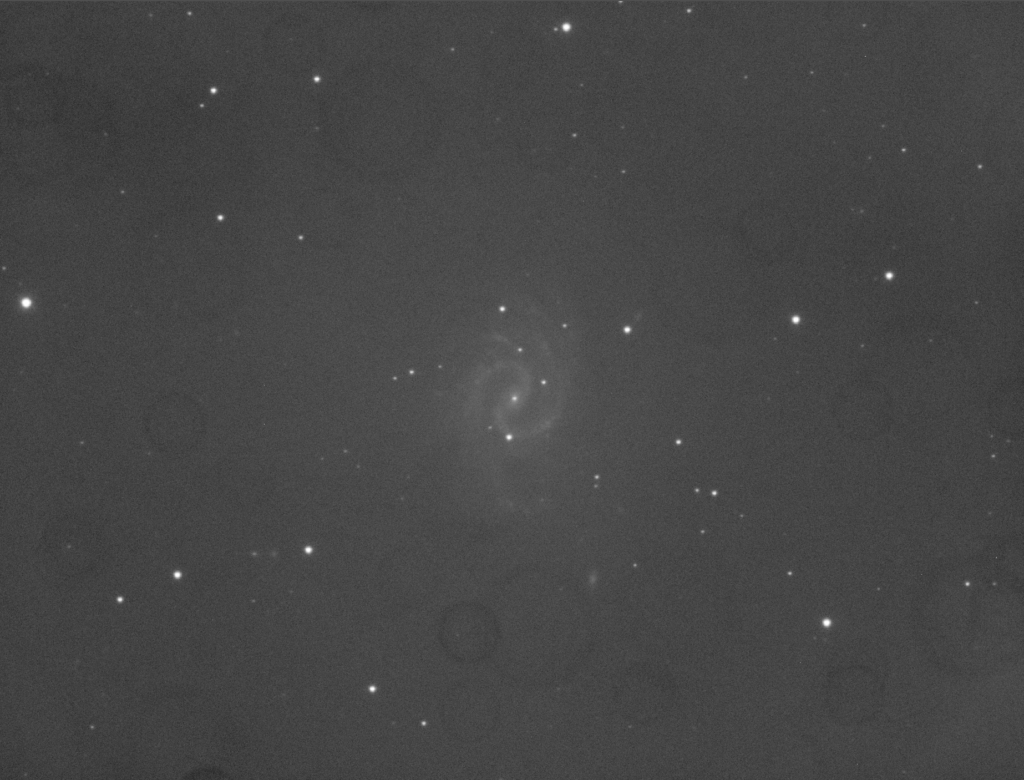
NGC4535 and NGC4565 were approaching the meridian so I did a flip to Praecipua in Leo Minor and then a slew to some nearby fainter stars to do a focus run. Start Focus position was 75542 at a temp of 14.14. After focus run the new focus position was 73335 HFR 4.7 98%.
Now slewed to NGC4565 and set a sequence of 12.5m (750s), 13.5m (810s), 14.5m (870s) subs going trying to establish where the limit is for unguided in these conditions. The first 750s sub was fine but the 810s was just showing a little elongation. I aborted the 870s sub and started a run of 12.5m (750s) subs going to see how consistent the results are … will need to look at these in the morning but I think this is about the limit and would probably back off to just 10m subs to provide a bit of a buffer.

Viewing time period – 20:15 – 23:46
TONIGHTS TARGETS
H56-1 / NGC2903-OS-Ha-300s x 12 – Done
NGC3395-OS-Ha-300s x 24 – no Ha so aborted
M94-OS-Ha-300s x 8 – Done
M85-OS-Ha-300s x 24 – no Ha so ignoring
Flats () Darks () FlatDarks ()
Camera Temp -26℃
WORKFLOW
Tonight we will take a bunch of Ha images for 4 targets we have been imaging recently with Ha data being provided through the 12″. I have selected the 4 objects in order of passing across the Meridian first. We should aim to get 2hrs of Ha in each, in which case we may need to take the rest tomorrow.
Auto focus run before dark on Ha using 20s subs @ 21:00 focus position is now 74,517 at focuser temp 15.84℃
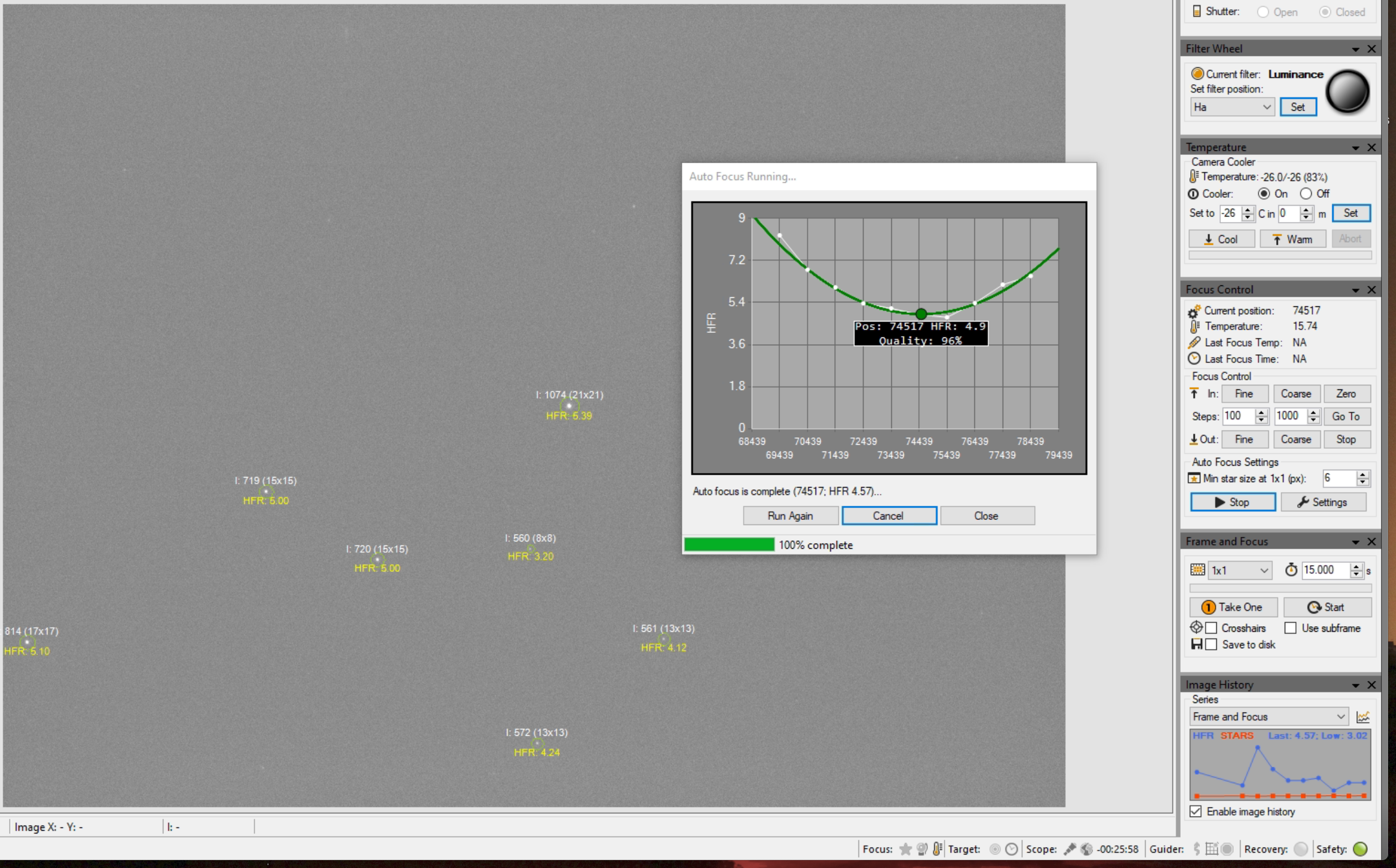
Autoguiding on 10s with one of the 2 stars in the FoV of the guider for OS12.
@21:17 started taking the first image. Noticed quickly the guiding in Dec went up, so stopped and recalibrated guider. Then started guiding on 8 second subs.
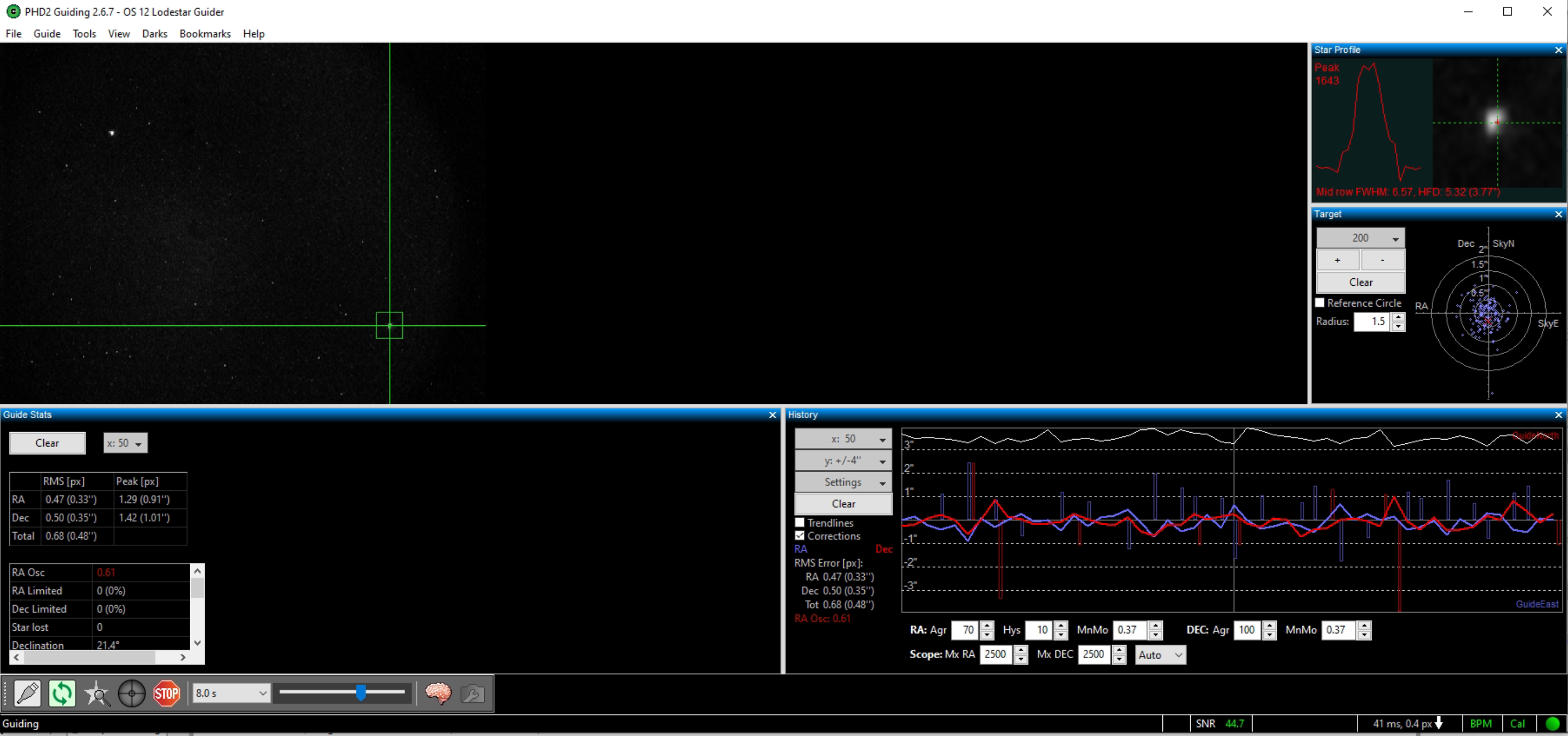
So the sequence is now running and taking frames of the first target in Ha NGC2903 aka H56-1.
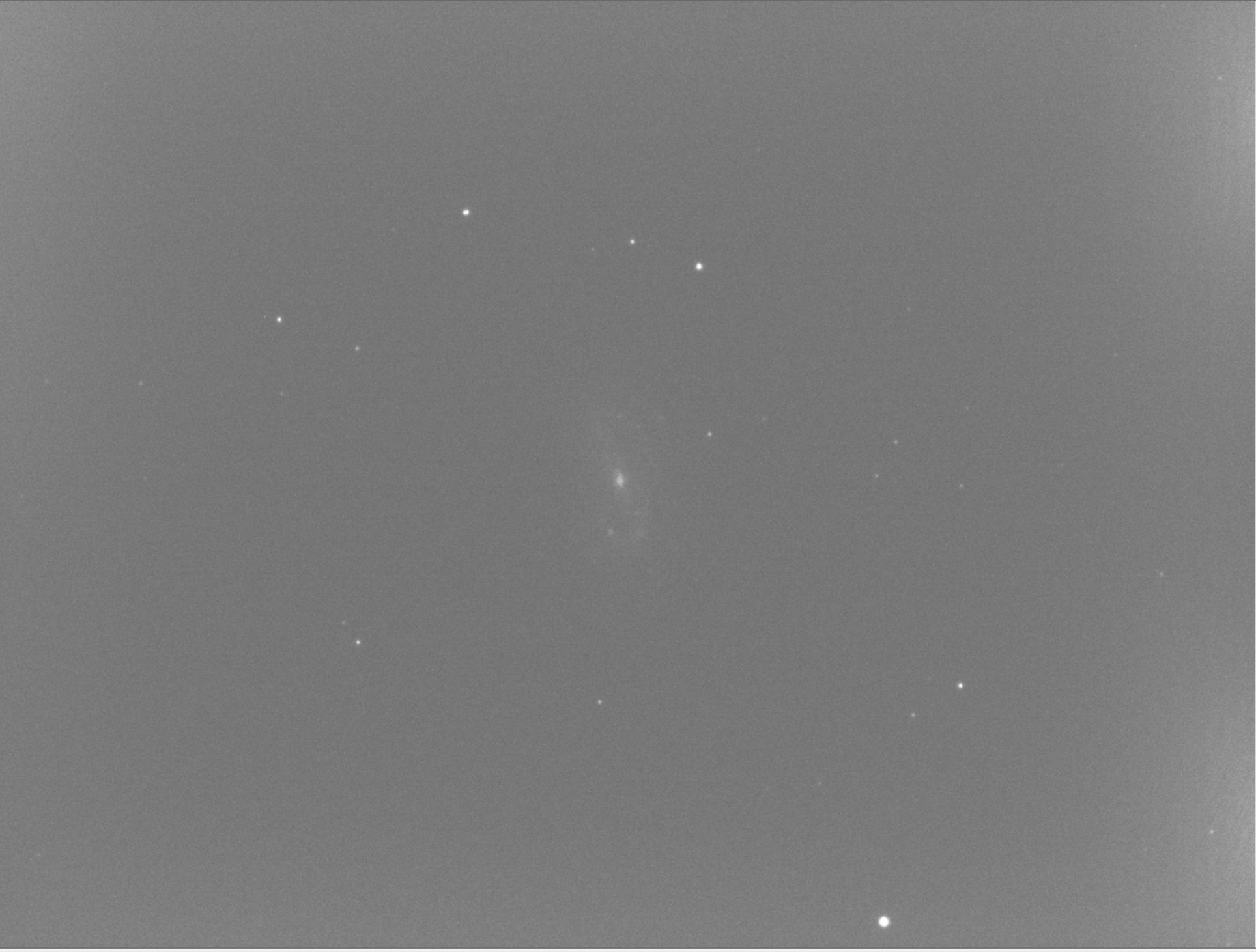
After 12 x 300 seconds on NGC2903 I slewed to NGC3395 and took the first Ha image, but unfortunately it was very dim so not worth pursuing. Instead I have now switched to M94 which is currently on the East side of the Meridian. I will take 24 x 300 seconds Ha with no guiding. It will require a meridian flip in about 90 minutes. I will then leave Bob to complete the Ha on M94 for the rest of the night as M85 does not have any Ha within it.
Bob continued and had a little success, cloud rolled in at 23:46 so frame 9 onwards are no good so we got 8 frames in total for M94, we will continue another night. The shutter was closed as Bob did the meridian flip due to cloud.
I tried to take calibration frames the following day at 7pm when the outside temp was 15.5℃, the inside was 18.5℃ but the ASI camera on the OS12 would not get lower than -25℃. I now concur for with Bob and GingerGeek that we should lower the cooling temp to -20℃ for the remainder of the Spring and Summer returning to closer to -30℃ in the Autumn / Winter. For now I had to wait for the temperature to drop outside and thus inside to cool down the final 1℃ to take the calibration frames. By 20:22 the temp outside had dropped to 12℃ and the internal temp to 15.8℃ which was enough to cool the camera to -26℃.
Viewing time period – 21:16 – 23:24
So first I could not see any USB devices that were plugged in to the USB hub on the mount. A reboot of the mount fixed that problem. Next I could not auto focus, I did not get to the bottom of that so tried to focus manually best I could. Then PHD2 settings were wrong for the OS12 and the associated lodestar guider, the calibration steps were 100 rather than 400, the min move was 0.66 rather than 0.18. I had taken screen shots before on the blog so changed them back, I am not sure why they have changed. I then managed to calibrate the guider on the OS12, given I have taken off the camera to clean the filters the other day.
@22:15 I started imaging RGB on M94 on the OS12.
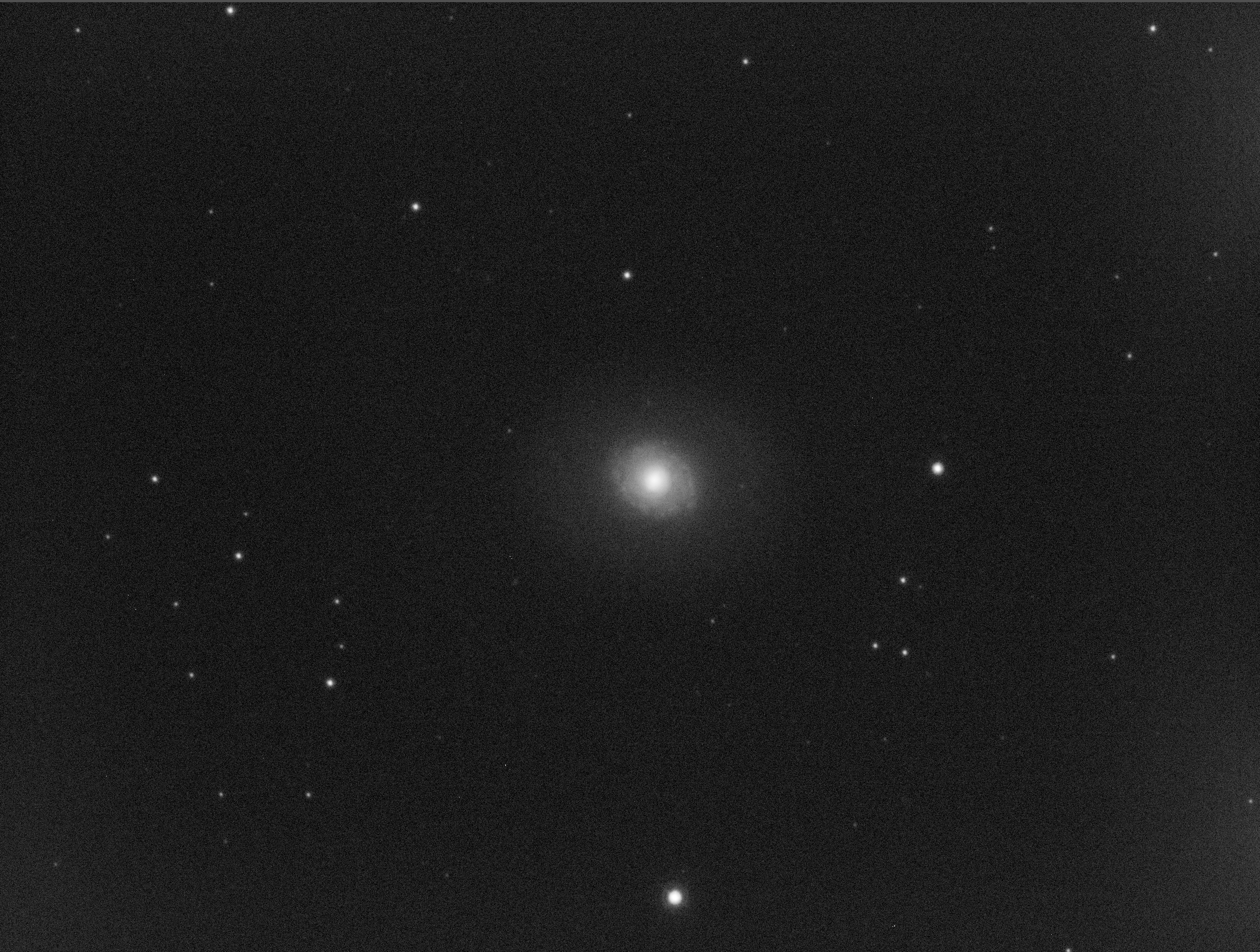
The guiding was not bad after calibration. I set to expose once every 8 seconds on the only guide star in the FoV.
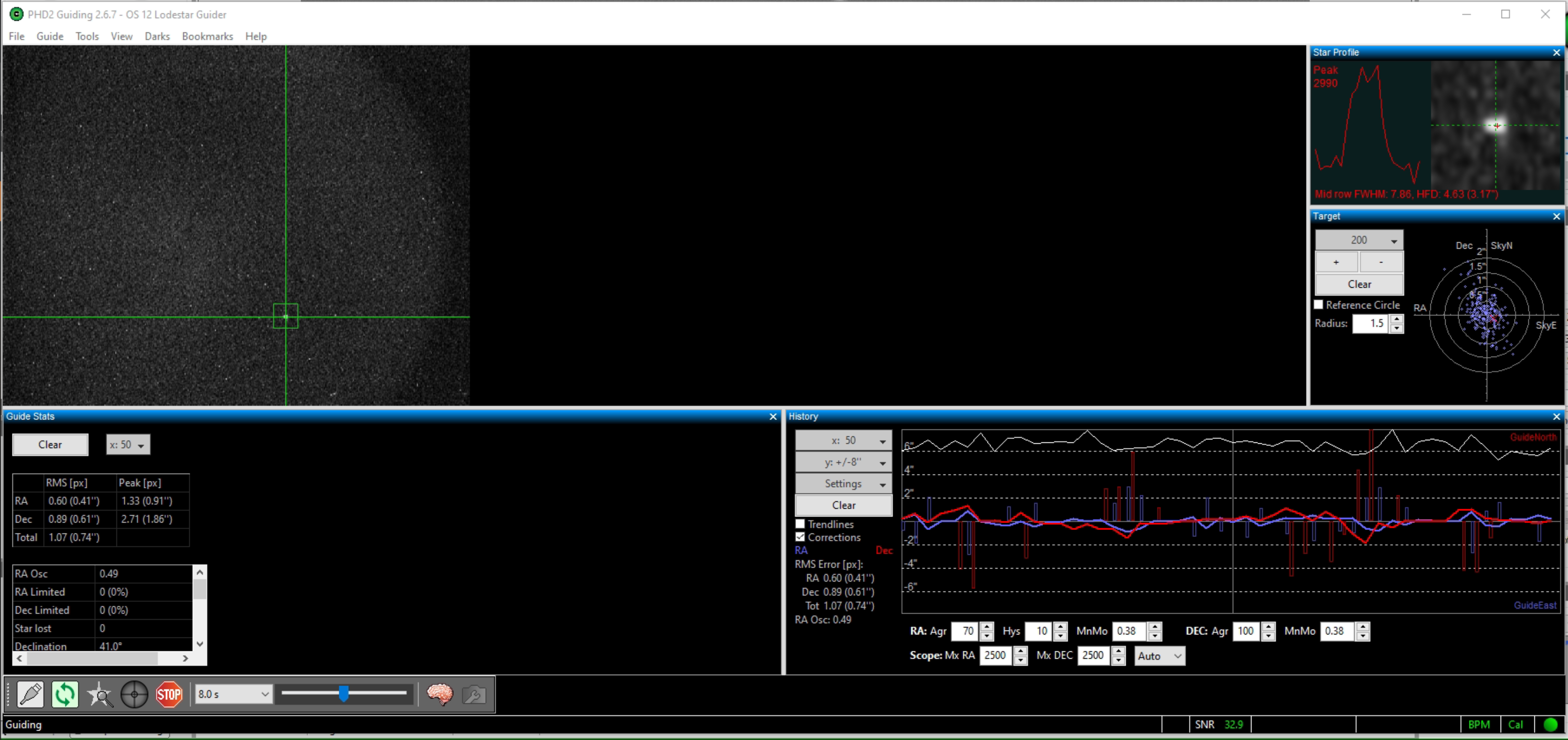
What I do need to do is set the FoV indicator in TSX for the Lodestar guider to the correct position to help find a guide star. Else I really should try to guide with one of the other scopes. I am now off to bed, I will leave the scope collecting the rest of the green, 2 left and the final 12 blue. Then Bob will take over imaging for the rest of the night.
Bob took over Green which lost the guide star, so he performed a meridian flip, continued on the Green and then took some Blue. Bob then took some HA, OIII, SII at 5 and 10 minutes for a test. The Ha would be useful for the galaxy as an LRGBHa image. Bob turned in at 2:50am.
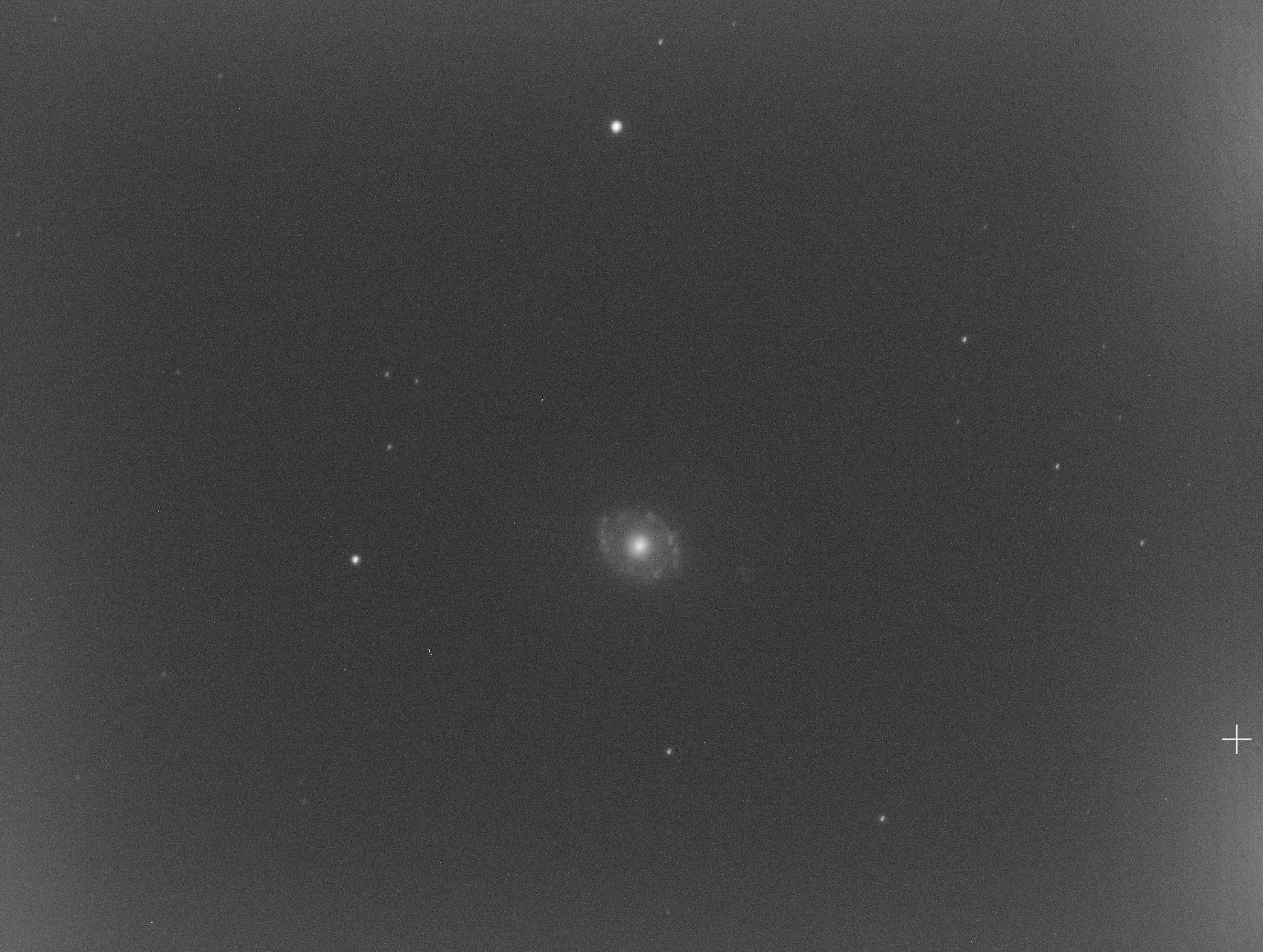
I also noticed this morning that the Offset was wrong in the ASI camera profile which was called ZWO camera in the dropdown and in fact was set to 50 rather than 21 for this Gain which was correctly set at 139. I have also changed the OSA12 No Guider profile to use the ASI2 camera rather than the ZWO one, not sure the difference. I have adjusted the setting back to 21 so all the OS12 profiles now use Gain 139 Offset 21 as their standard. If we want the other 2 setting that need changing for each time we run, along with subsequent darks and flats etc would be Gain 0 Offset 10 and Gain 75 Offset 12. For the moment the Darks and Flats etc from last night are Offset 50 so we can only use for last nights images.
Viewing time period – 21:19 – 23:23
Slewed Tak to M53 started to take colour frames. Clouded up around 11pm so shut dome and took darks, flats and flat darks.
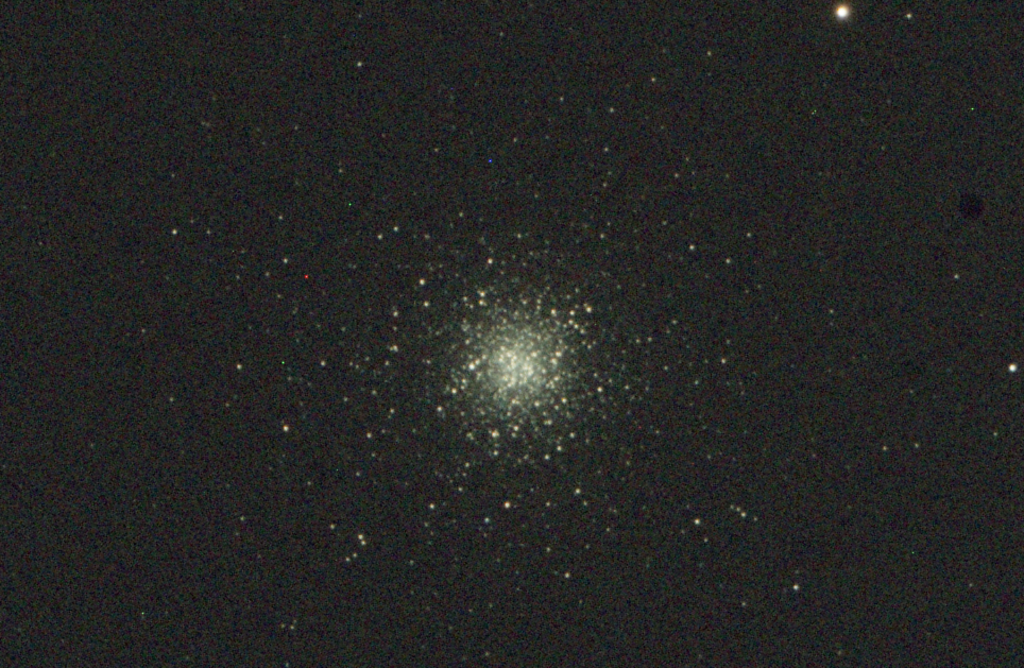
Viewing time period – 21:02 – 04:21
Started TPointing at Point 153, at 22:00 got to Point 231 which gave us 192 confirmed points.
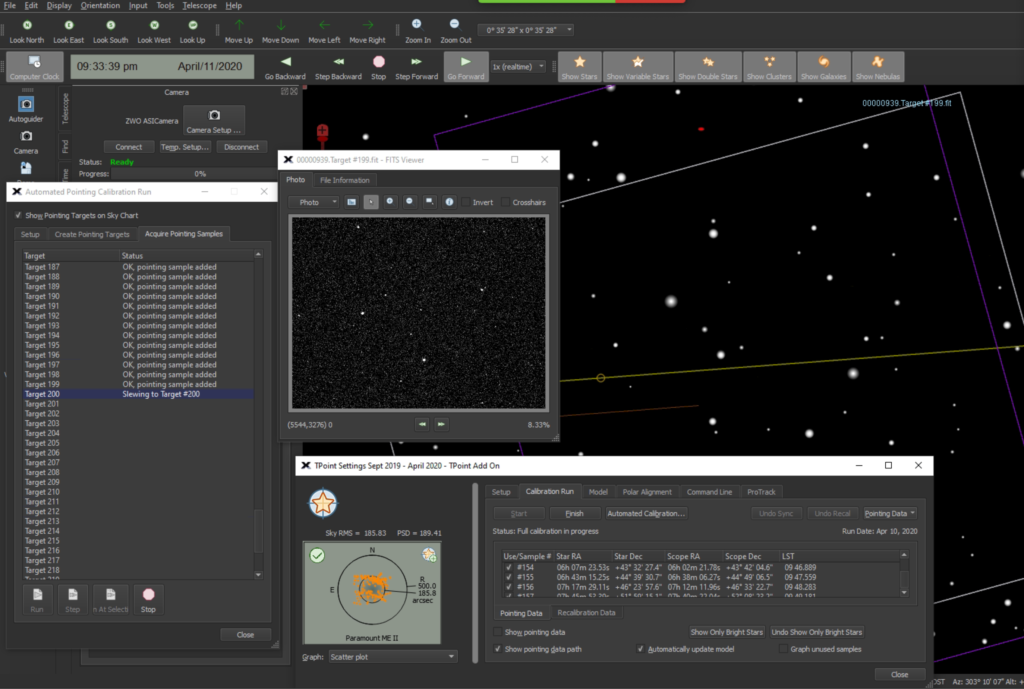
Then went back and did the following points
Point 28 (DONE)
Point 50-55 (DONE)
Point 60 (DONE)
71-92 (DONE)
100-153
101-106 (DONE)
Failed – 107, 108, 112, 113, 130-132,134
Not tried – 100,109-110, 114-118
Completed – 111, 119-129,133,135-152
We had some cloud around 22:45 until 23:29
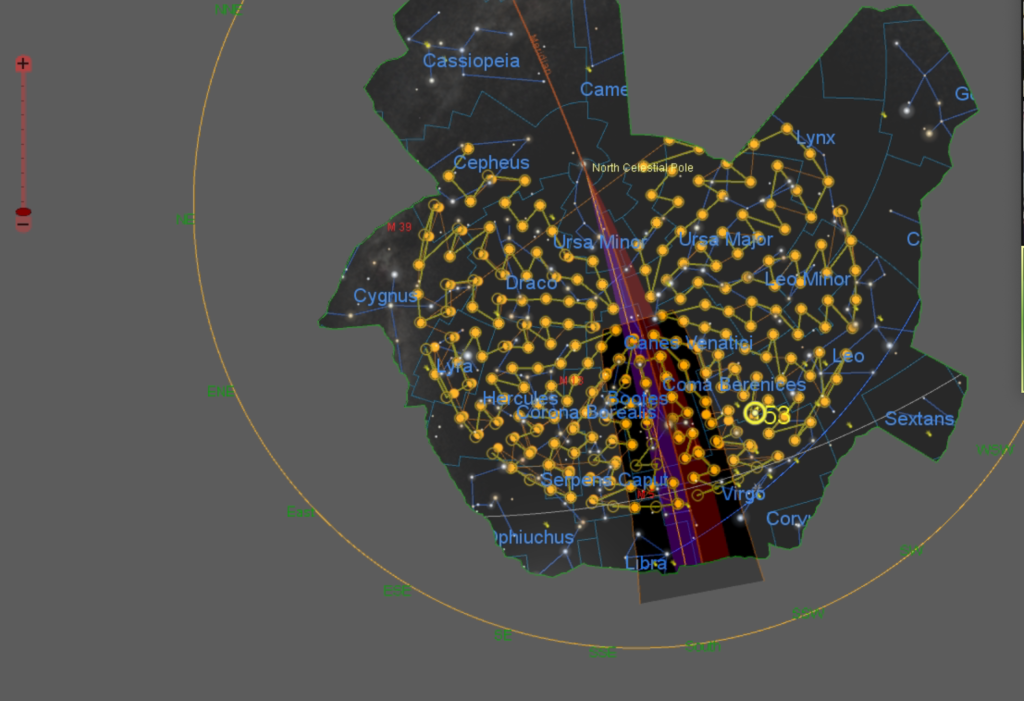
Throughout this time I processed some Lunar images on the Windows laptop with AutoStakkert from the previous few nights of imaging through the Mak 180. I have noticed you cannot open anything larger than 4GB file size !!

@1:52am TPoint finished
@2:09 GingerGeek took over to look at focuser positions and backlash and autofocus on the Takahashi FSQ102.
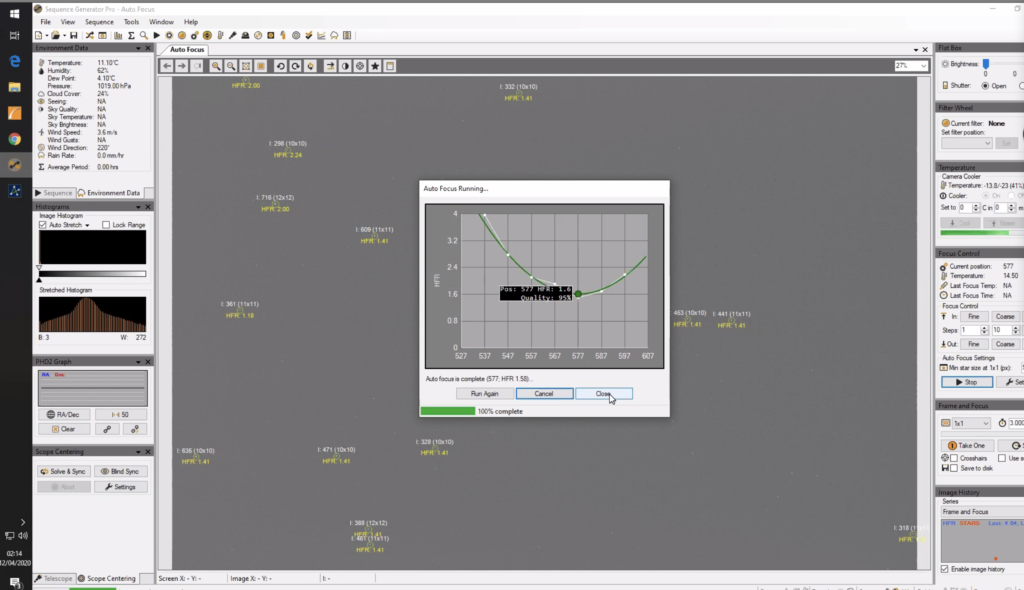
Then we started to image M53 on the Tak for RGB data to add to the Luminance data we already have from GingerGeek’s data on the Esprit 120ED.
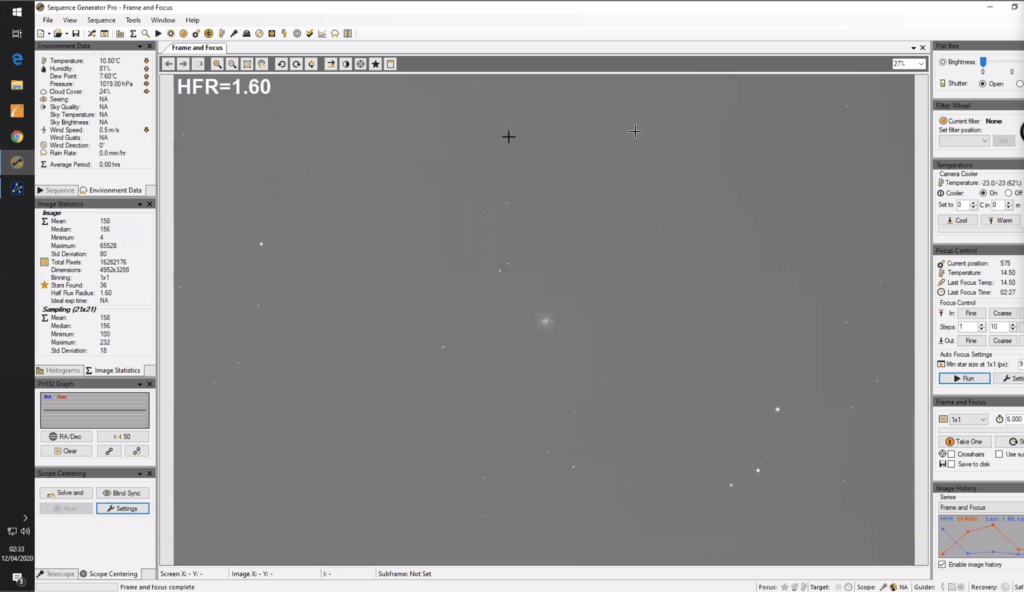
Tomorrow I will need to look at the TPoint model to refine it!
Addendum ……
So I took a look at the TPoint model and could not get it below 109 inner circle and 200 outer circle without removing a lot of points. So I posted question on the Bisque Sky X forum.
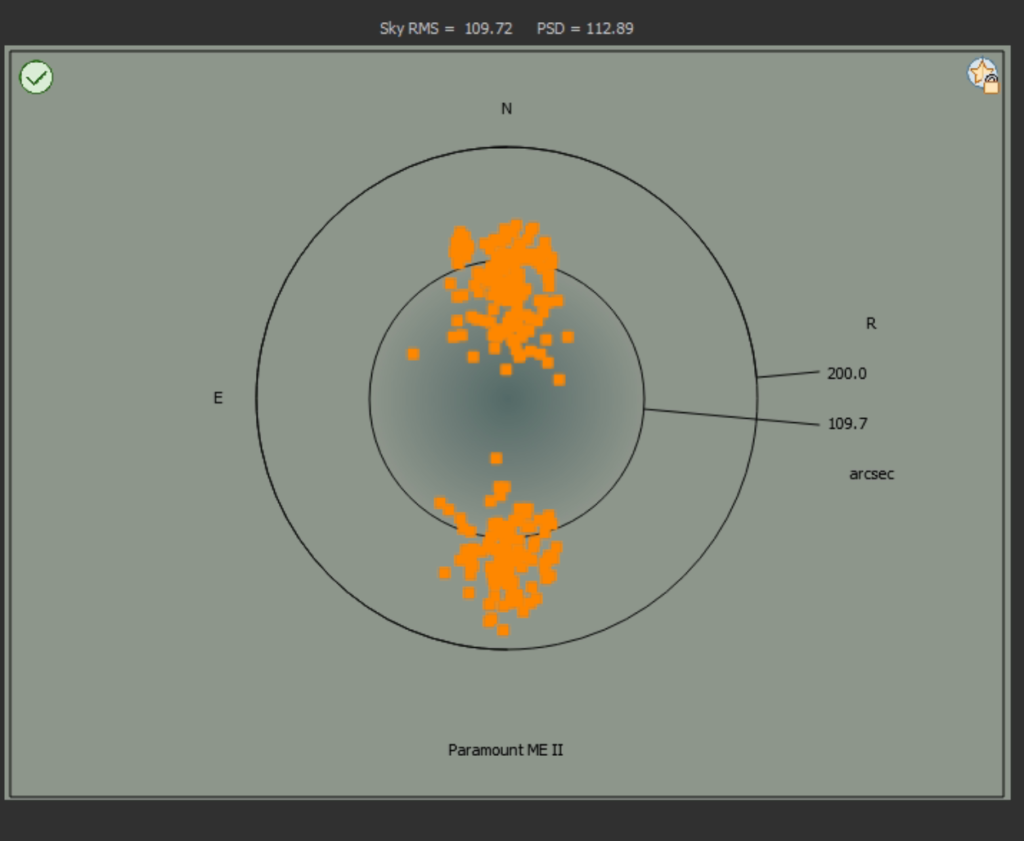
They came back and stated there is something loose in my imaging train or the mount. There is nothing wrong with my imaging train so instead I performed adjustments on the worm gear as they suggested. I will now need to re-TPoint to see if this makes a difference.
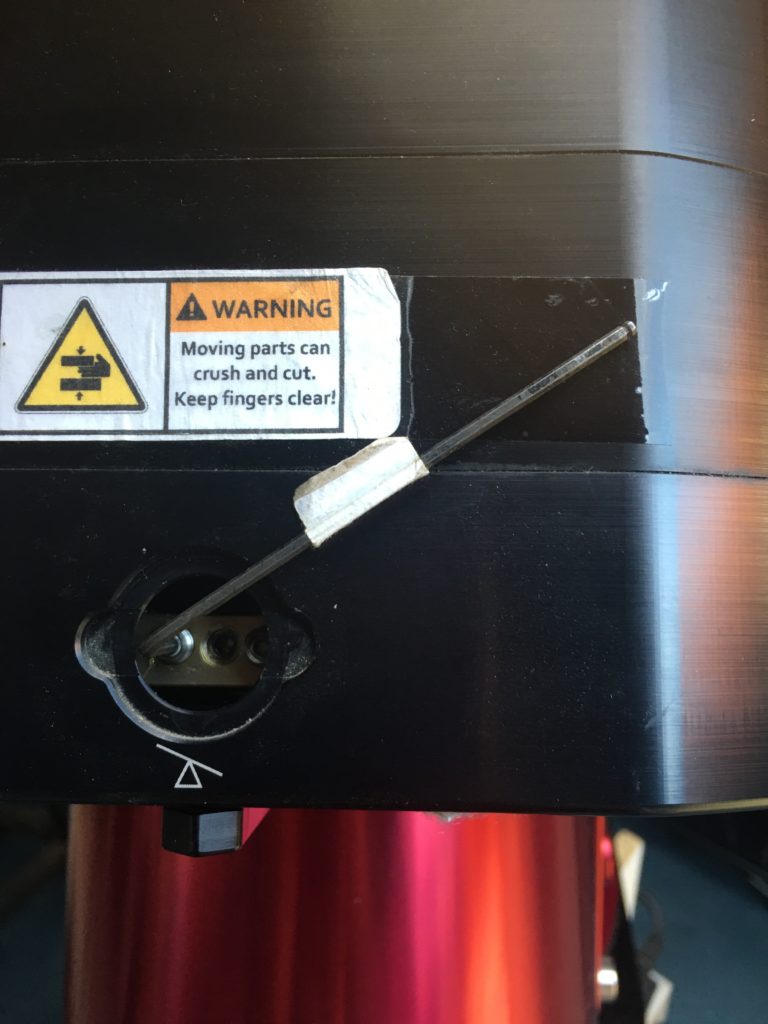
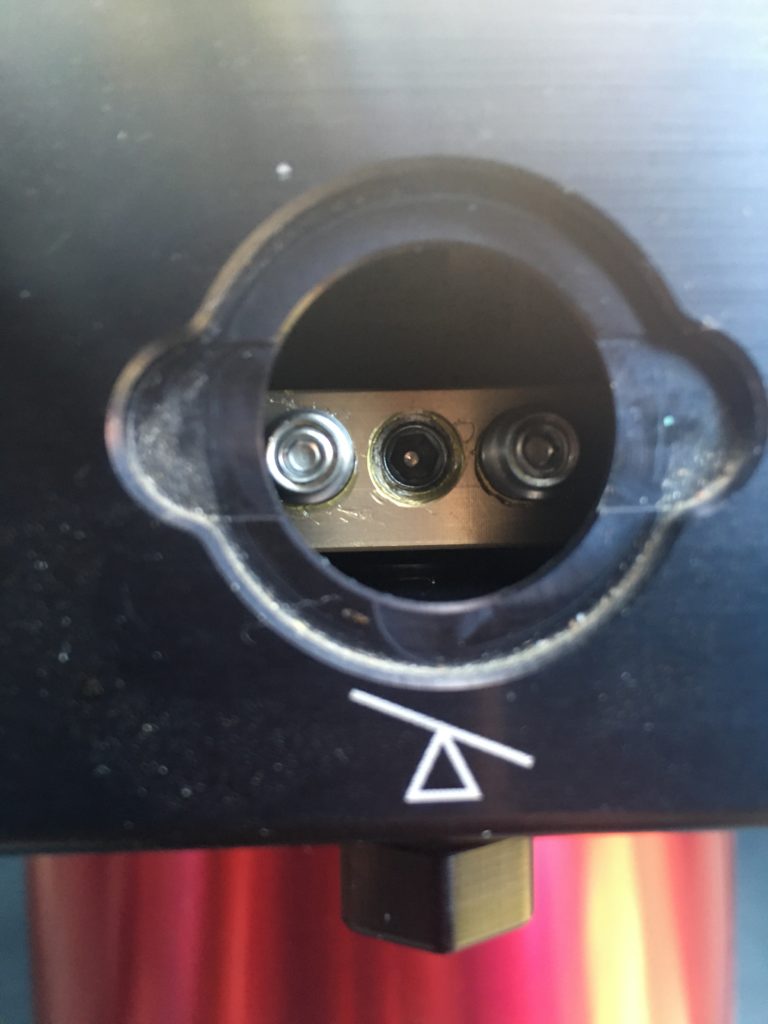
Viewing time period – 18:56 – 00:59

So early on as always I opened the dome to cool down. Tonight Bob, Gingergeek and I want to image Venus in the Pleiades. Even before it got dark and as I slewed the telescopes to Venus, it was visible straight away so I took a quick image, 0.001s from both the 12″ and Bob’s FS102.
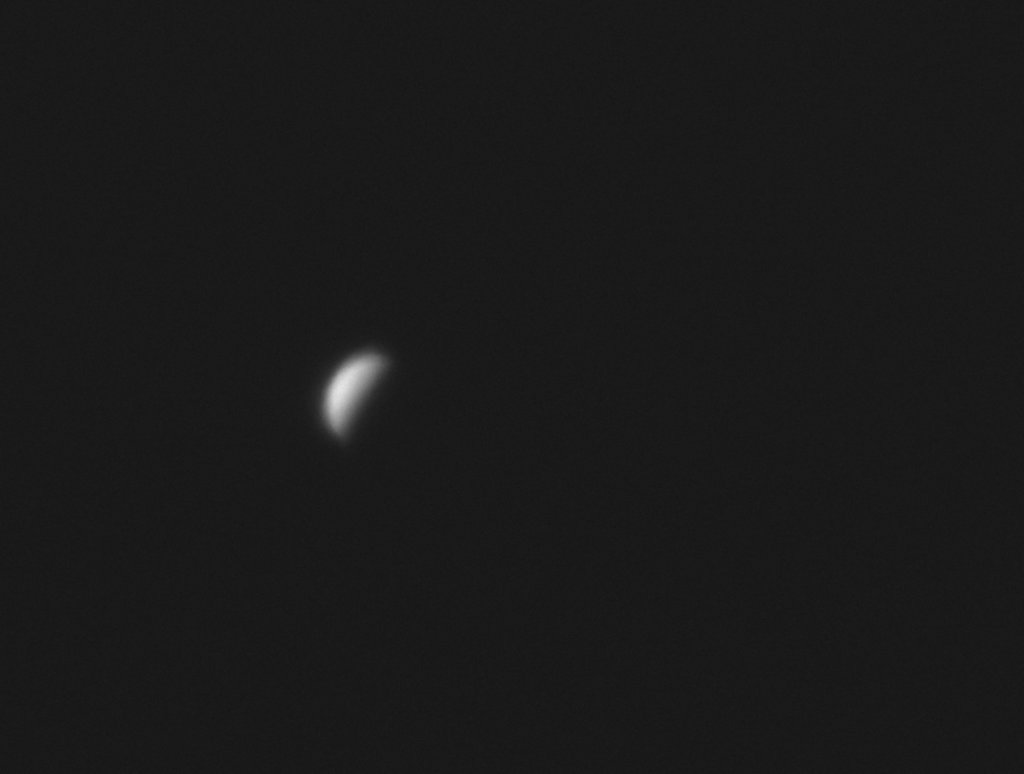
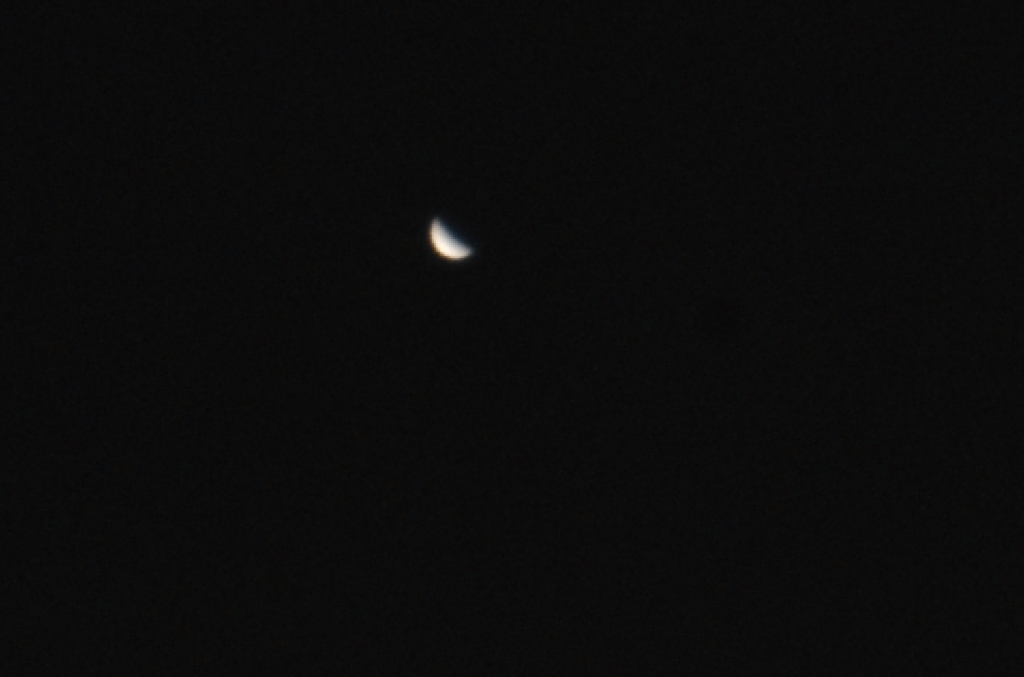
I then went off to watch TV with Helen whilst Gingergeek and Bob grabbed some more images of Venus.
Around 10pm I re-joined Bob and GingerGeek and we set about imaging Venus as it passed by M45 Pleiades in the Tak FS 102. We then went on to perform autofocus on the Tak followed buy setting up the autofocus on the Esprit 120ED
Before the clouds decided to put a stop to play, we took some images of M53 the globular cluster on the Esprit around 00:10am using the Luminance filter.
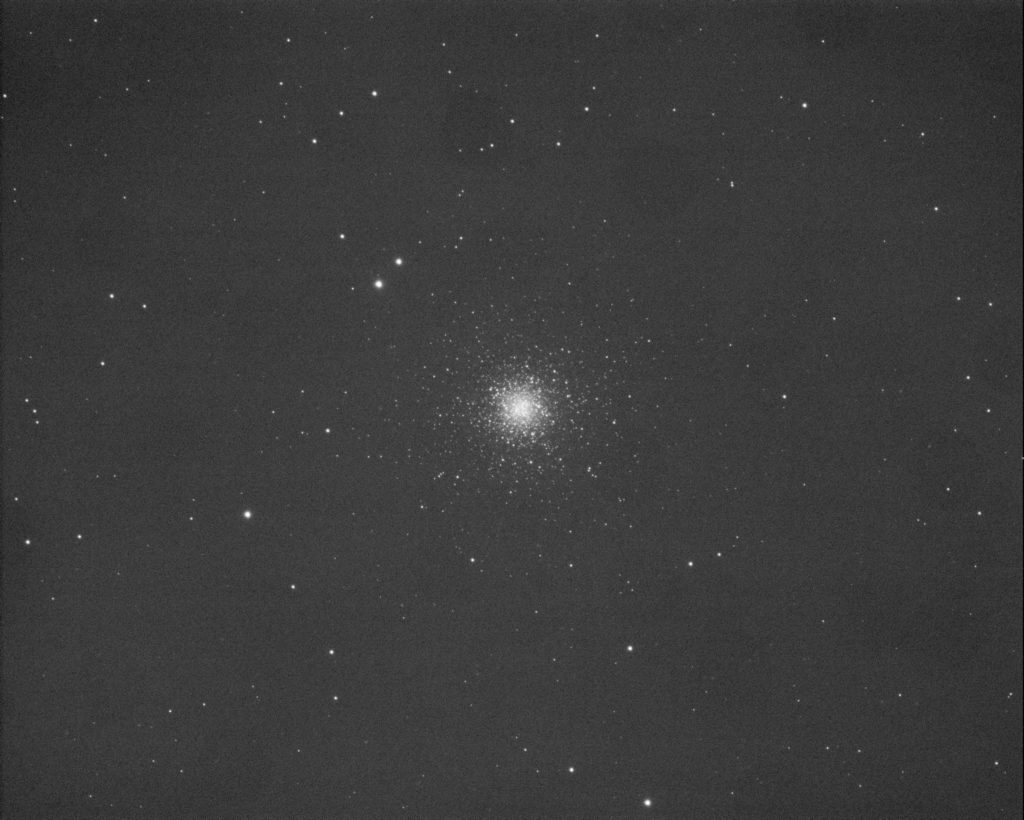
By 00:59 the clouds finished play 🙁
Viewing time period – 17:18 – 02:07
Cooling down telescope ready for tonights viewing

M94 and NGC 3395/3396 are the 2 targets for tonight, some luminance on M94 and RGB on NGC 3395/3396 if I get enough time. I always try to open the dome early to give at least 2-4 hours cooling before I use.
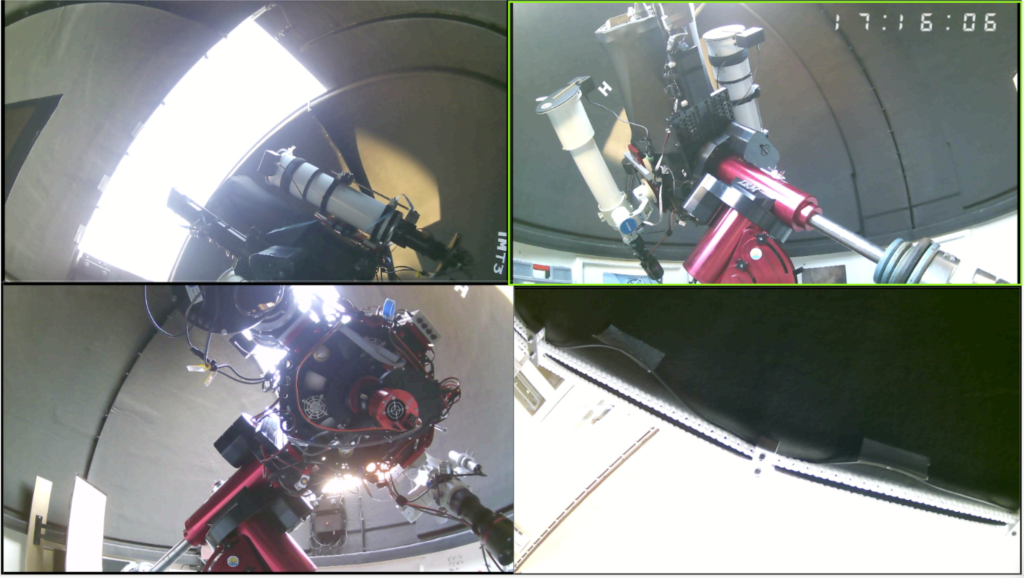
When I was about to start with autofocus I tried to recenter back on the target but the mount respond and it transpired that the mount thought it was out of balance. I went to the dome and the mount was beeping proving it was out of balance. So I turned the mount off, manually moved the scopes pack to the park position and then turned the mount back on and all was well.
@19:57 I performed the autofocus for the night on Luminance which scammer in at a position of 75282 on the focuser.
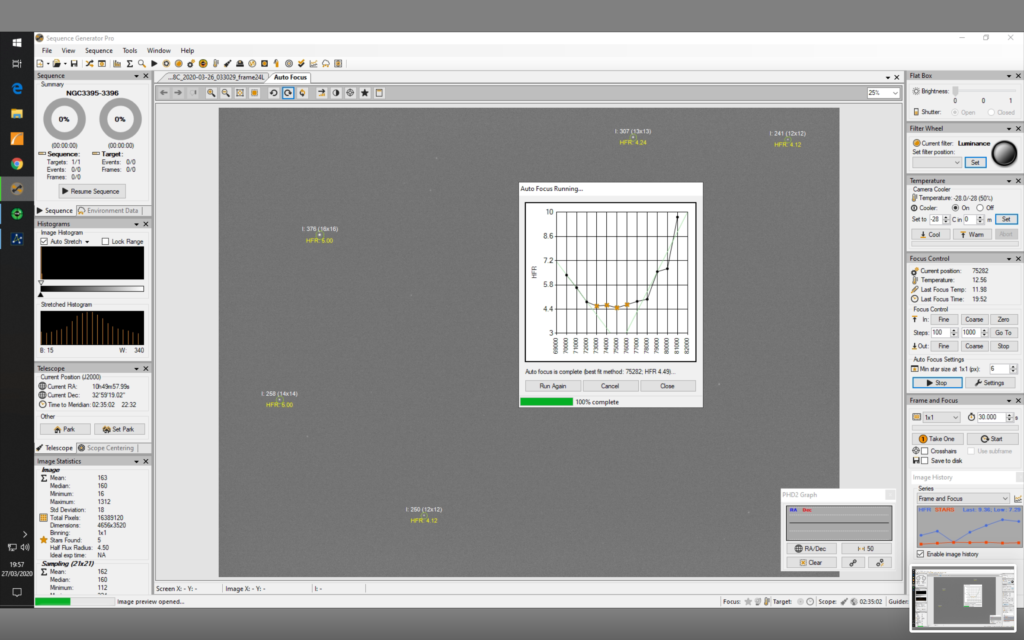
@20:10 I started an imaging run of 24 x NGC 3395/3396 with Luminance filter. Once done I planned on grabbing RGB frames before moving on to M94.

@22:32 I started on the RGB frames for NGC 3395/3396 after refocusing on the Red filter.

@1:40 I slewed to M94 and changed the filter to Luminance. I performed a refocus and shifted from 77895 to 75884 on Red filter by accident. So we (I had Bob on Zoom by this point) refocused on the Luminance and the new focus position was 74884. So the difference is 1000 for Luminance to Red. I also changed the step size for the focuser temperature compensation from 531 to 431 to see if the HFR is more stable.
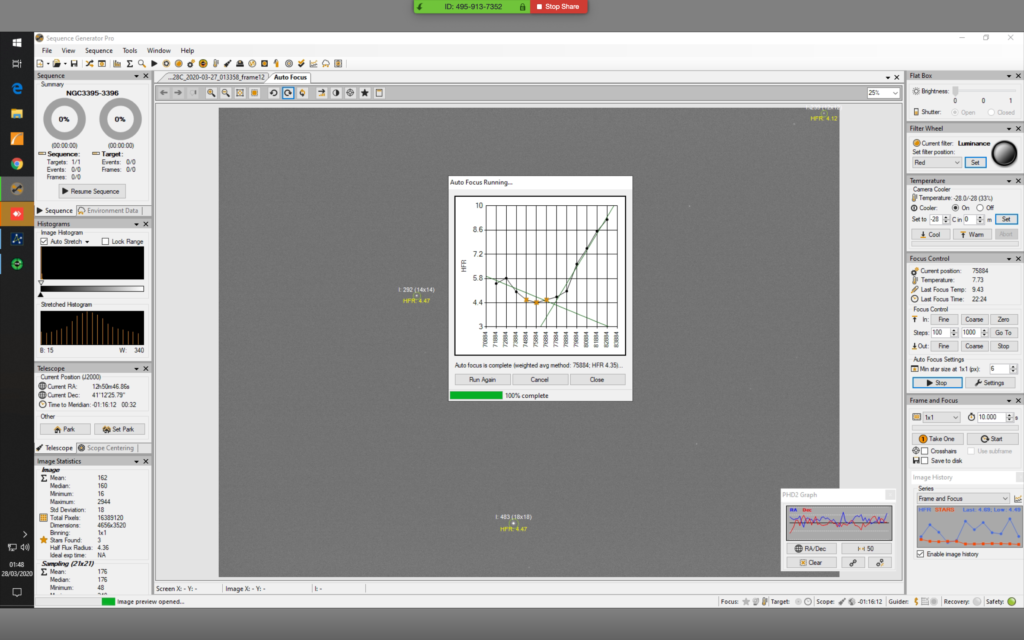
I noticed tonight that PHD2 lost the Use Direct Guide check mark twice and thus complained about pulse guide not being supported. I had to stop guiding, disconnect the mount in PHD2 and go into the settings, check the Use Direct Guide and reconnect the mount and start guiding again. Something to look into possibly.
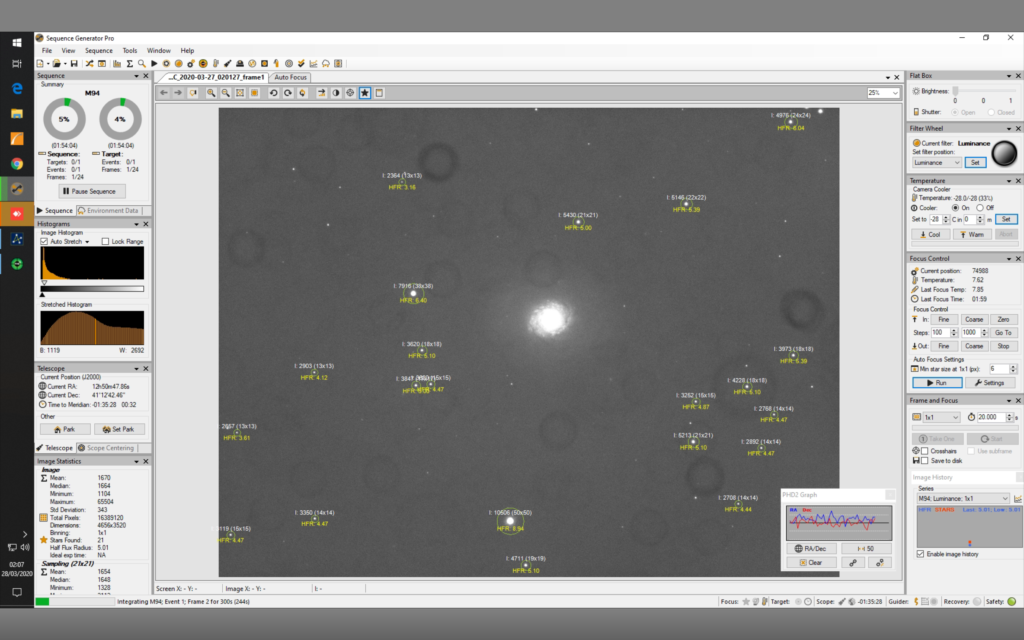
@02:07 I went to bed and left the scope gathering another 2 hours of Luminance data on M94.
Addendum …….
The following day I took the ZWO ASI1600MM CMOS Camera off the back of the 12″ and cleaned the sensor window. What I found was the dark dust doughnuts disappeared and the rest for the doughnuts were actually on the filters.
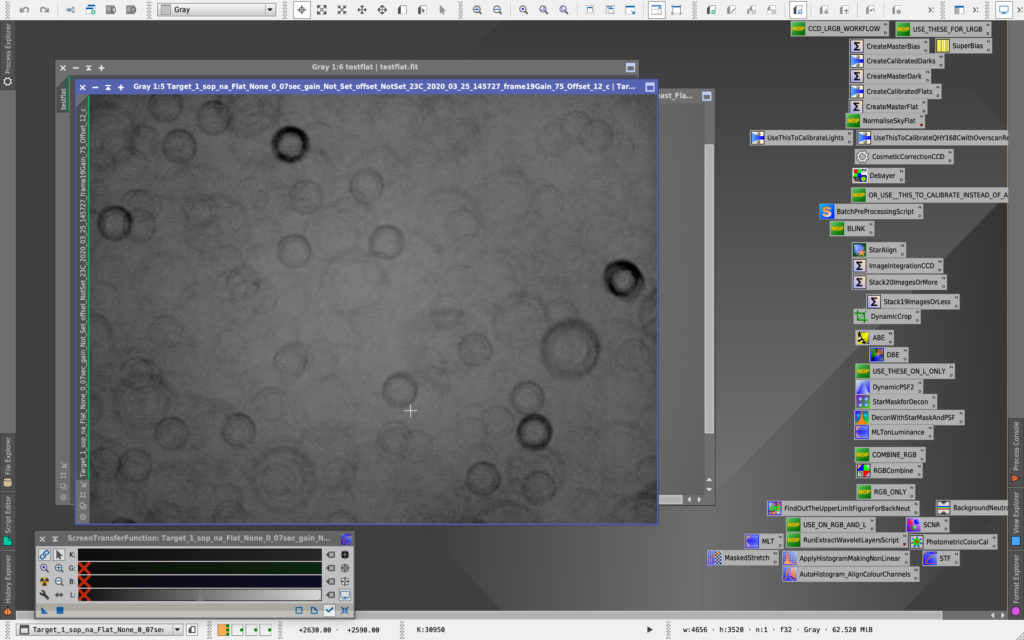


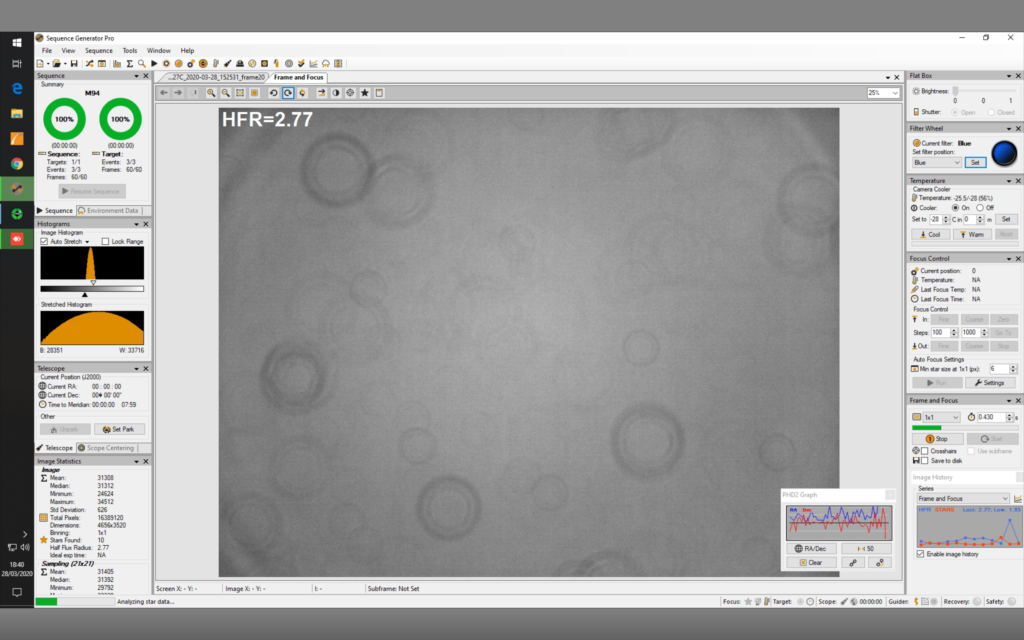
Things to still resolve……..
Viewing time period – 18:16 – 01:43
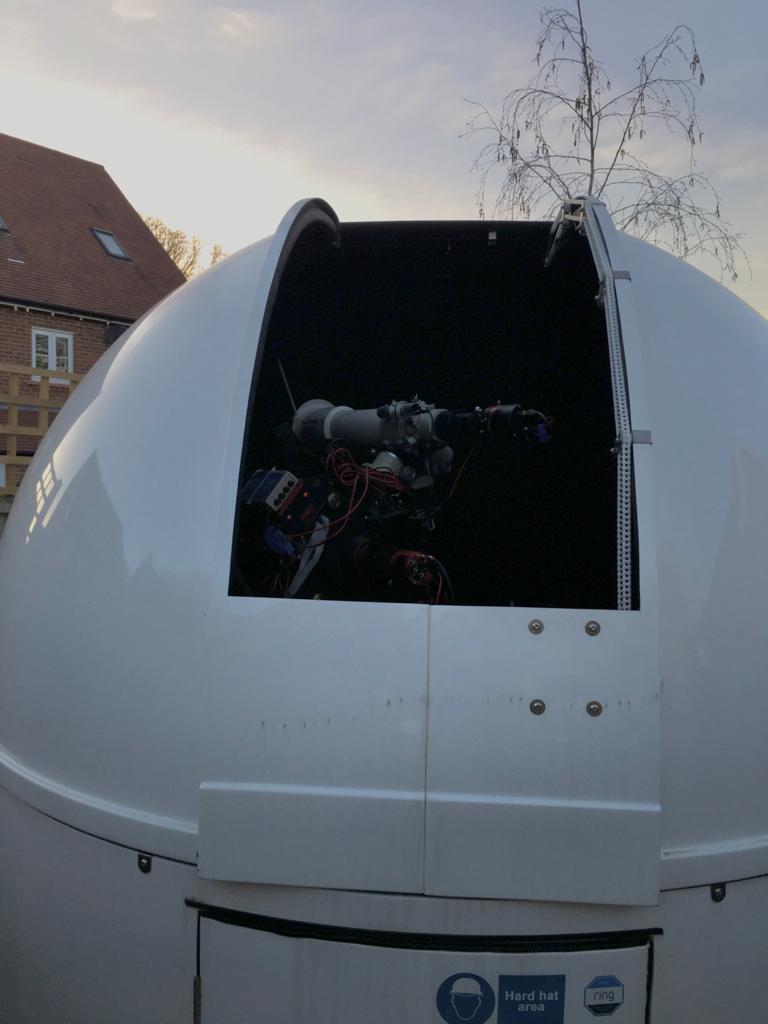
Tonight I plan on setting the 12″ imaging M94, a Messier galaxy in Canes Venatici.
I slewed to nearby star and focused using SGPro after changing a couple of settings in the step size and amount of data points to be used, I set step size to 100 from previous 1000 and data point to 5 from previous 10 and got a much better focus. Focus landed up first time around at 738840
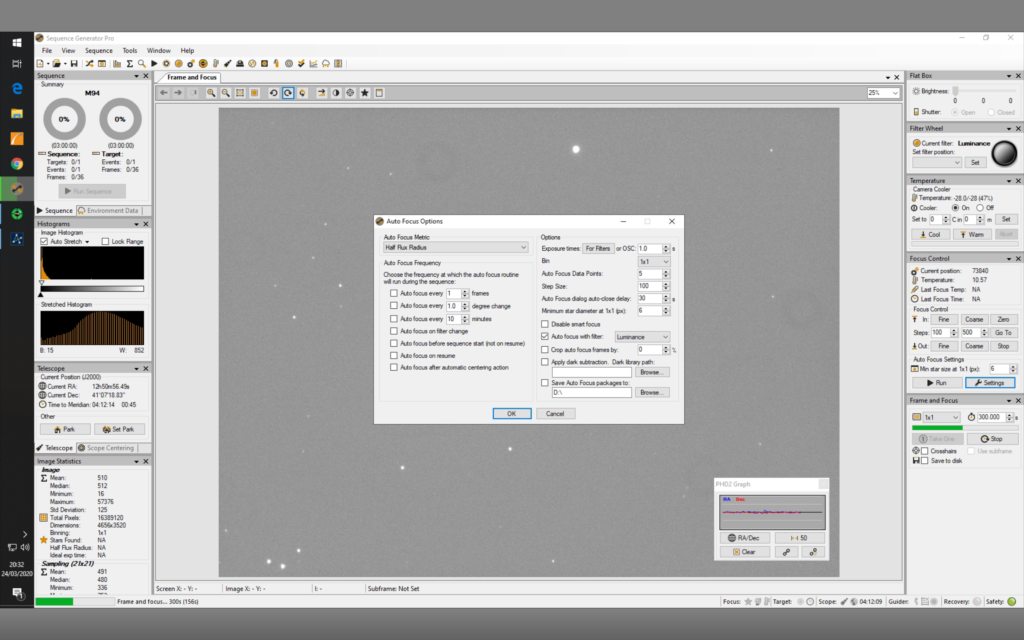
I had tried to get @focus working in TSX but it would fail every time on the galaxy with not enough stars. This meant I could not use TSX to solve and sync to centre M94.
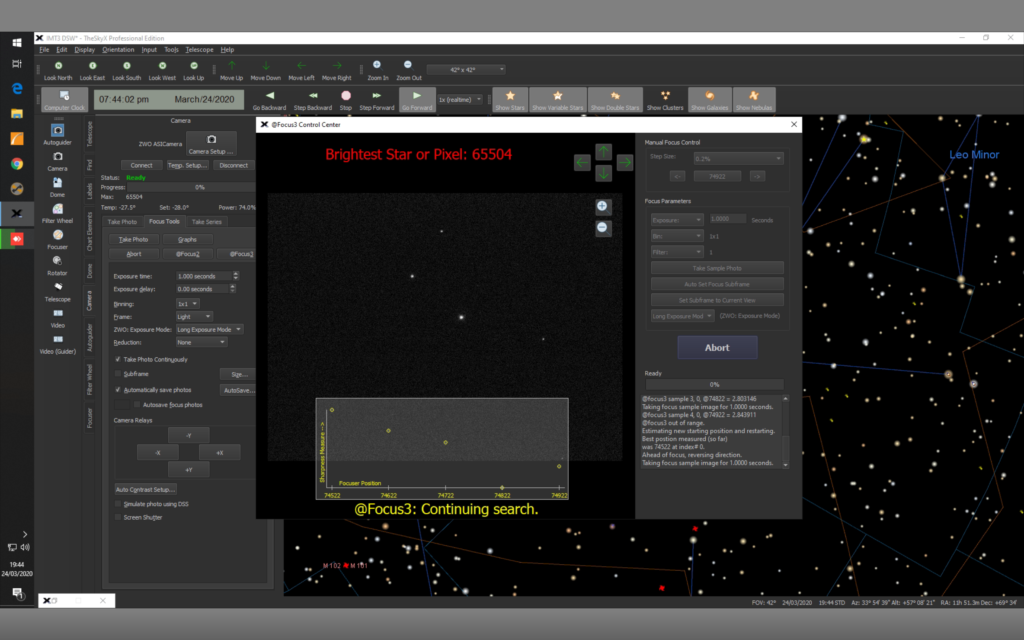
I then tried to centre with SGPro and that also failed so instead I used TSX to connect to the camera and manually moved M94 to the centre of the chip. I ned to get the local plate solver working as it was not running.
@ 20:32 I took an initial 5min sub to see what the image would be like after setting PHD2 guiding running.
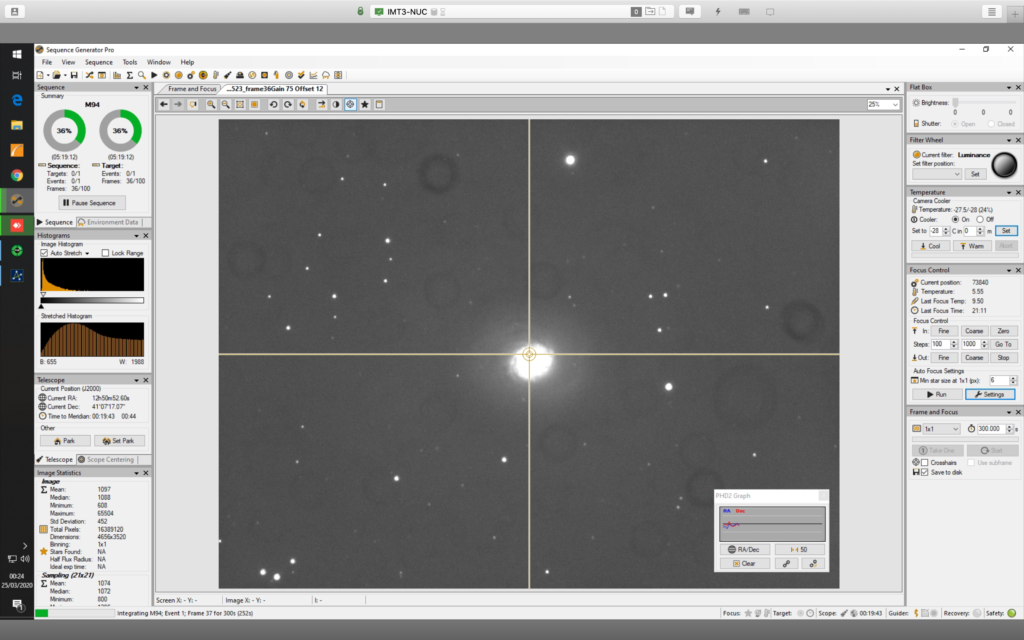
@1:20 and after gathering 3 hours of data I moved to other side of mount so meridian flip. I refocused as it had drifted a lot. I now need to consider setting up focus move for temp as the focus shift is dramatic. I also changed PHD2 Hysteresis setting to 0.20 from 0.10 as the PHD was having problems guiding.
I struggled to find guide star and landed up exposing for 15s and then having to increase, possibly needs recalibrating on this side of the mount. But also I need to find a brighter guide star by moving the mount offsetting the galaxy. The other way is using one of the piggy backed scopes which I may do next time.
@1:43 the dome closed, not sure why, might have been high cloud but probably because the WSX software lost contact with the WSX hardware. I did a reset and reconnected and then it was fine, but as the dome had closed I packed up with 3 hours of Luminance data on M94. I now need to take flats on the morning.
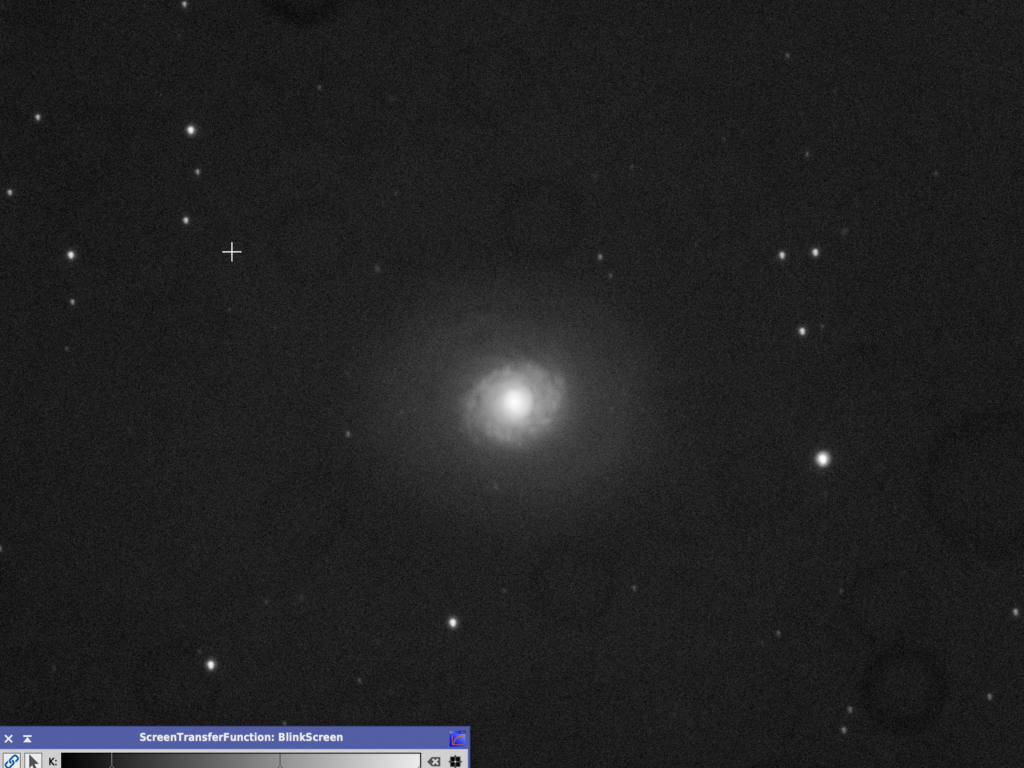
Learning’s for next time……….
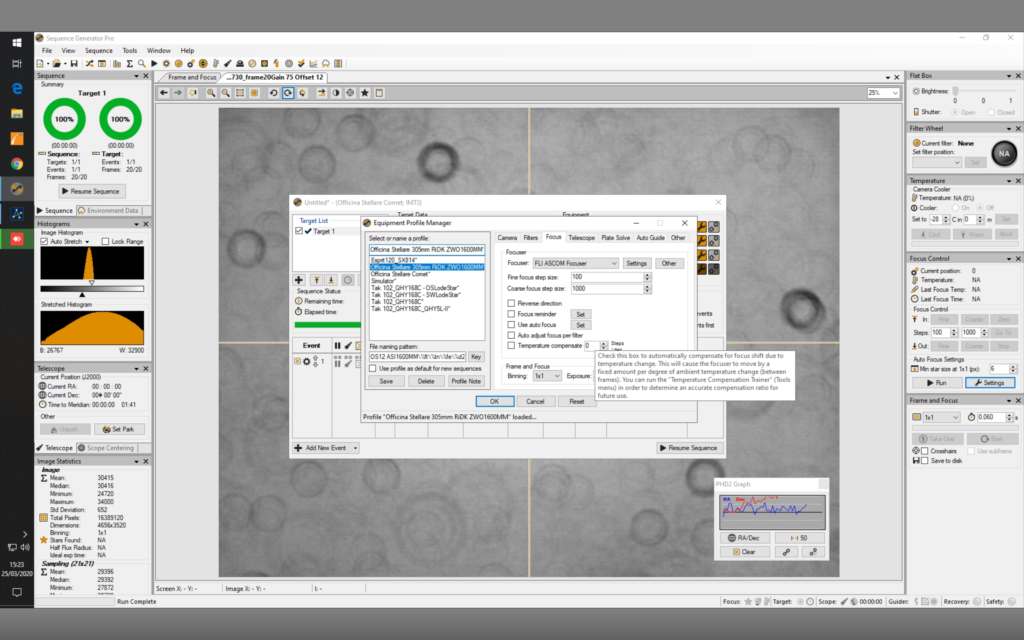
Viewing time period – 17:43 – 17:48
EXOPLANET – HAT-P-20b
Slightly hazy right now but I have opened the dome up and turned the cooling fans on the 12″. Slewed to Atik, a mag 2.8 star in Perseus and aligned the scope.
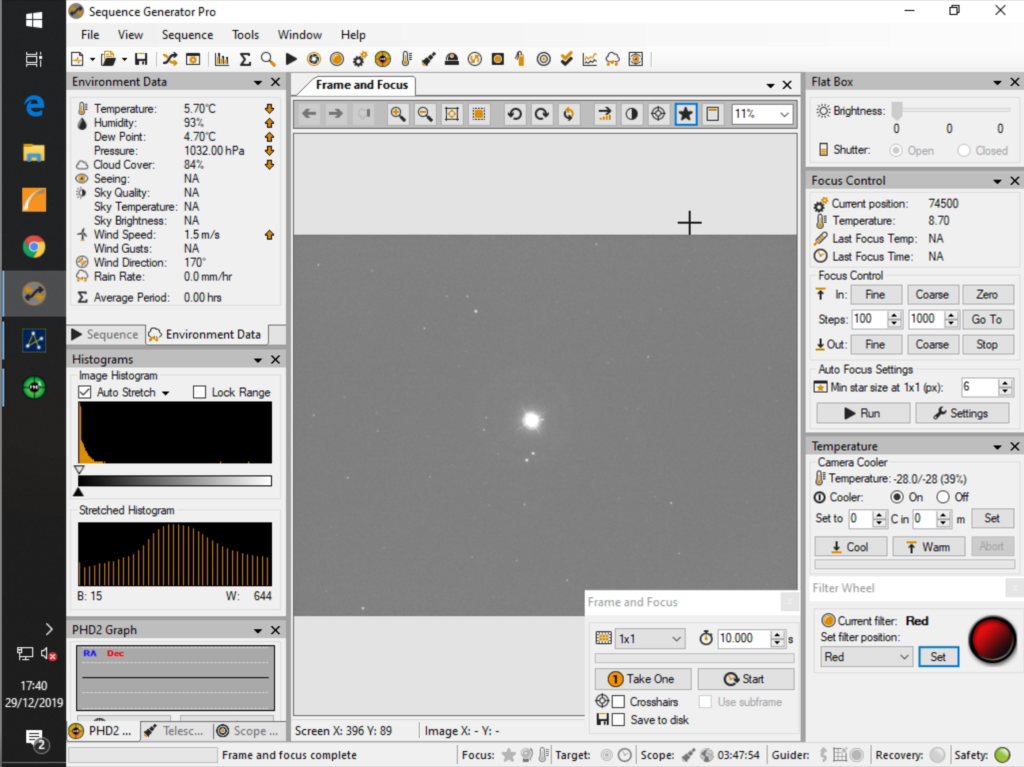
So the star was almost in the centre when I slewed the scope to it, a slight tweak and now synced on it centrally. The Hitec Astro weather station reports slight haze
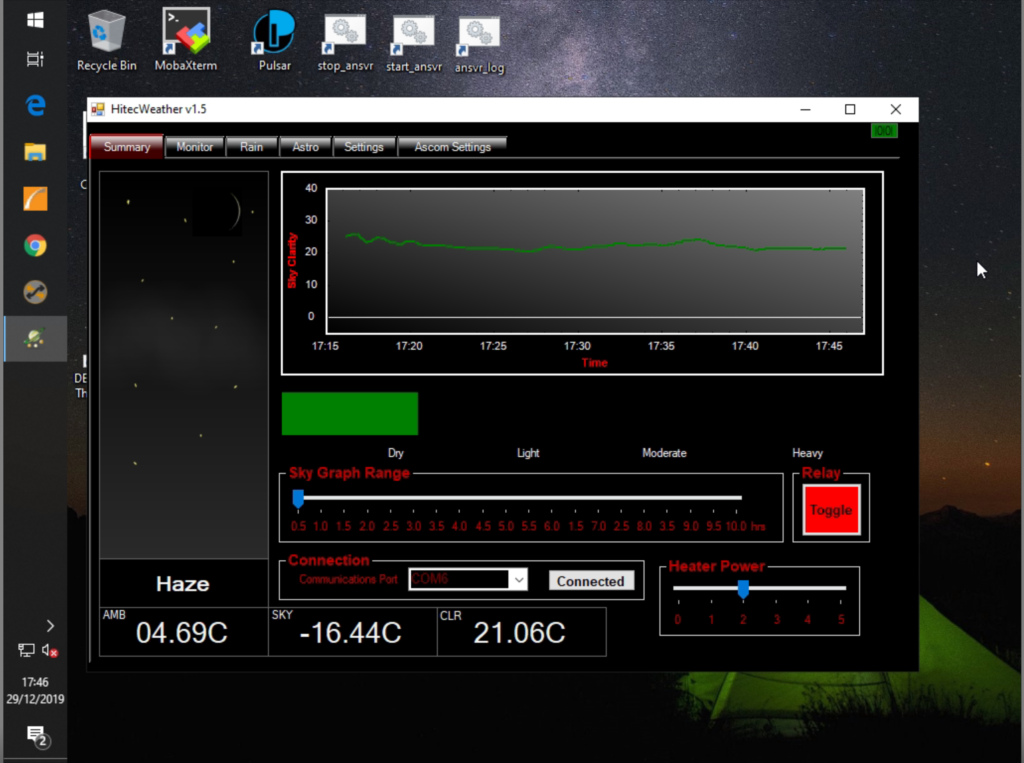
Gingergeek installed a new Intel Windows small form factor computer recently in replacement for the RPi so we could run the AllSkEye software and see if the loss of one of the colour channels was software or hardware. Here is tonights image, which still needs colour calibrating during the day.
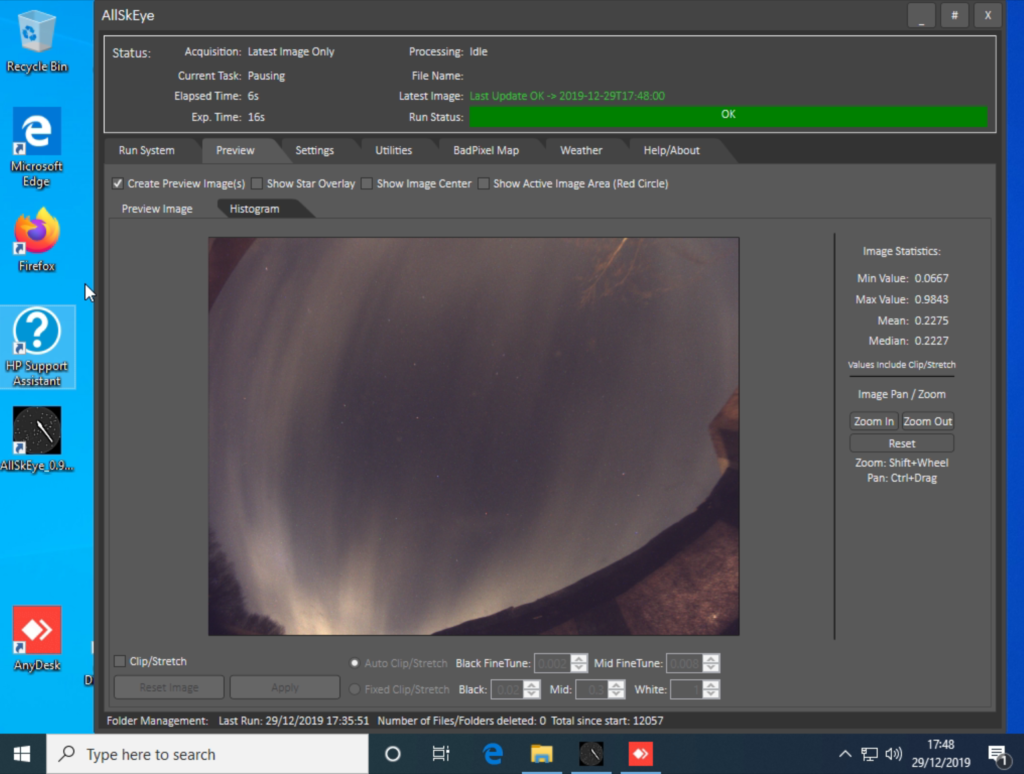
Viewing time period – 19:03 – 21:27
Tonight I wanted to get the PHD2 guiding working when doing a meridian flip without the need to calibrate. A month ago we still failed to get this done, however a little experimenting tonight and changing a single setting has corrected the problem. The setting was the ‘Reverse Dec Outputted After Meridian Flip’ one within the Guiding table of the Advanced Setup, for which I ticked and this fixed the issue.
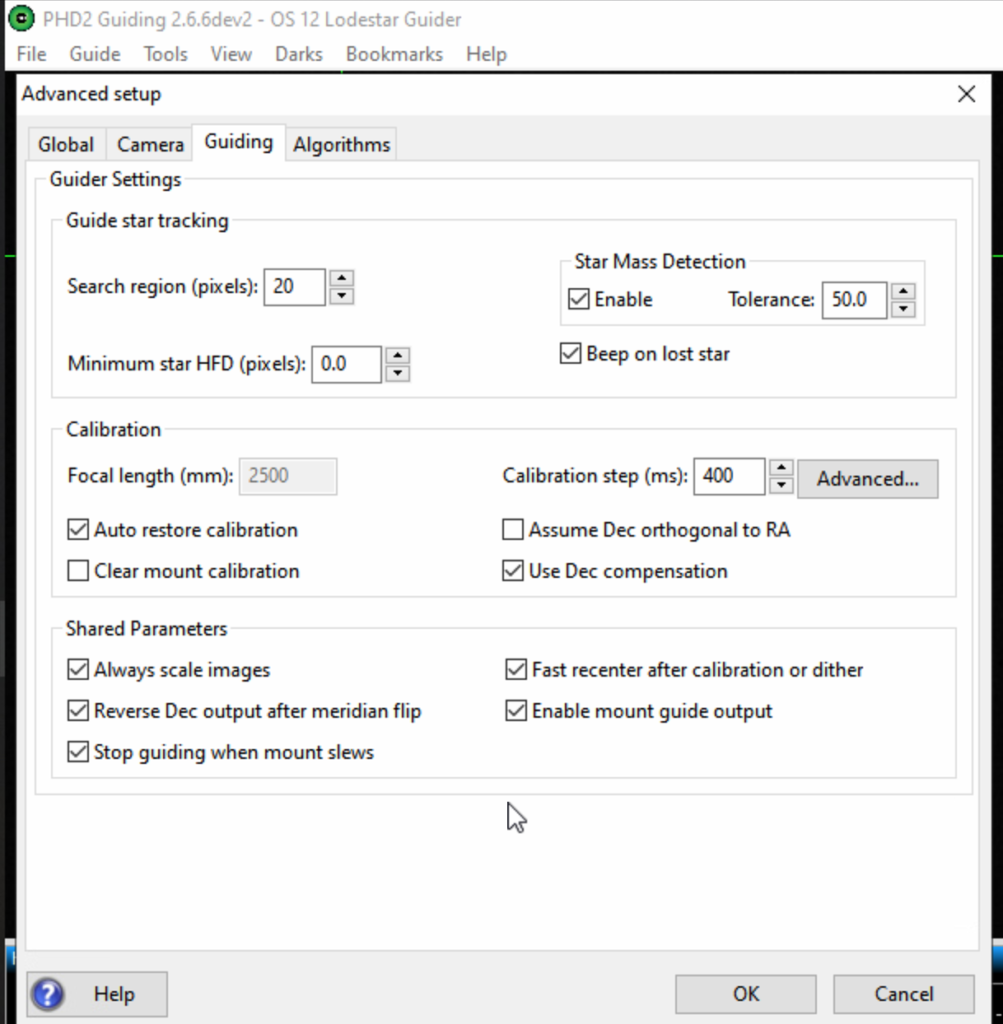
I then decided to try 2 objects either side of the meridian and that worked manually slewing to each and then guiding. What did not work was the slewing automatically to the object in terms of centring on the screen. It slewed to the star, I could see it on the screen, the first object Almach worked ok, but the second object, Deneb appeared on the screen but failed to centre with the error ‘ Failed to auto centre, aborting sequence’ followed by ‘ failed to centre on object with an error less than 50 pixels’. Plate solving works fine, well at least it comes back with success.
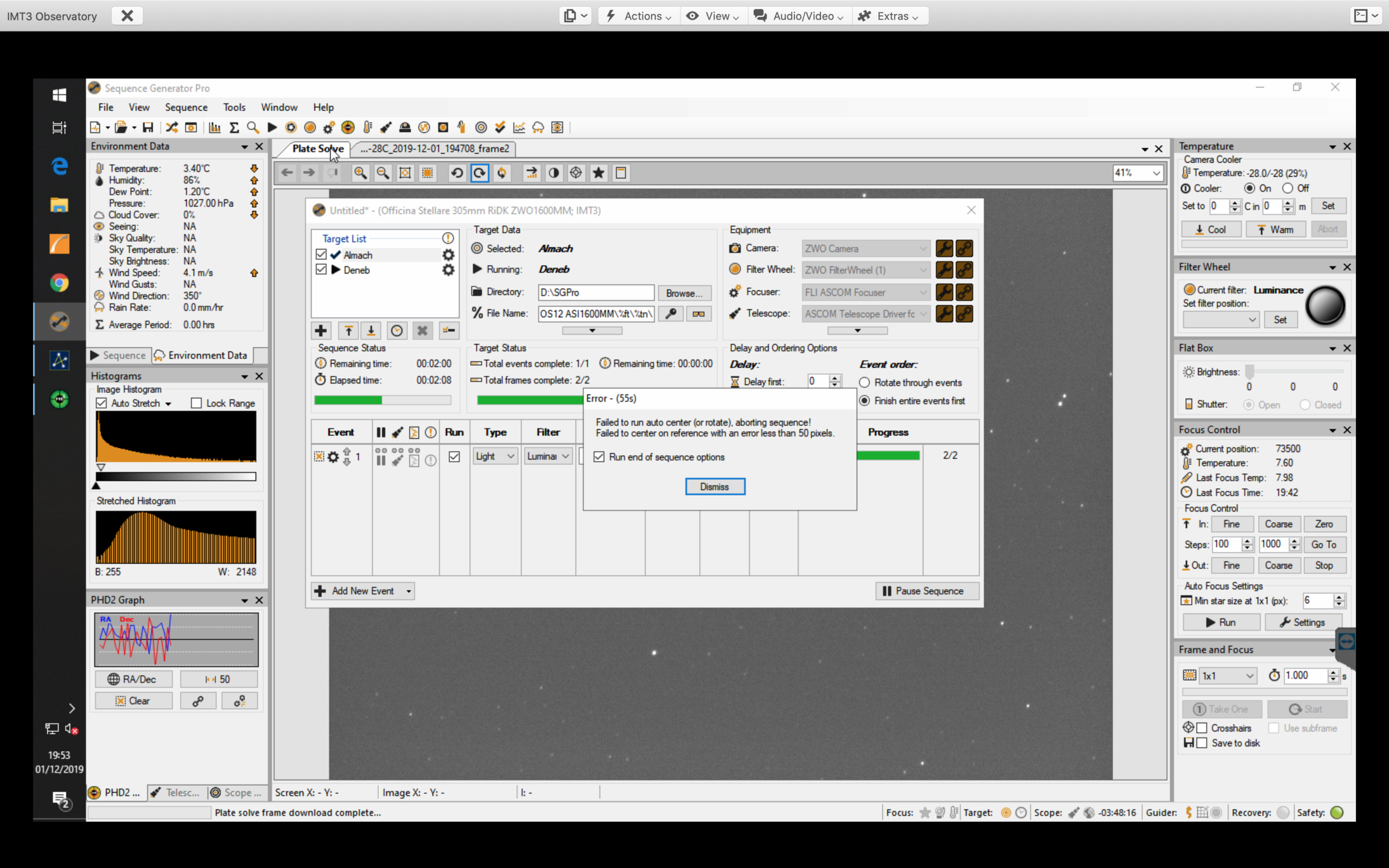
So I tried different sets of co-ordinates from TSX including the Topocentric and 2000.0 sets. Neither made a difference, with 2000.0 data used I still got this set of errors which shows an error in pixels of more than 50 in DEC.
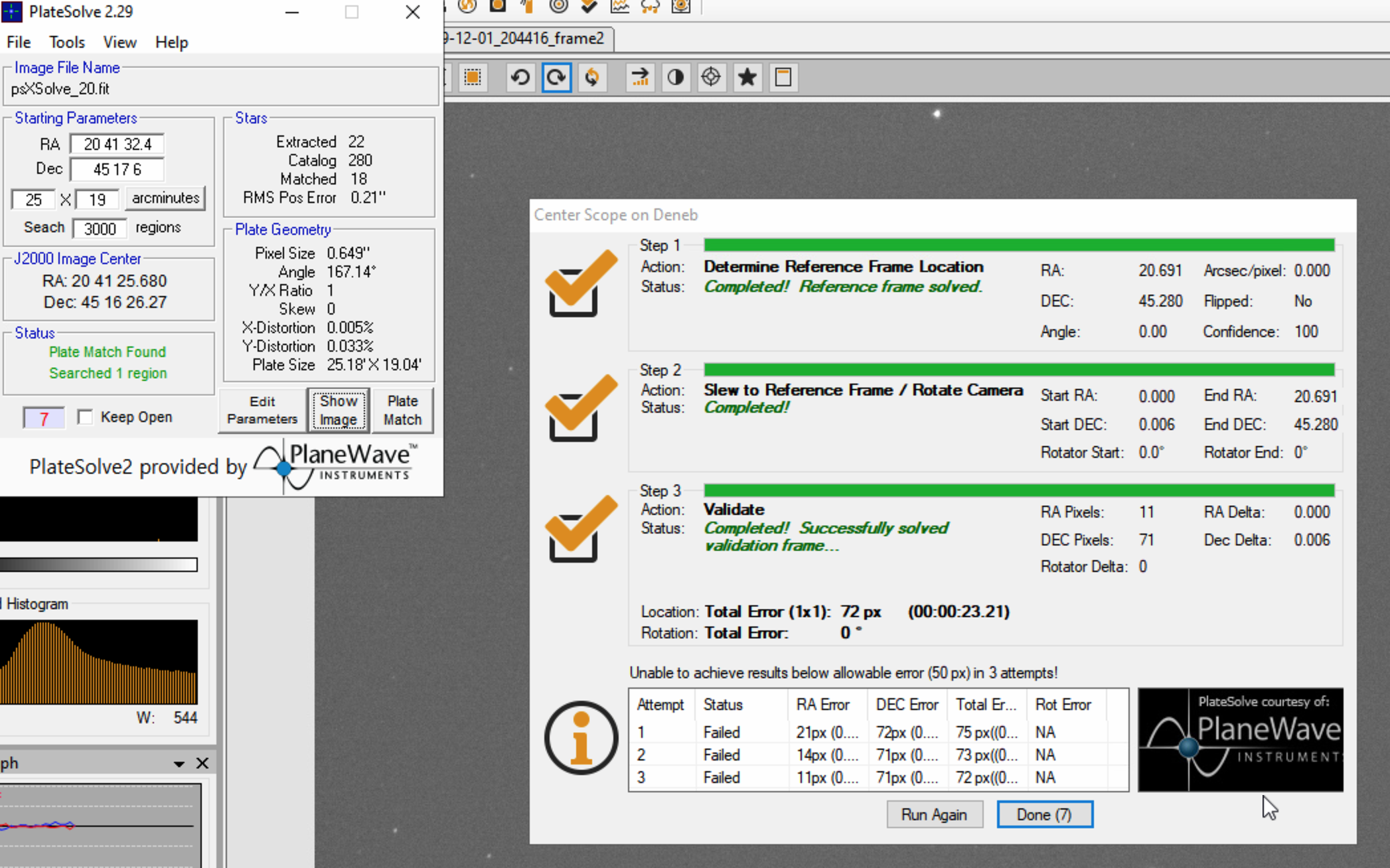
So I decided it might be the very bright object I had picked, star in this case, that was causing the problem. So to further my experimentation this evening I choose two different and less bright objects, M36 and M39, once again on different sides of the Meridian. Success !!
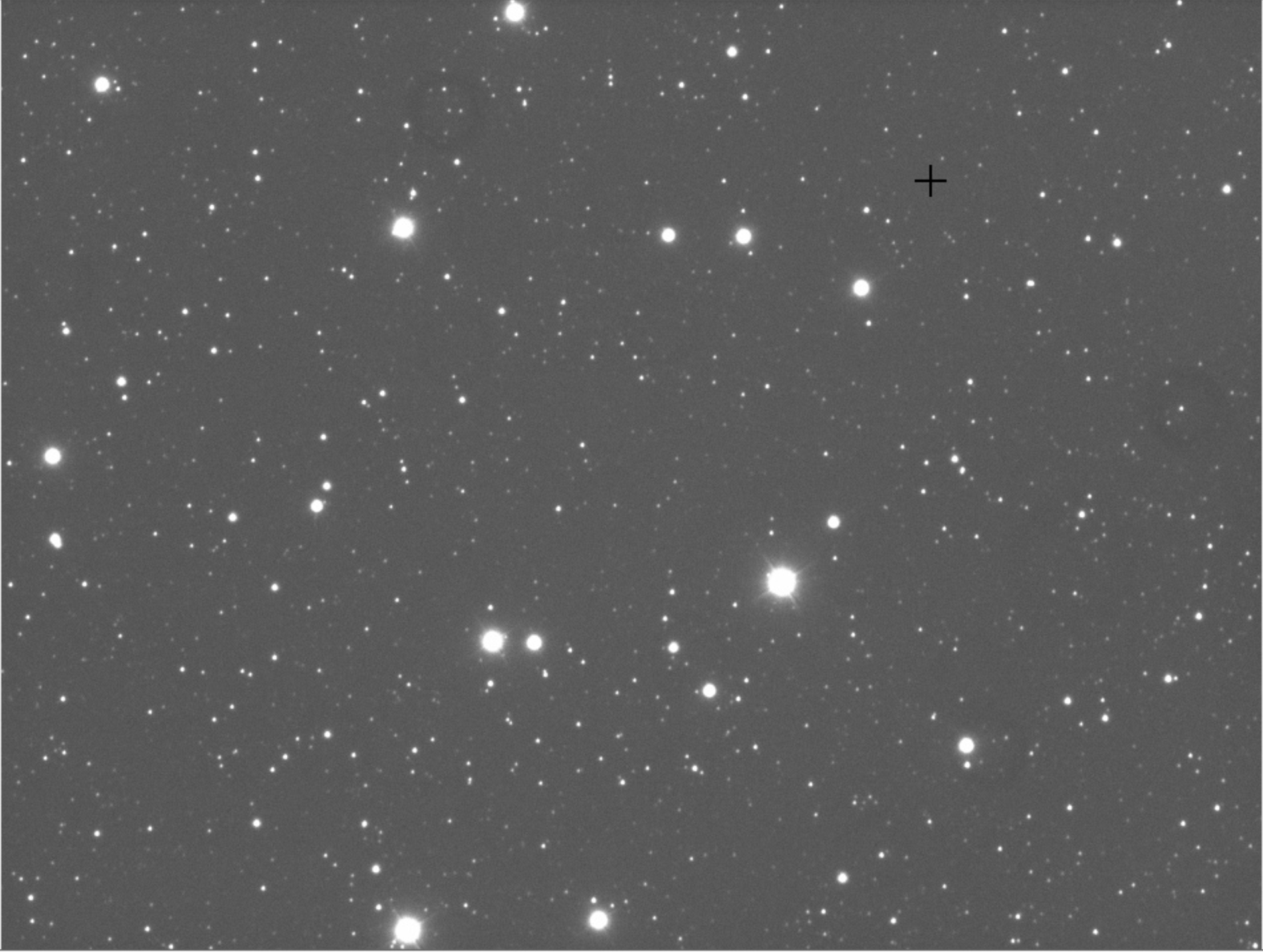
So after fixing this I am now happy to go off to bed early (9:30 work tomorrow) with a job well done.

Clear Skies 🙂
Viewing time period – 20:43 – 04:32
First thing to say is this is a very long blog, much went wrong tonight before it went right and thus I selected to record as much of the problems here as evidence later if I have the same problem or others indeed do. Tonight I am imaging M76 a planetary nebula in Perseus known as the Little Dumbbell. This is my first real object to image through the IMT3’s 12″ scope. The weather looked good and a quick look through the All Sky Camera showed a clear sky with Vega shining bright overhead and a slight glow with the Sun still setting to the West.
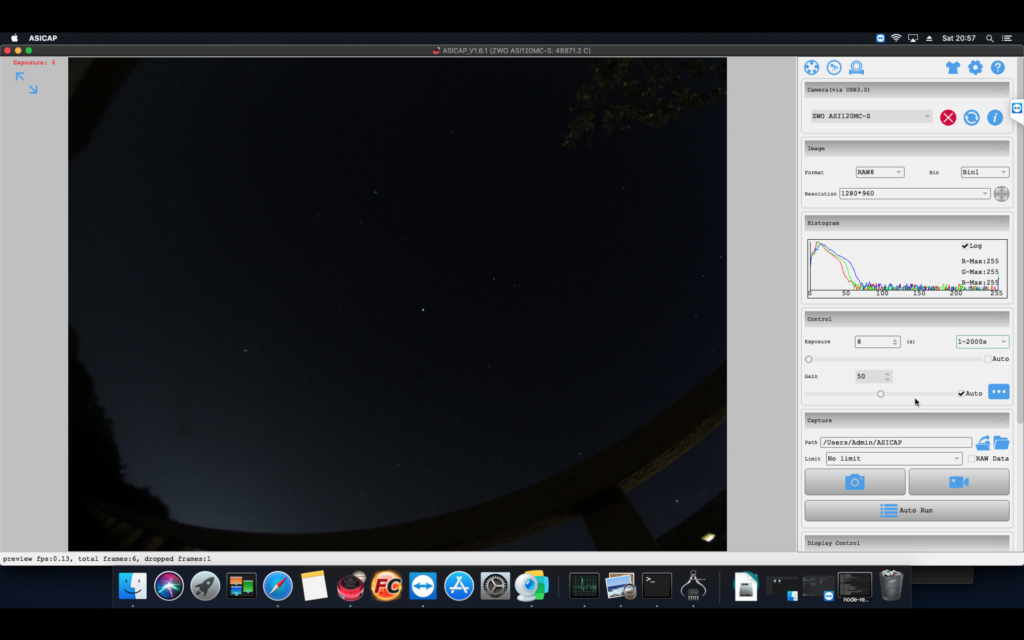
The first thing I needed to do was to slew to a bright mag +2 star, in this instance Caph in nearby Cassiopeia and centre and sync the scope which I did through TheSkyX (TSX). I then slewed to a magnitude +9 star (SAO 21164) nearby so that I could perform an autofocus through the OIII filter using SGPro. The best fit was 73,914.
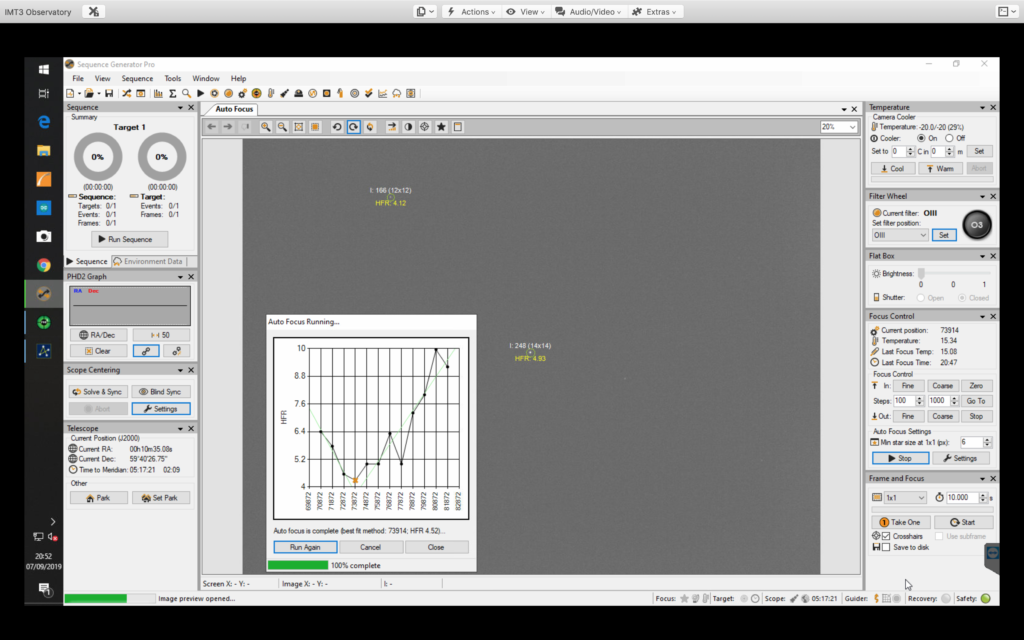
I then took a single 60s exposure just to make sure the focus was right, the stars coming in at around Half Flux Radius (HFR) 4. Meanwhile the camera cooler was running at -20℃ and 28% so I lowered to -28℃ at 60%. It should be noted that every time I perform a closed loop slew in TSX and the camera connects, the camera then looses the information of its status in SGPro and the only way to resolve to disconnect and reconnect. I again will note this is the TOSA User Guide.
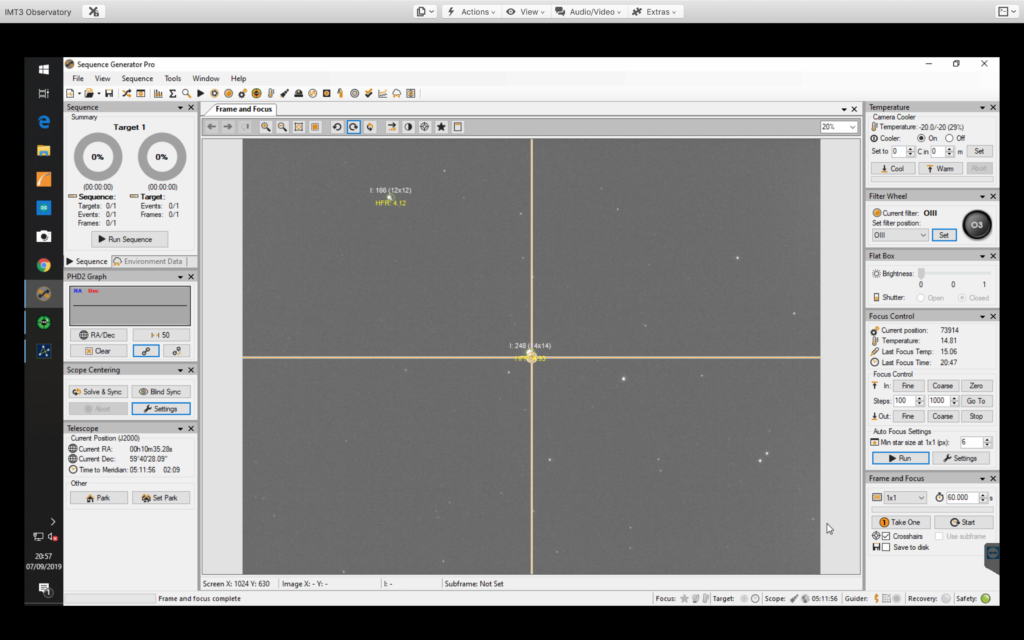
Then I slewed to M76, which on first inspection was still being my neighbours house. So I waited for a while longer and around 21:10 it appeared above the roof for its polar orbit around Polaris. I took a quick image with SGPro of 60 seconds through the OIII filer to see where I was pointing, given I only have a 60 point TPoint model (I need 300 for the best pointing accuracy).

So given I was slightly out I selected the Luminance filter, went back to TSX and performed another Closed Loop Slew and then synced the scope for good measure. The resulting image through TSX and then through SGPro showed a perfect improvement.

Before imaging I went back to look at the PEC as Bob had mentioned not being able to image for very long on the Tak FS102 after we had taken it off, added the adjuster plate, reattached and added some weights. Not surprisingly the TPoint model will need redoing, however I noted the PEC was turned off, maybe I had not saved the last time I enabled. So I reenabled and saved.
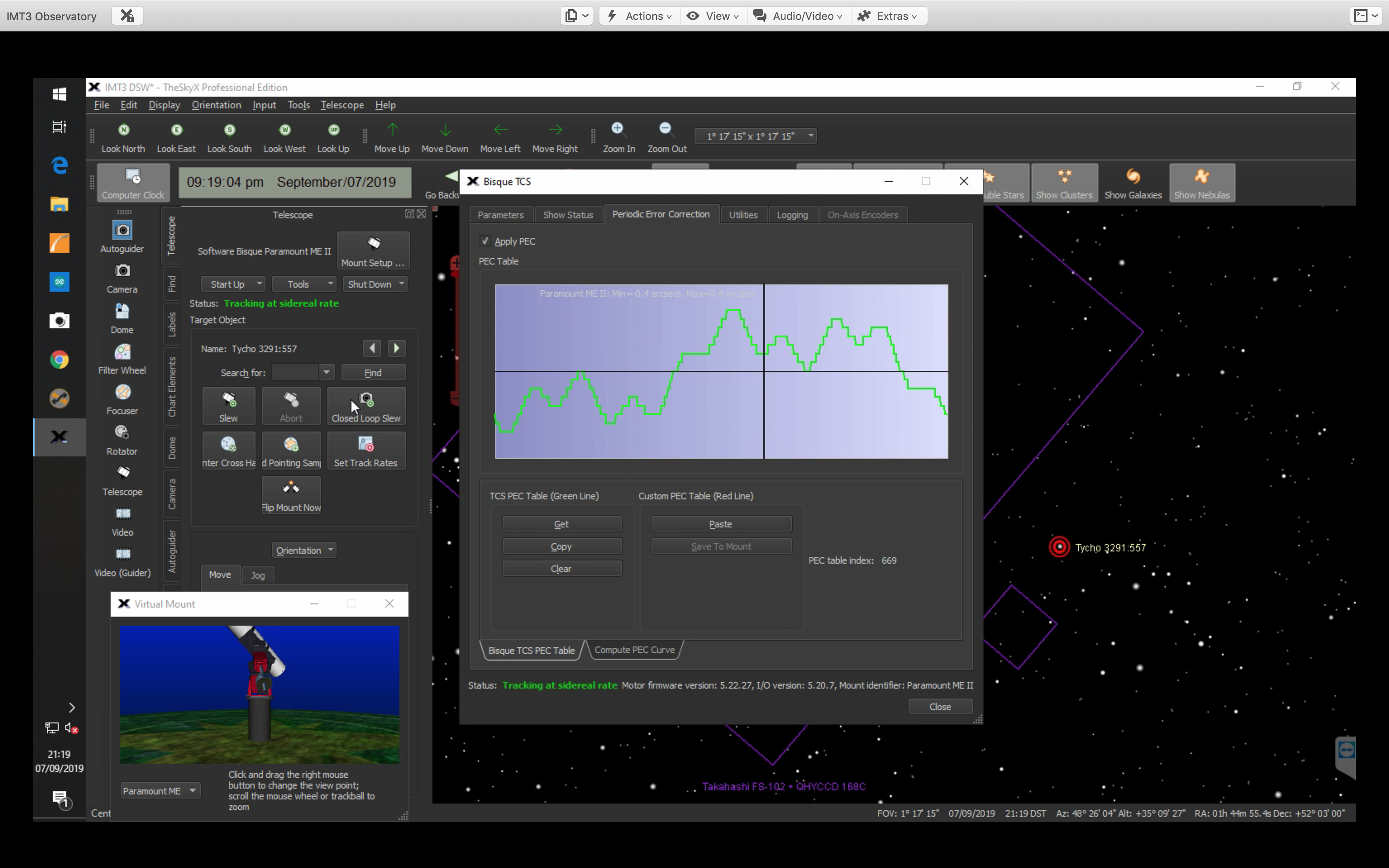
I then went looking for a guide star with PHD2, however even with 10 seconds I could not see one. I looked at TSX and indeed the Field of View (FoV) indicator for the guider showed a fairly barren piece of sky with barely a magnitude +11 star visible.
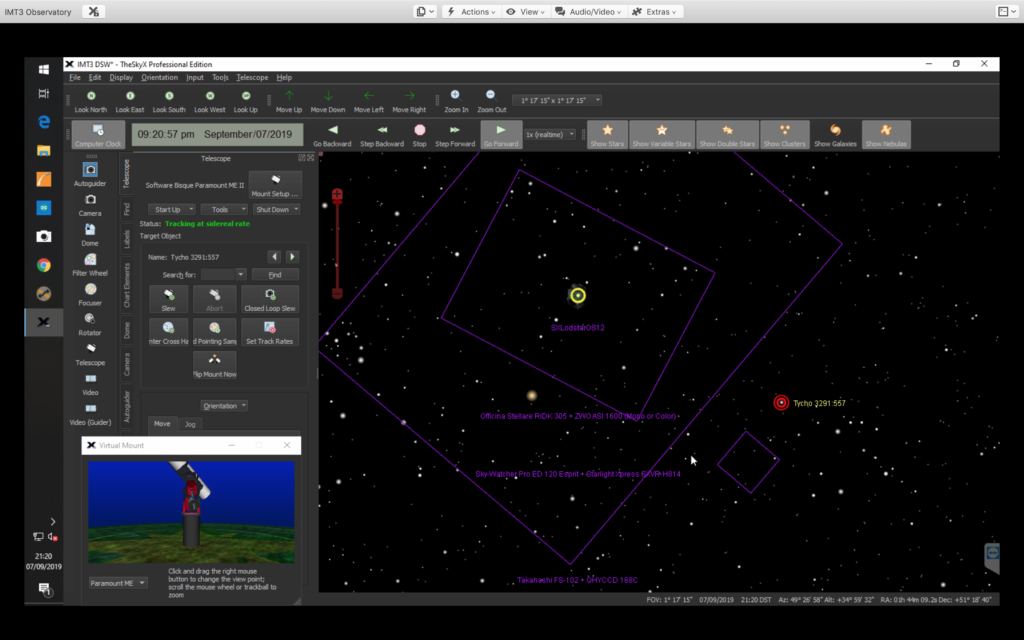
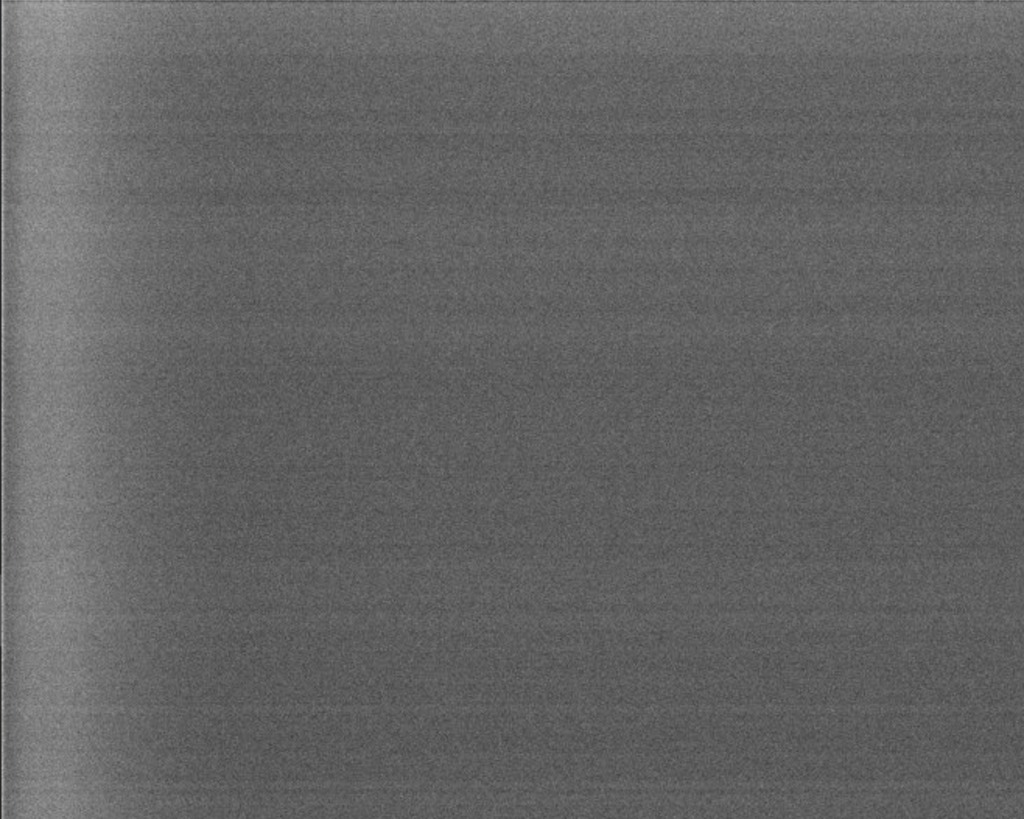
I performed a quick check of the SQM and it was reading 19.37 and the Hitec Weather station had a reading of around 25 meaning between Haze and Clear. Another quick check of the ASC and that was showing clear. So either I had to move the scope to find a guide star or I could image without guiding……so the only way to tell was take a quick 5min image and see what it looked like.
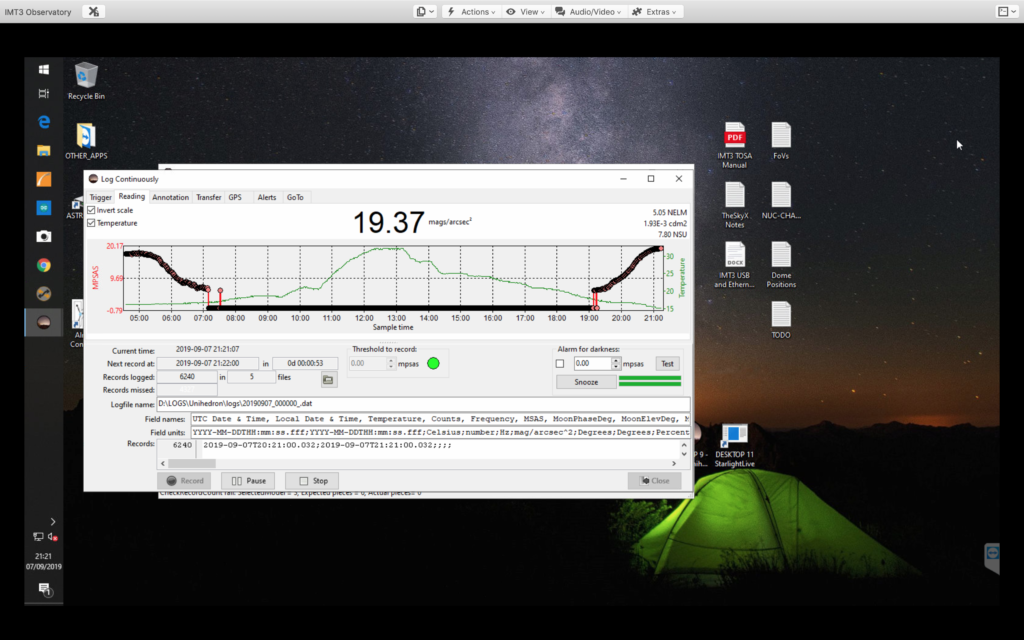

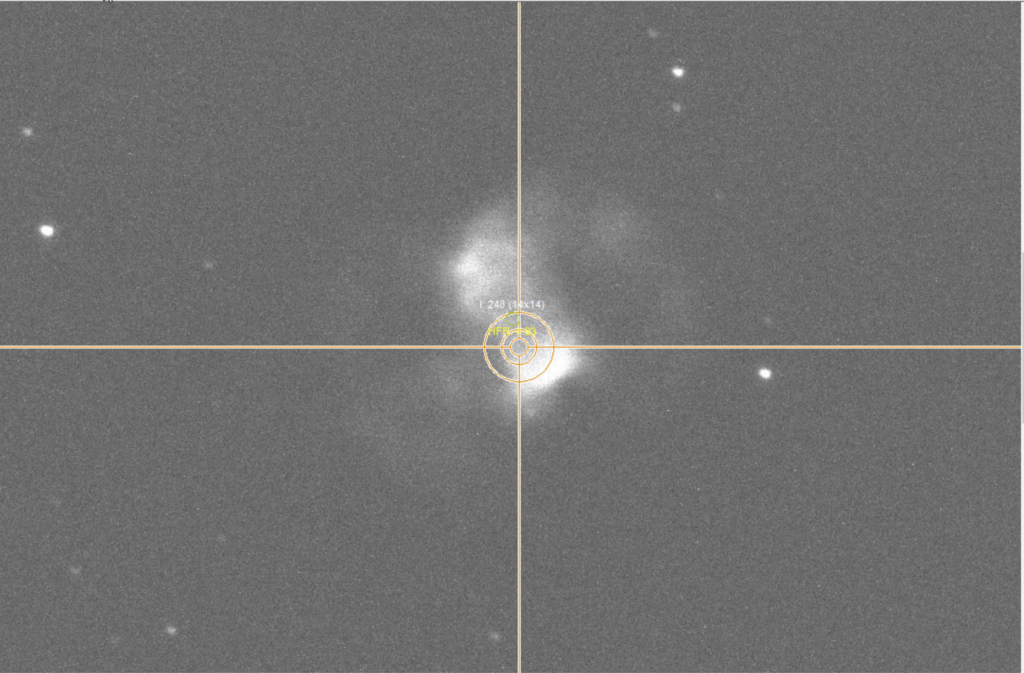
As suspected the resulting 5min image showed trailing, not surprising given the TPoint model is out so I decided to guide. I slewed around trying to find a decent guide star but nothing came up, literally nothing, which then got me thinking this was not right. So I checked a bright star in the FoV for the guider, still nothing. So I then disconnected the camera and checked the settings and there it was, the setting was for the SX814 which was not powered on (aka GingerGeeks main camera on the Epsrit 120) so I changed this to the Lodestar and took another image, this came into view! Not sure the problem of why it keeps reverting to the SX814 but I will need to check each time and will add to the TOSA User Guide.
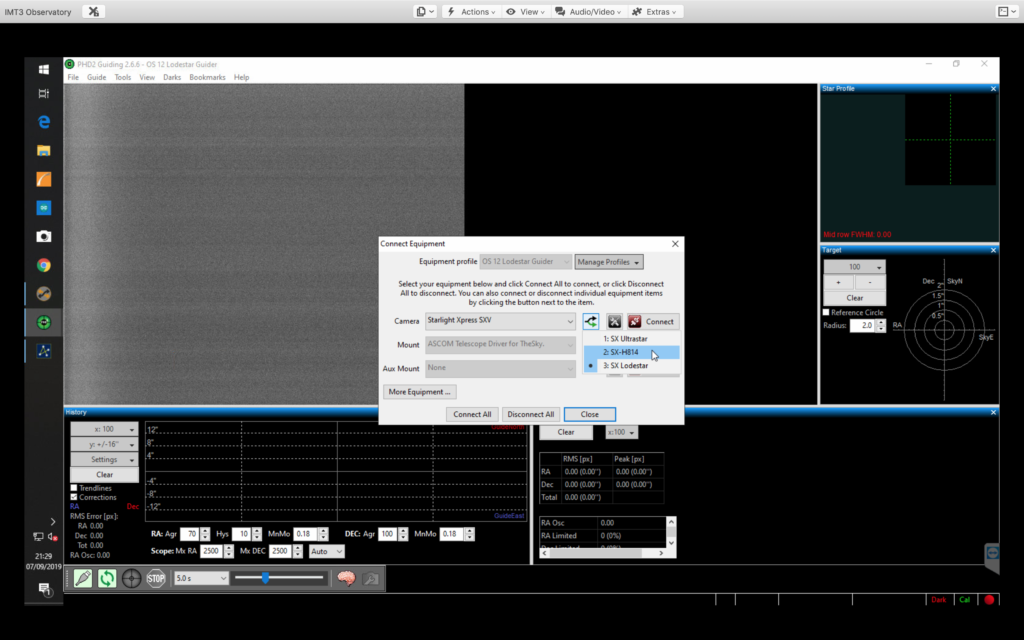
So I moved back to M76 entering with TSX again and took an image for guiding through PHD2 and full of stars, well a handful at any rate, plus a load of hot pixels (I need to apply some darks).

The resulting guider graph was smooth, too smooth, and the resulting 5 min image was trailed! Ok so something else not right, so after taking a look it turned out I had selected a hot pixel to guide on, so I exposed a little longer from 5s to 10s and selected what looked more like a star and this time tried to guide. The guiding went off the chart which proved this was a star and that I needed to calibrate the guider (seemingly every night I go out, I will need to see if that is right). So off I went to calibrate the guider.

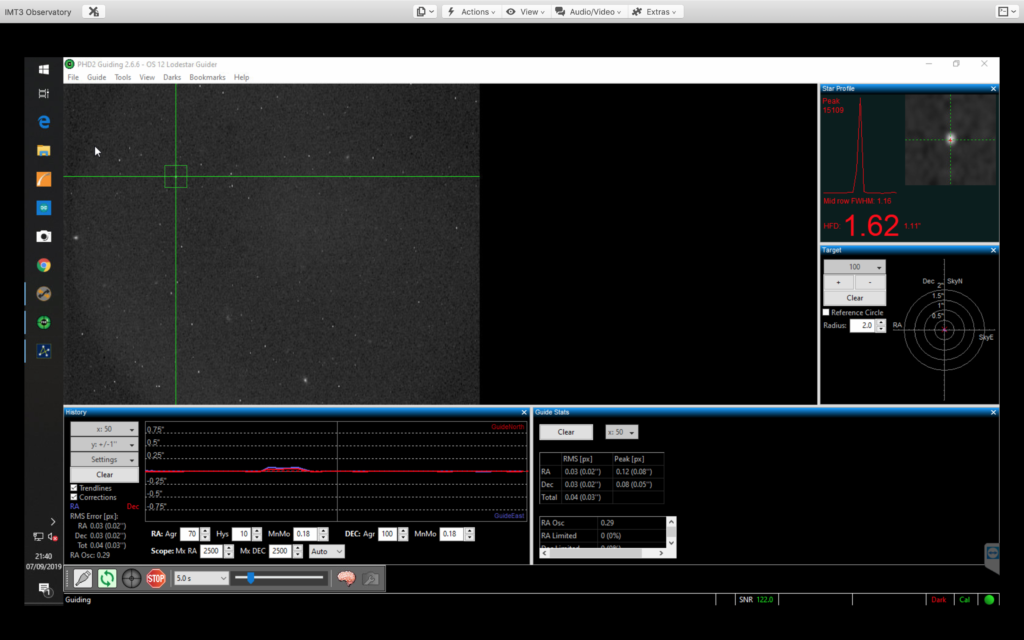
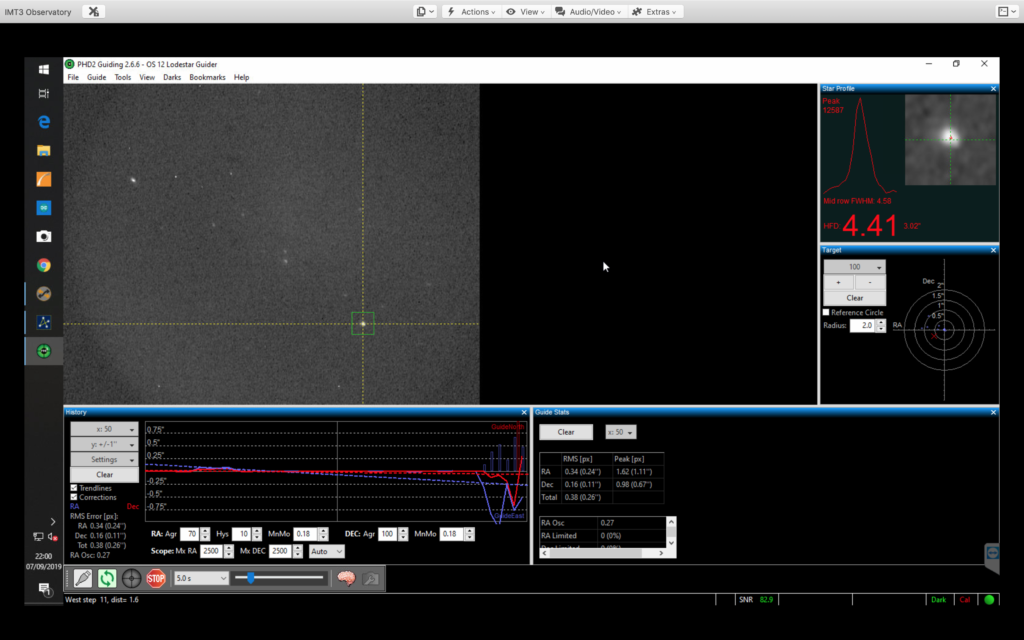
In calibrating I realised the Darks were going to be needed, the first calibration run failed. I then went out to cover the scope using my trusty chair to help with the lift I needed to reach the end of the 12″ as it was point upwards. I then went back inside and took a set of darks ( I thought I had done this before), anyway with a new dark library in hand I recalibrated the guider.
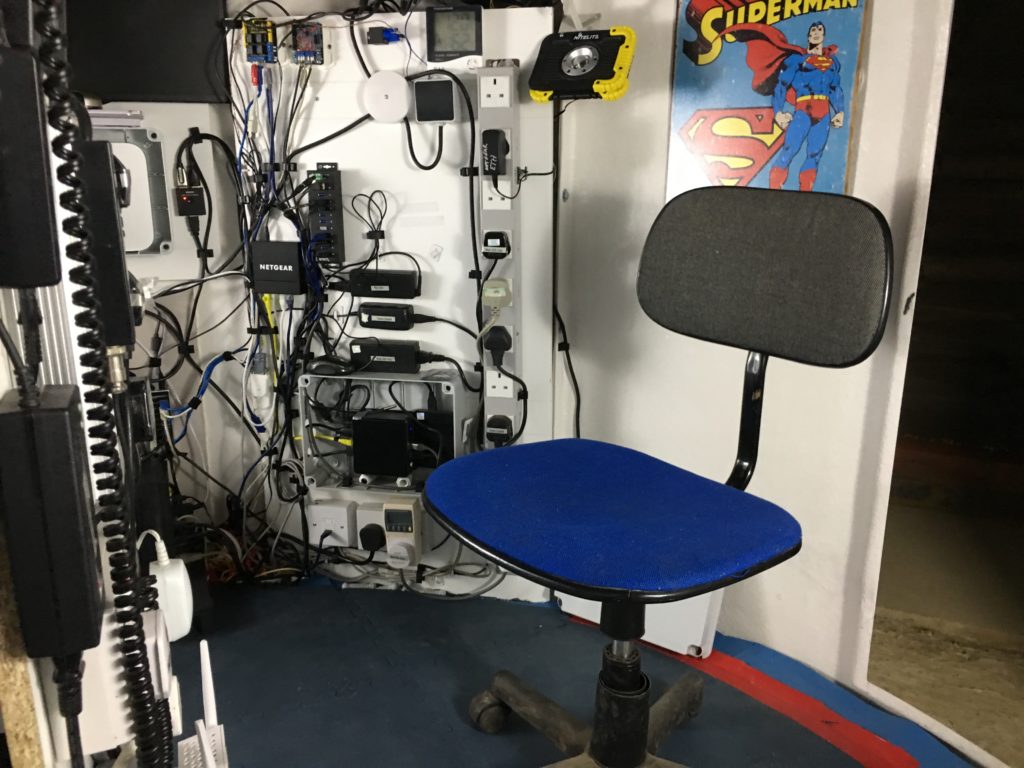
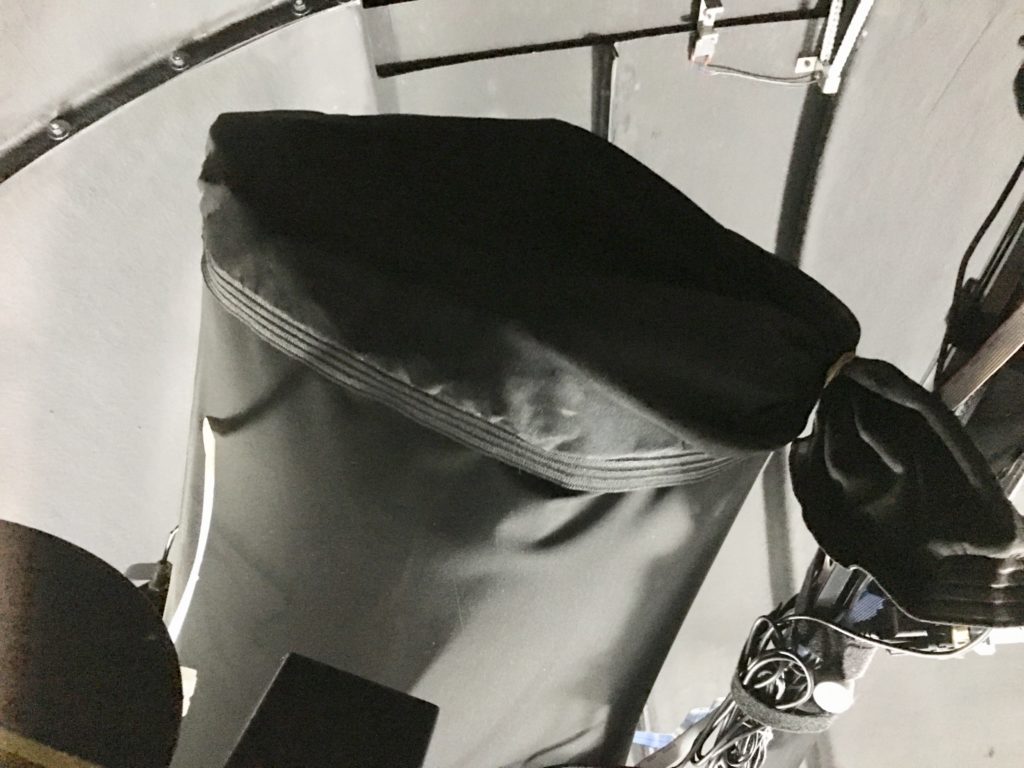
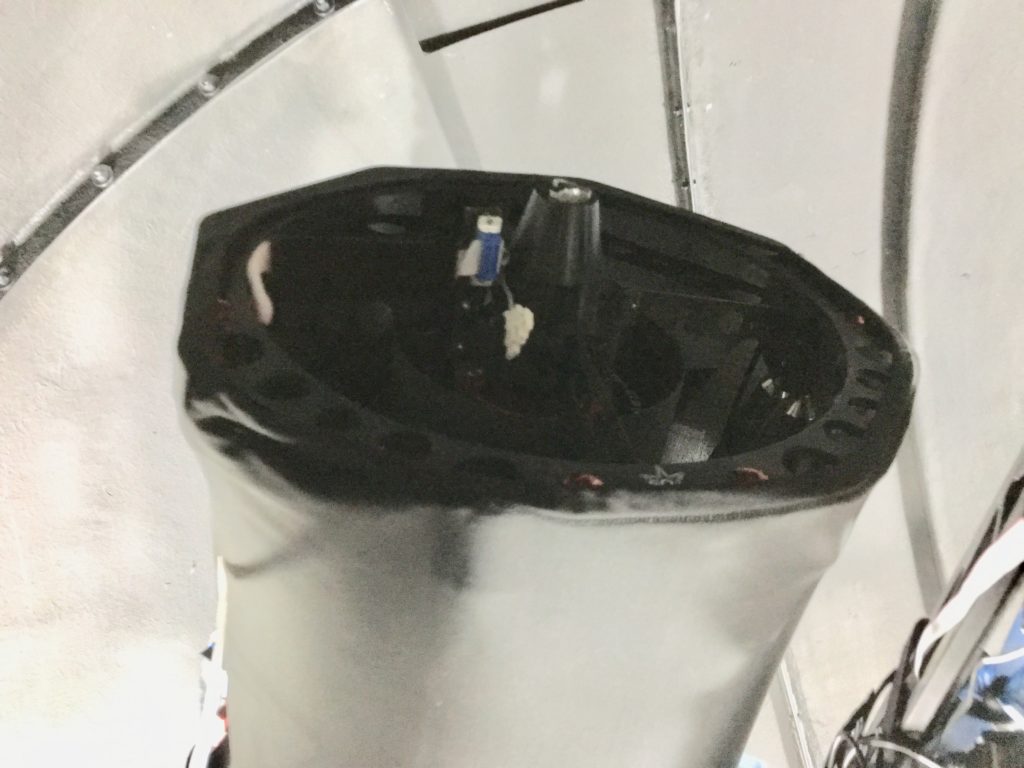
Now suffice to say the problems did not stop there, I had guider calibration failed, star did not move enough and after 4 attempts I managed to calibrate the guider and the guiding then started at last! the main thing was to change the number of steps required to 6 and the pulse time changed then to 1500ms from 200ms. This was enough to resolve the problem.
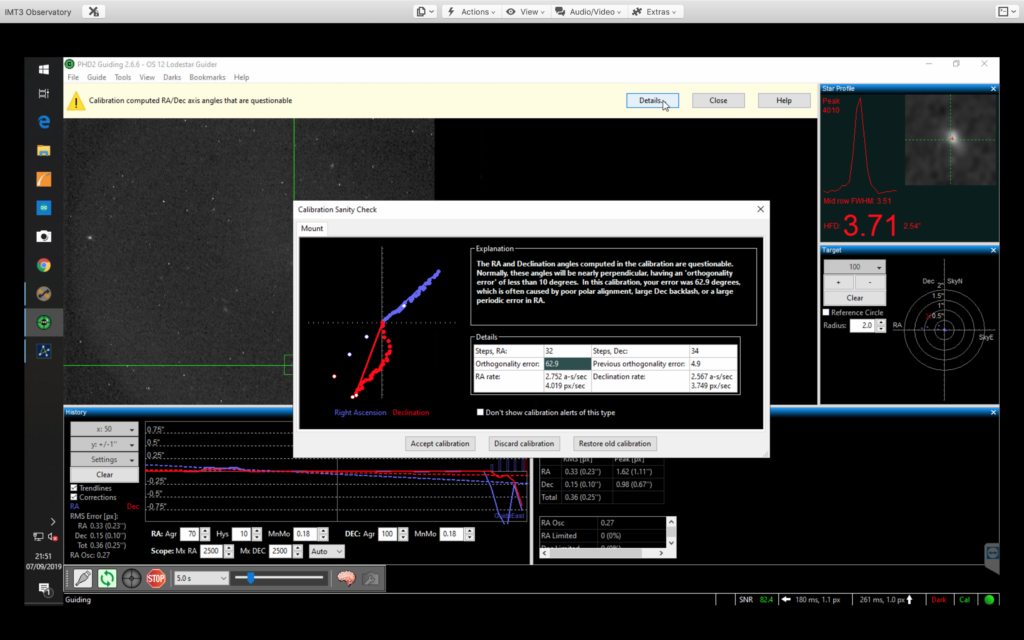
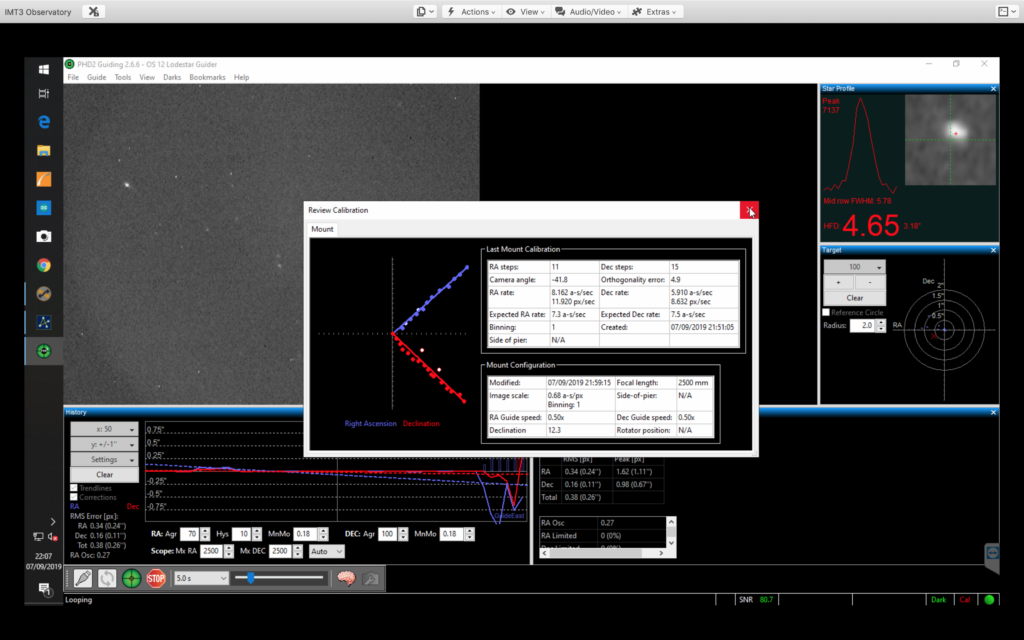
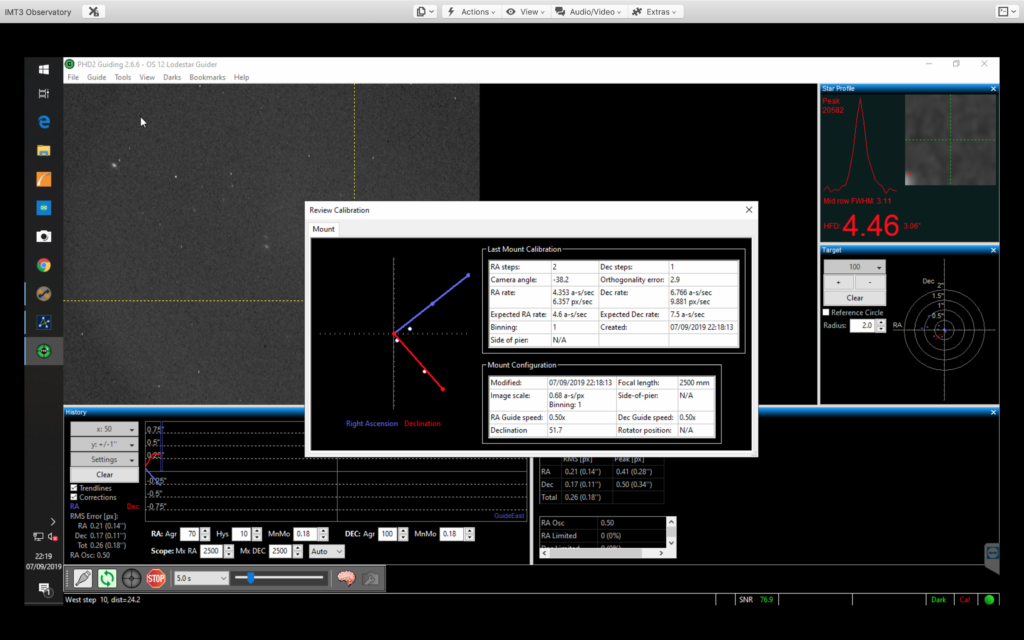
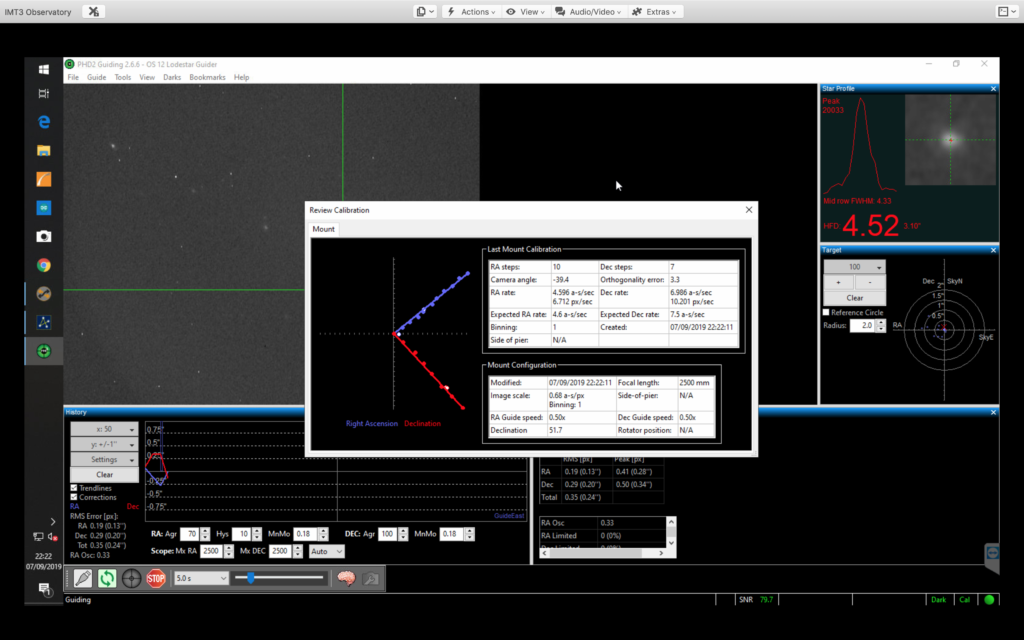
For completeness here are the settings I am now using that work in PHD2
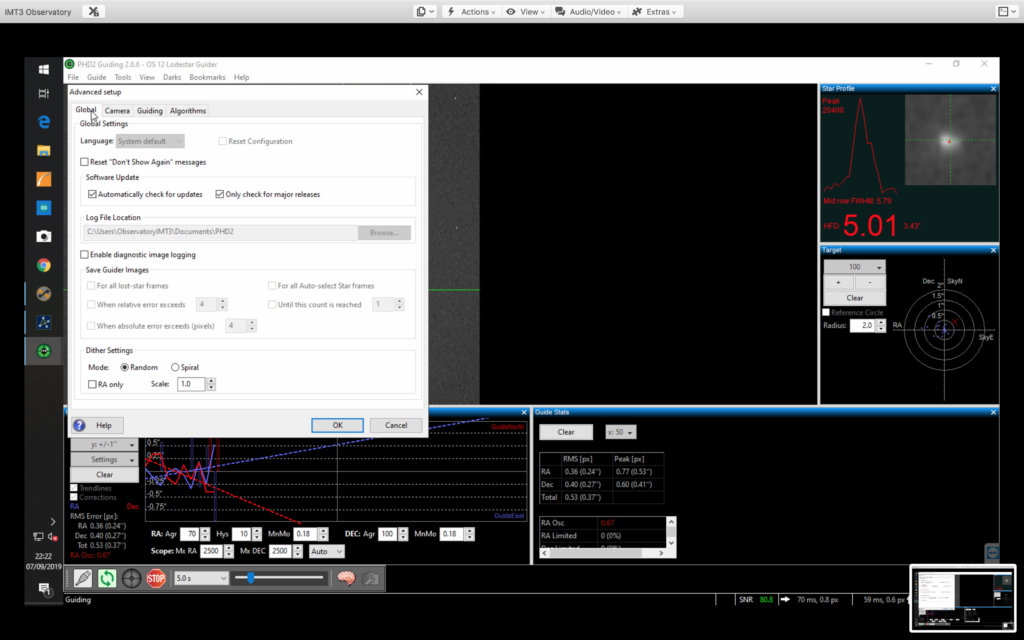
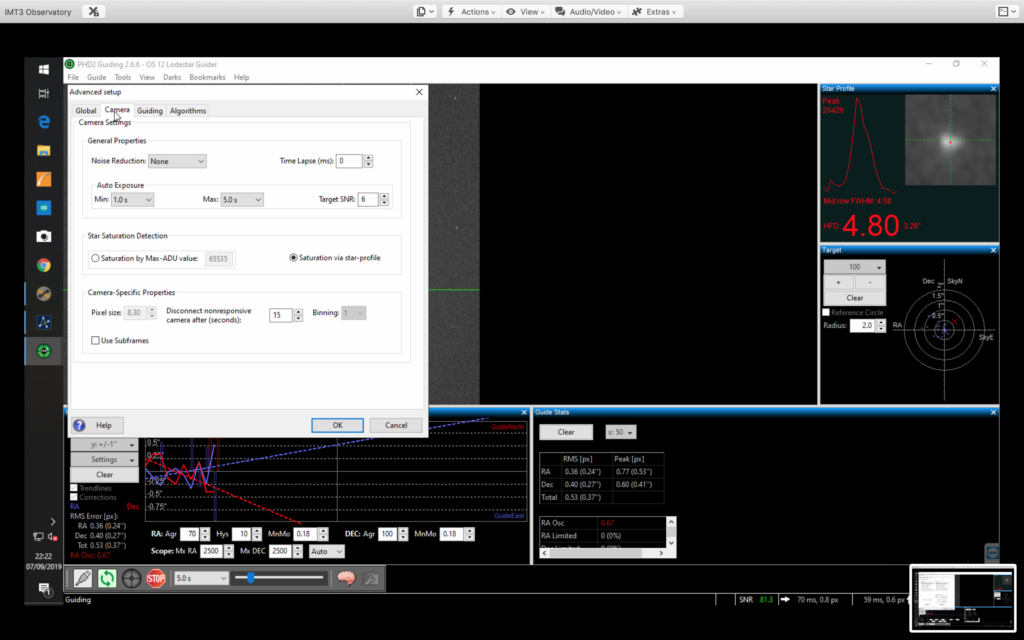
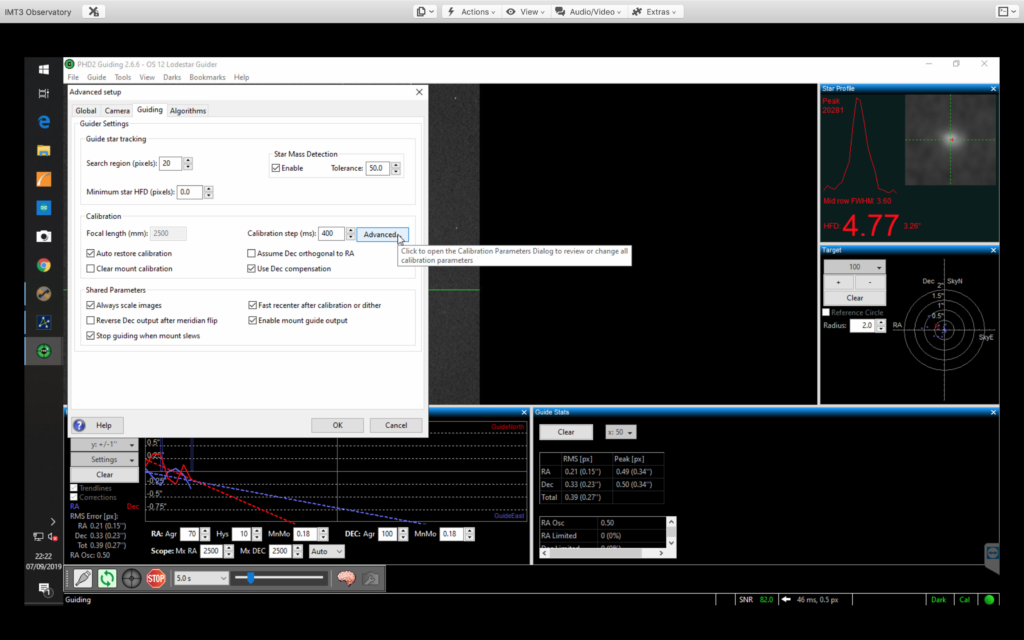
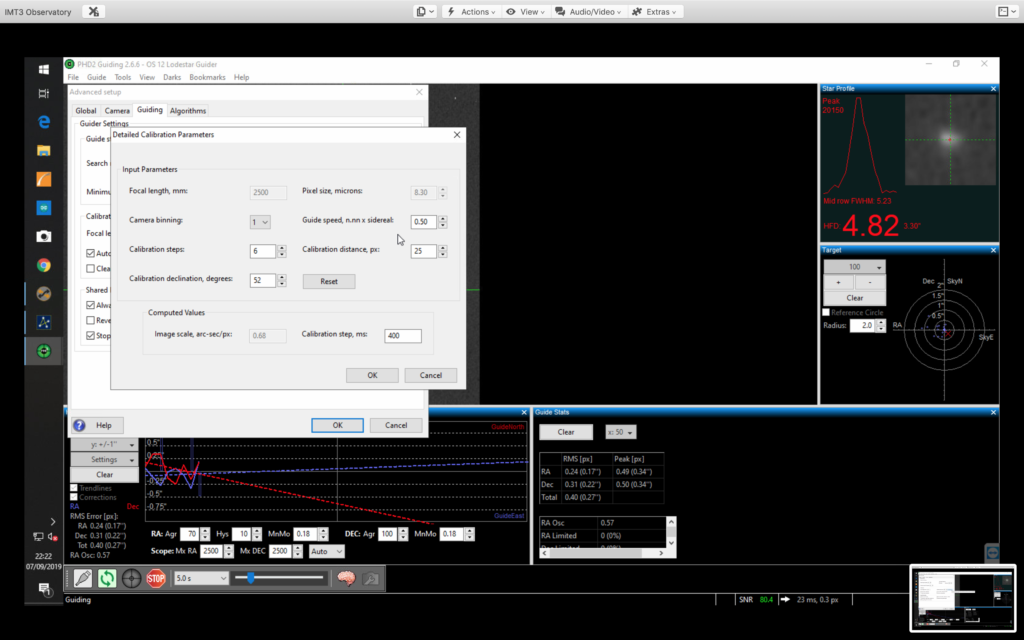
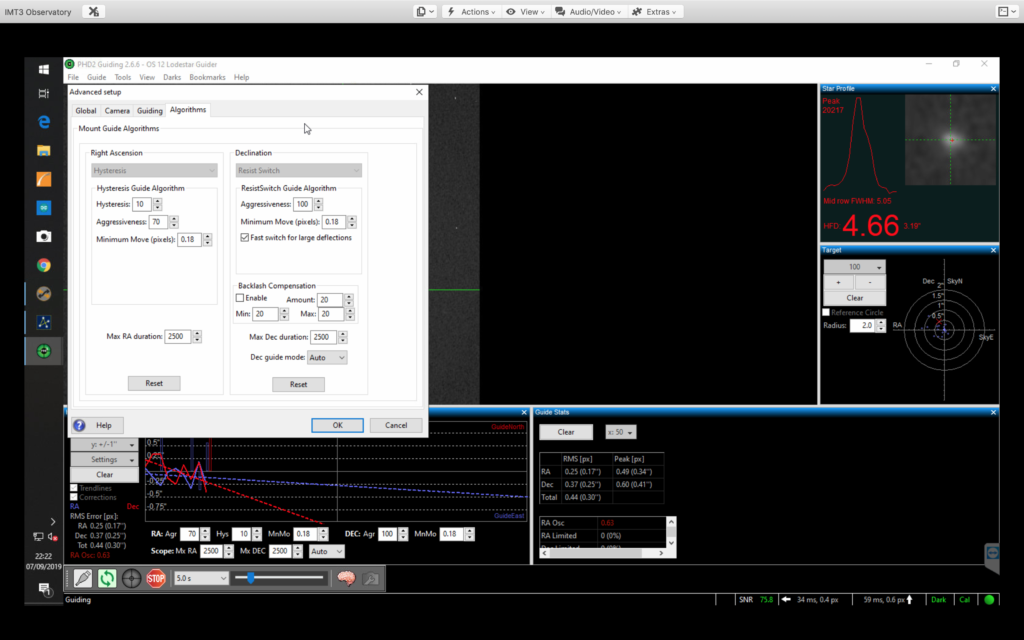
So after much time spent and it now being precisely 22:33 I realigned M76 in the centre as it had moved with all the calibration challenges (remembering to change the filter to Luminance during the Closed Loop Slew in TSX and then back to OIII to start my imaging run.
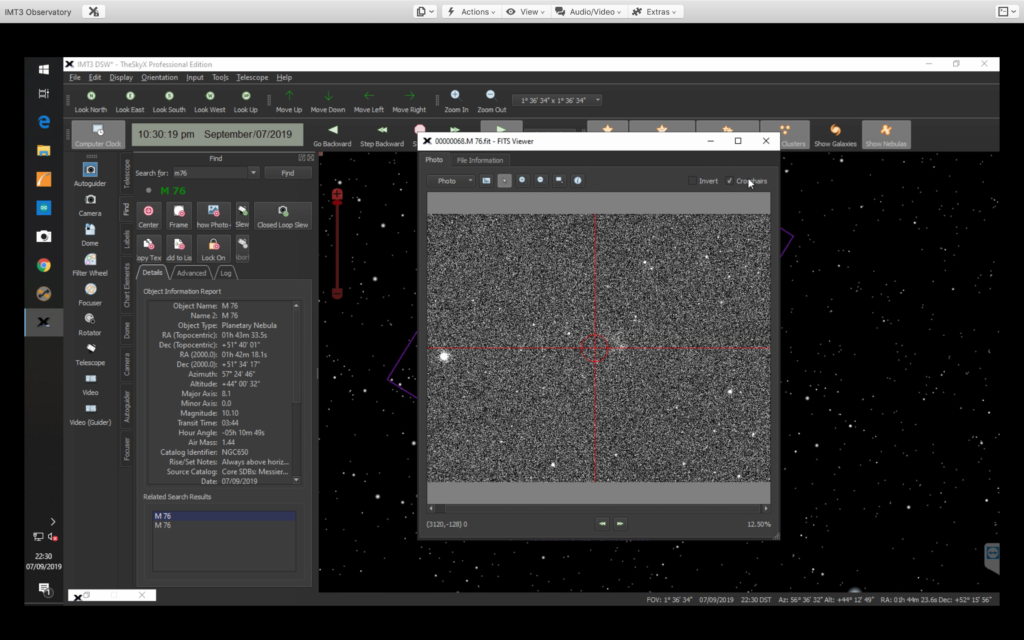
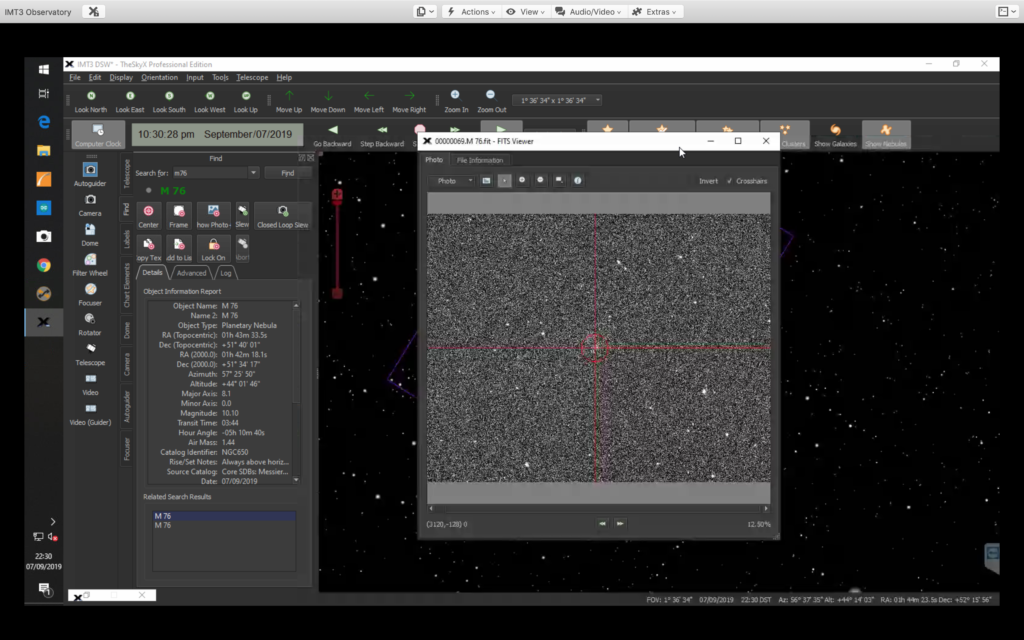
I tested at 2 minutes first, then 5 minutes, then 20 minutes before starting the final run to decide on the subs I would use. By 23:14 I had the 20 minutes sub and settled on 20 minute subs for the rest of the night.
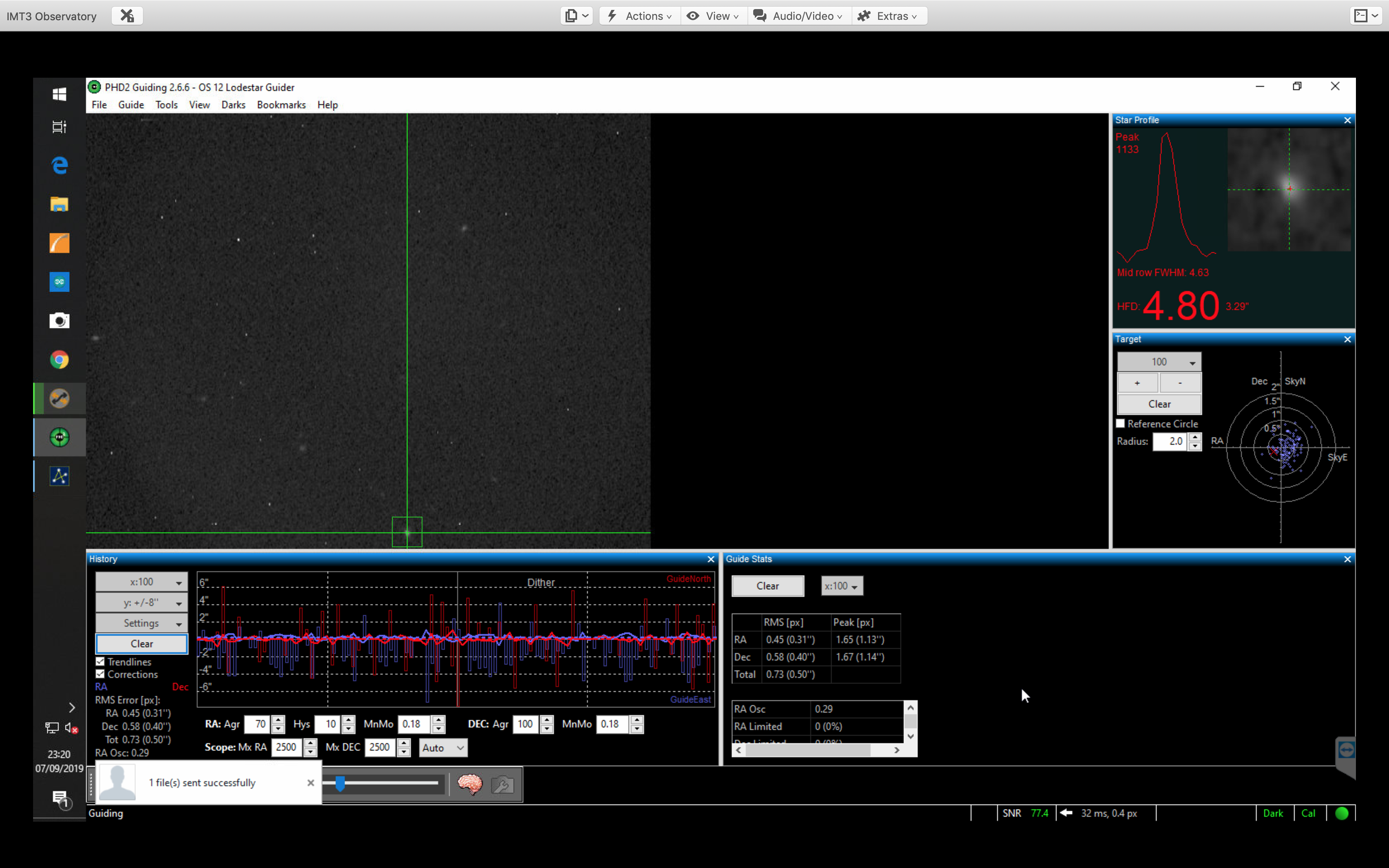
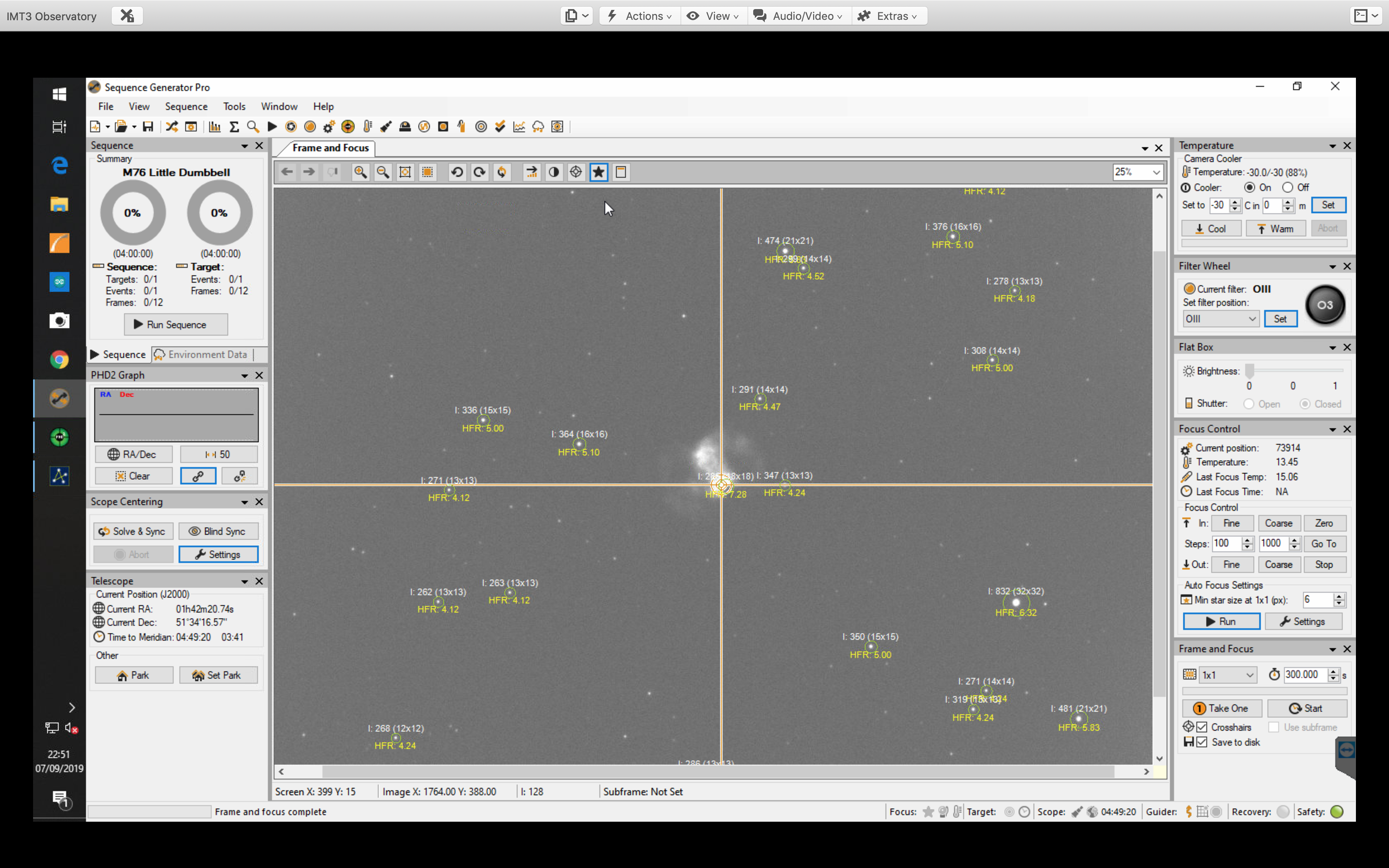

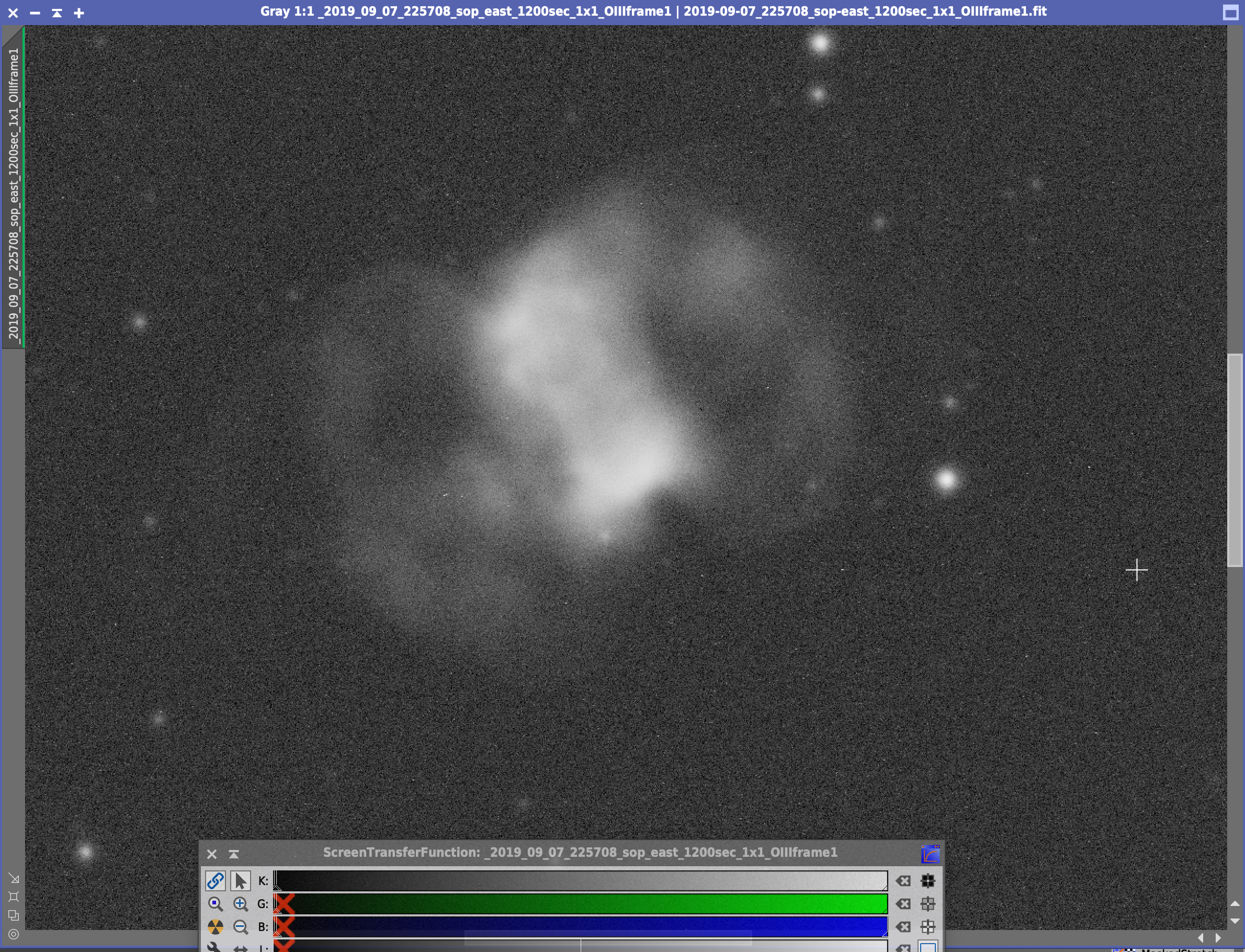
Meanwhile the Summer Triangle of Deneb, Vega and Altair could be seen through the ASC and I noted that the star Tarazed in Aquila next to Altair at magnitude +2.7 could be seen also.
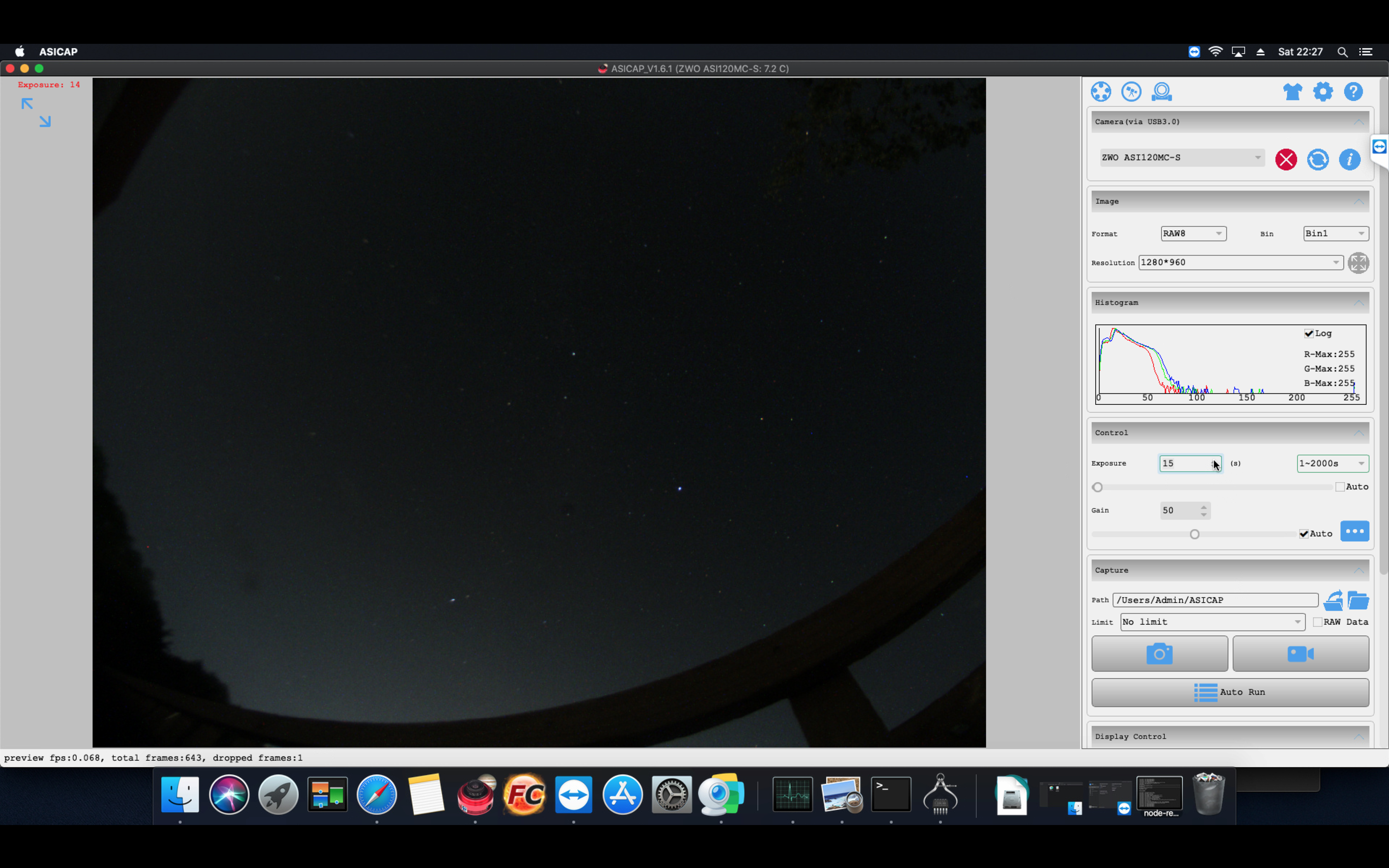
I noticed the trellis lit up and had a quick word with my daughter to close the blind in the bathroom 🙁
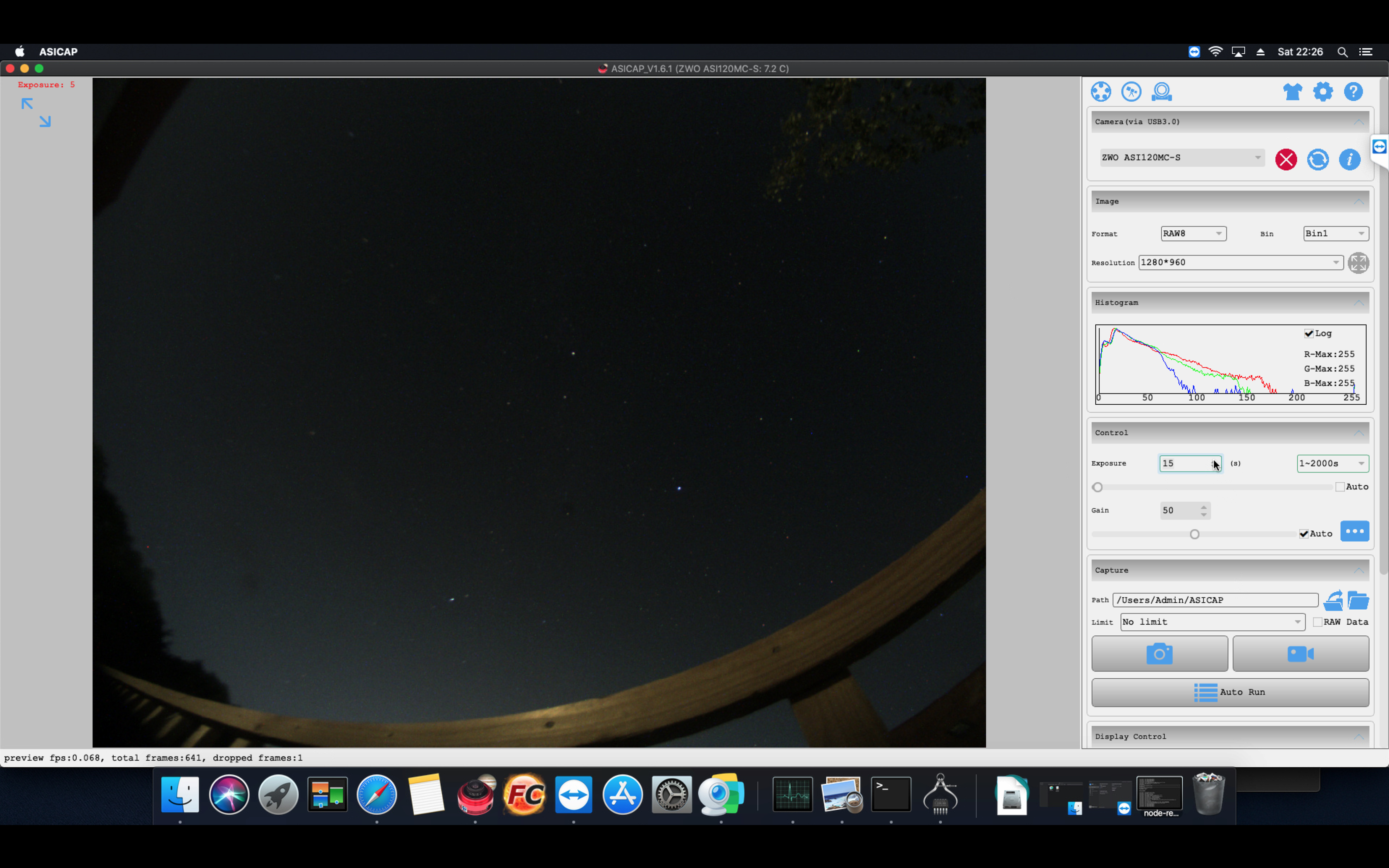
Here is the temperature and pressure information from the dome internal sensors at around midnight.

At 03:49 I decided to do a quick autofocus to see if the focus had changed during the night and given the temperature outside was now around 5℃. I paused the current sequence which gave me the option of cancelling or pausing at the end of the current image. I then ran autofocus but no stars were found. I went into the setting for autofocus within SGPro and changed the exposure time for the OIII filter from 1 to 20 seconds. This allowed the autofocus to see stars but the auto focus would not complete successfully and just kept creeping out. So instead I gave up, especially since astronomical darkness was finishing soon. Instead I slewed to my Flat position at Az 359, 21′ and Alt 00, 00′ to take the flats.

I went out to the dome to manually turn on the light sheet which we need to automate and then turned it off after I took 10 flats through the OIII filter at 10 seconds each to get a good illumination. It would be 0.5 seconds through Luminance filter. I then packed up set the darks running and went to bed.

Viewing time period – 22:17 – 01:04
Configuring the guider to work with DirectGuide was tonights job, it was so important I have created a separate blog for it. That took the majority of this session before I really did need to go to bed for work tomorrow.
Once setup and now having the ability to reliably guide without the need for an ST-4 cable, I went to take a quick photo again to test the stability of the system. The importance of DirectGuide is worth labouring here as given we have 3 scopes to guide from, there is only 1 ST-4 port. We did not want to keep plugging in and unplugging the different cables, more did we want to build a bespoke connector for all 3, so DirectGuiding is really the only way this would work.
Once complete I once again tried to slew to the exact area for the Elephant Trunk, this has been problematic due to not quite getting sync and solve working, it works sometimes, and locating a star that I can reliably use. I have noted now that HD 205850 in Sky Safari and SAO 33570 in the SkyX represent the pair of stars in the main section of the trunk. I also took another frame nearby to label for future reference.
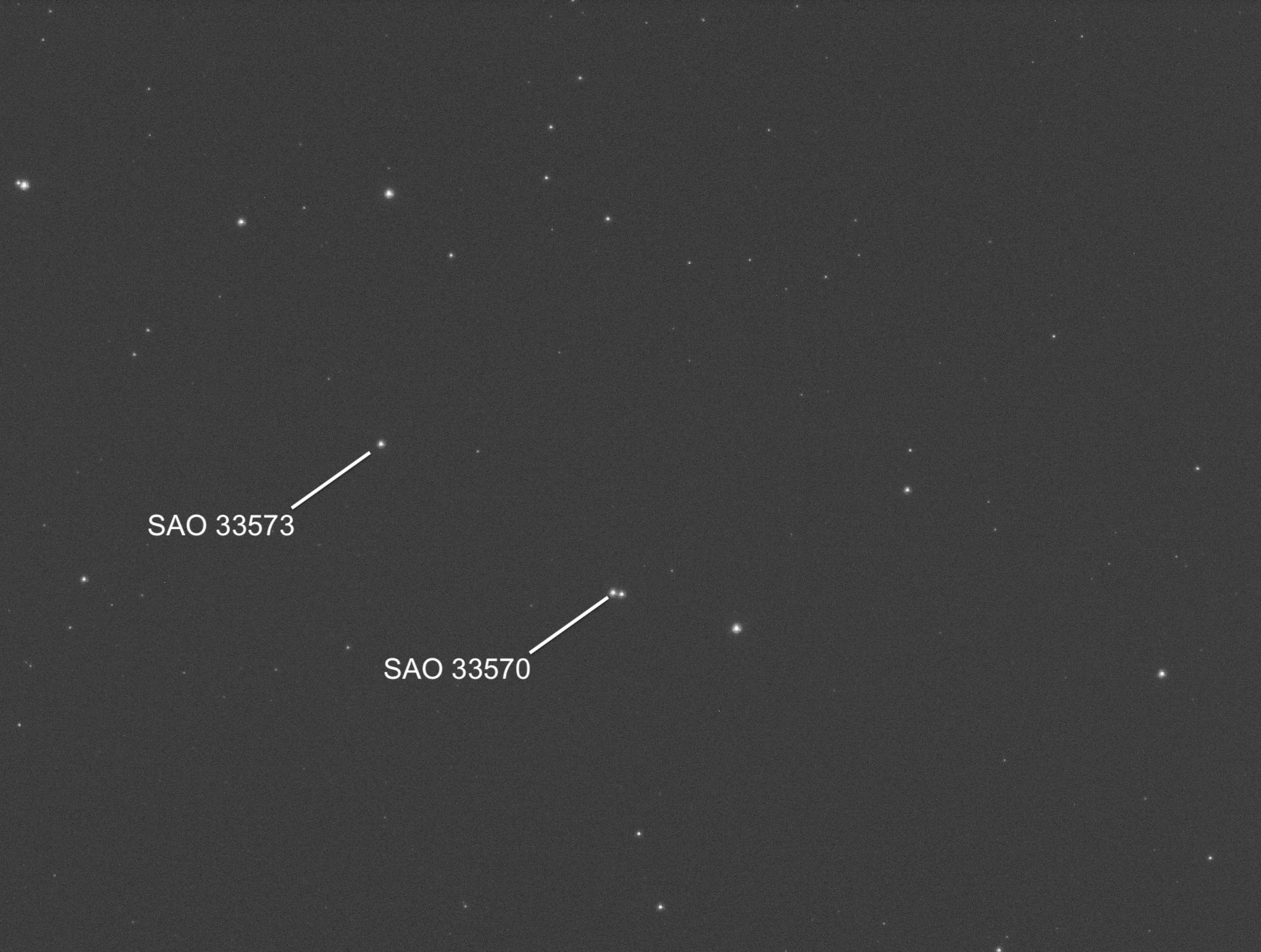

Unfortunately Sync and solve failed and landed up moving the scope to the wrong area, hence I missed the object when trying a longer exposure with the Ha filter. I need to reliably get sync and solve working to be able to use SGPro else I will have to go back to The Sky X that I have used before for image capture which I would prefer not to do given the flexibility of SGPro.
So I landed up pointing at a star UCAC4 739:73701 which was an offset frame from where I needed to be, the purple oblong representing the FoV of where I should have been and the UCAC star showing where I landed up.
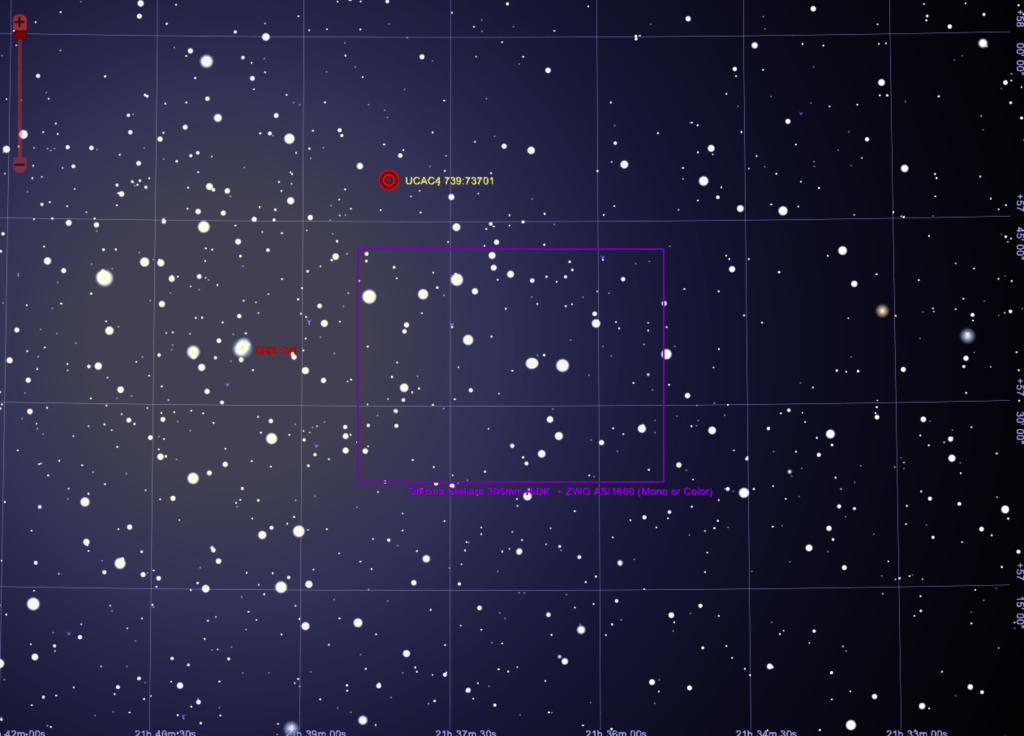
SGPro did error as mentioned during Sync and Solve as can be seen in the screen grab below. I will talk with GingerGeek to resolve.
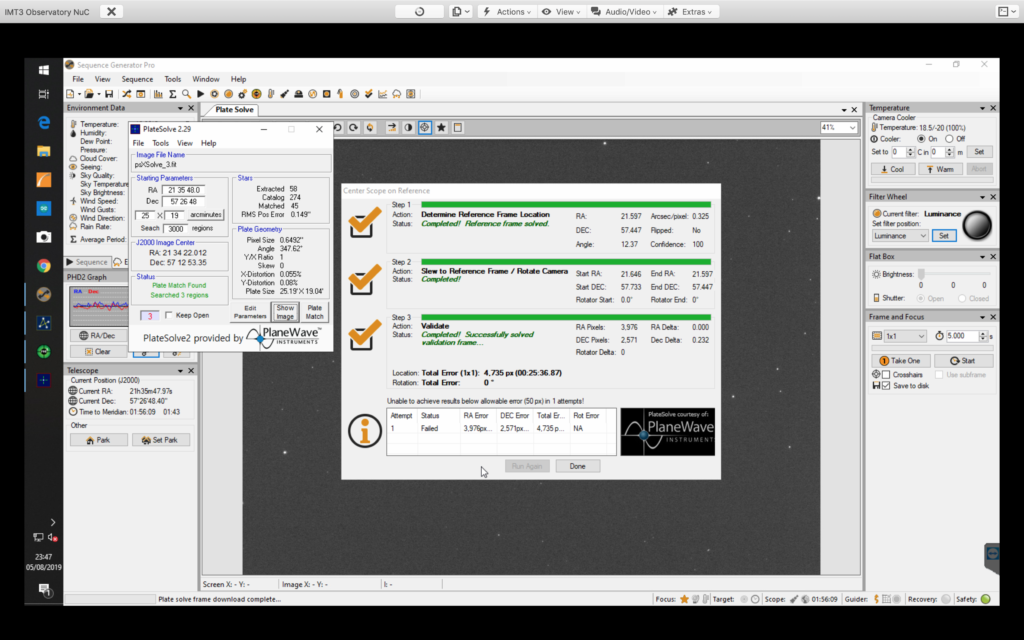
Viewing time period – 19:21 – 02:57
An unexpected clear spell this evening, I was sitting out on the patio looking at the clouds clearing and so setup the dome to perform the Periodic Error Correction (PEC) analysis for the mount.
To perform this I needed to unplug the hand controller for the MEII, unplug the ST4 guider cable, turn off a bunch of settings within the autoguider software with The SKY X (TSX) and also turn off TPoint.
I then connected the ZWO ASI1600MM to TSX rather than SGPro. This was so that I could record the log needed for the PEC through the autoguider add on software which records in a format that the PEC software requires. The challenge again was that I could not get the ZWO camera to connect in TSX. I just kept getting error 200. Searching TSX forum I finally found the issue and downloaded the latest driver from ZWO but through the link from Software Bisque. To install I needed to log in as Admin.
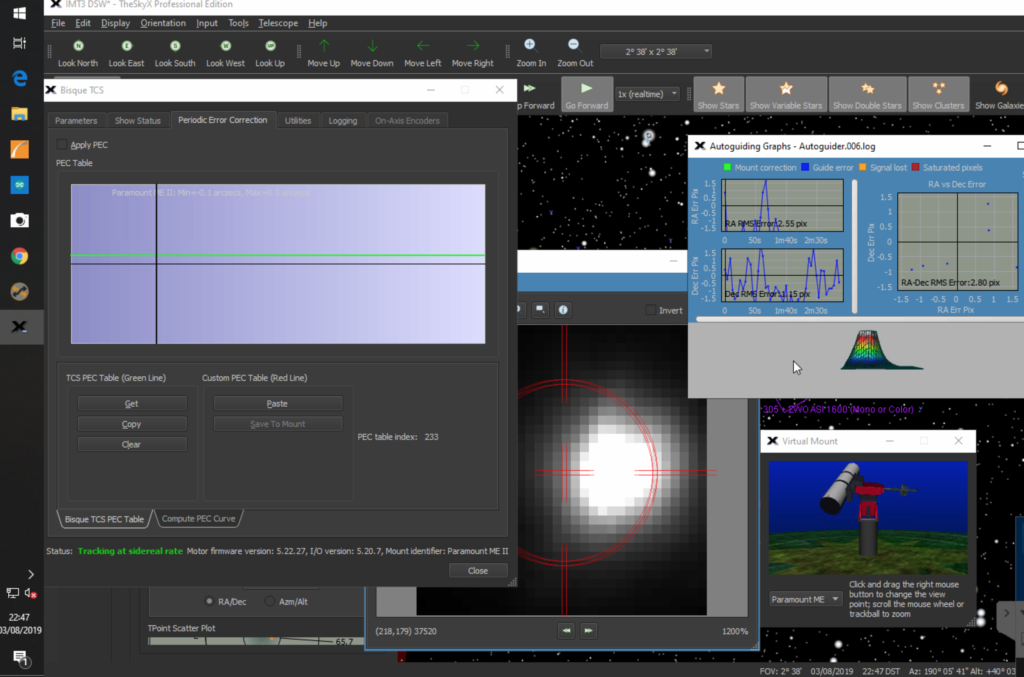
So I started to record the star movement without performing any guiding. Once done I imported the log file Autoguider.010.log into the PEC portion of TSX.
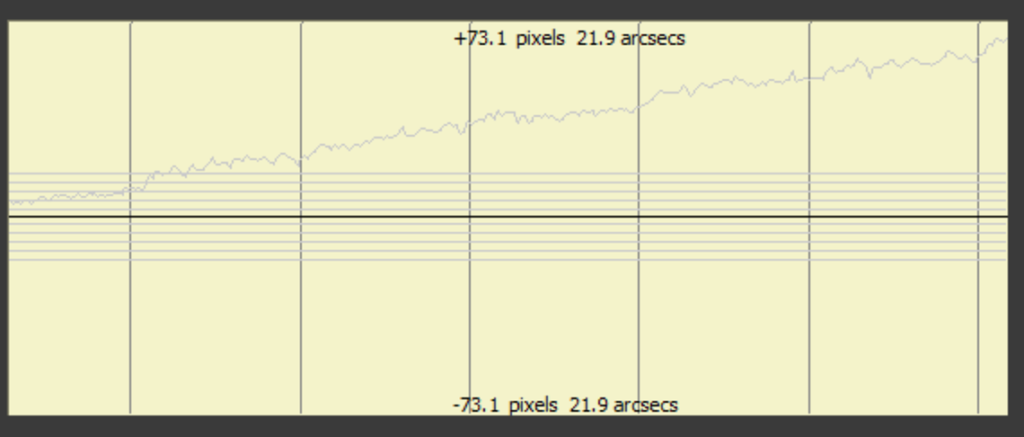
I then performed a fit so that you could see the sinusoidal waves before I then fitted the correction to it. A quick look using PHD2 Drift Alignment to see what the drift now was, was very promising with a sinusoidal wave over 10-15 minutes.
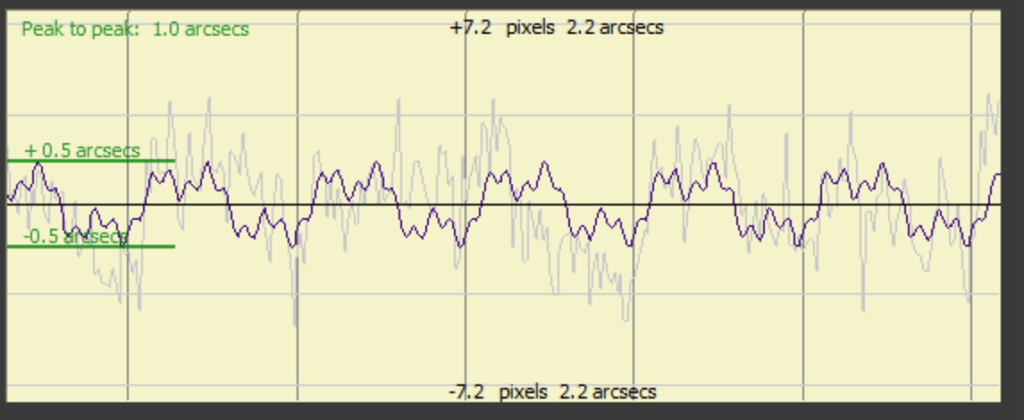
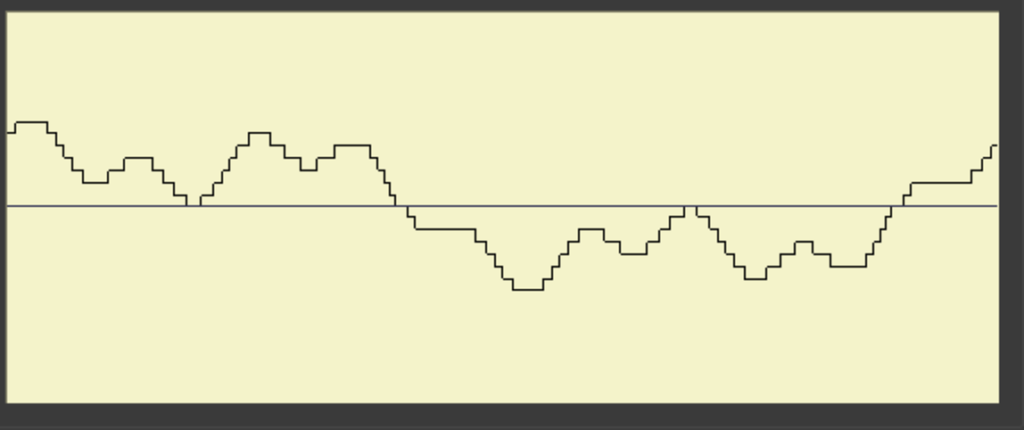

I then went off and tried to image unguided to see if it made a difference, it had, I recorded a 10min unguided image through the 12″ 2.5m focal length scope with no trailing of Altair.

I then attempted to slew and take an image of the Elephant Trunk in Ha again, however I was foiled by not only the cloud moving in but also not being able to get past the message Guider Settling. I need to talk through with GingerGeek to see why that is. Meanwhile bedtime for Mr Shave-Wall.

Viewing time period – 20:32 – 22:56
After several reboots by GingerGeek who is looking after the observatory I am now logged in. I currently have the dome open and the 12″ centred on Deneb that can be clearly see whilst the Sun is still above the horizon and thus not dark yet.
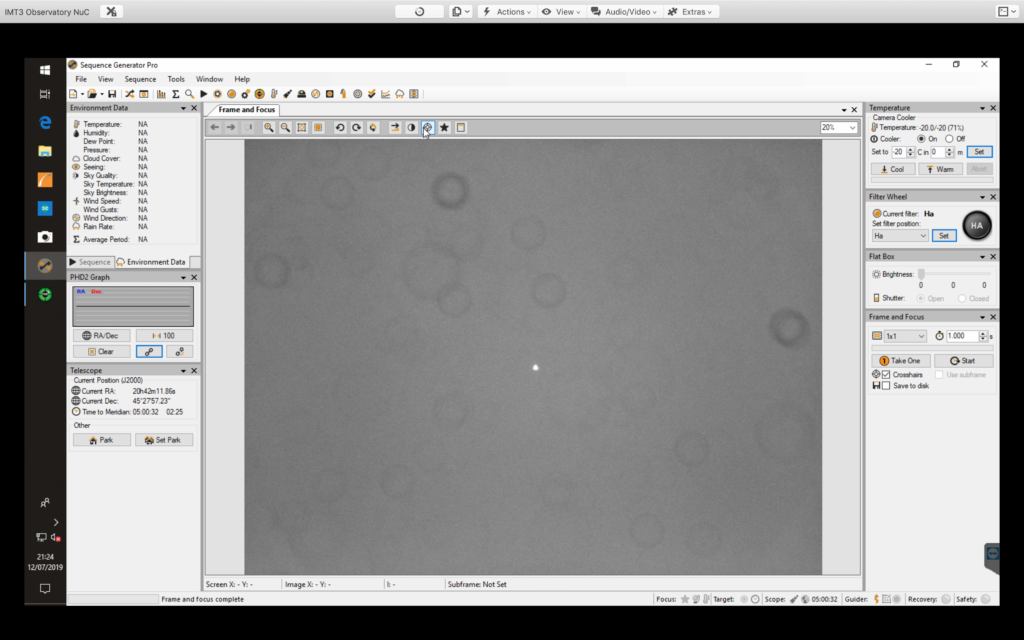
The rebooting is due to hanging of the NUC. We have had various problems, the external ASI120MC with ASICAP/SharpCap and Firecap seem to cause an issue, we have a problem rebooting and the NUC just powering off and today trying to login through Windows and it was just hung. So lots of niggles.
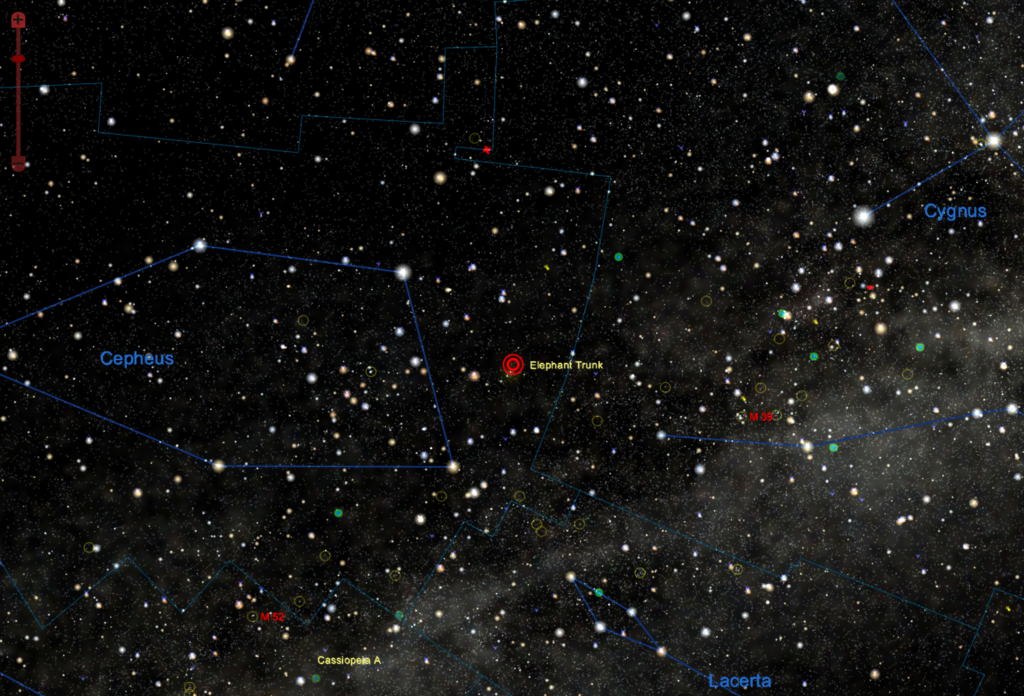
Tonight I hope to test a single Ha guided exposure on the Elephant Trunk nebula in Cepheus to the North East as it rises and will look to image from 11pm for a few frames before closing the dome for the night. I have already noticed that Deneb is drifting in my FoV so something is still amiss with the polar alignment event though I thought I had it cracked. I will make a note to go back and check it. Currently Deneb is +42 Alt and 66 deg in Azimuth. I think the key will be looking at where I pick the star for polar alignment and making sure I have truly tightened.
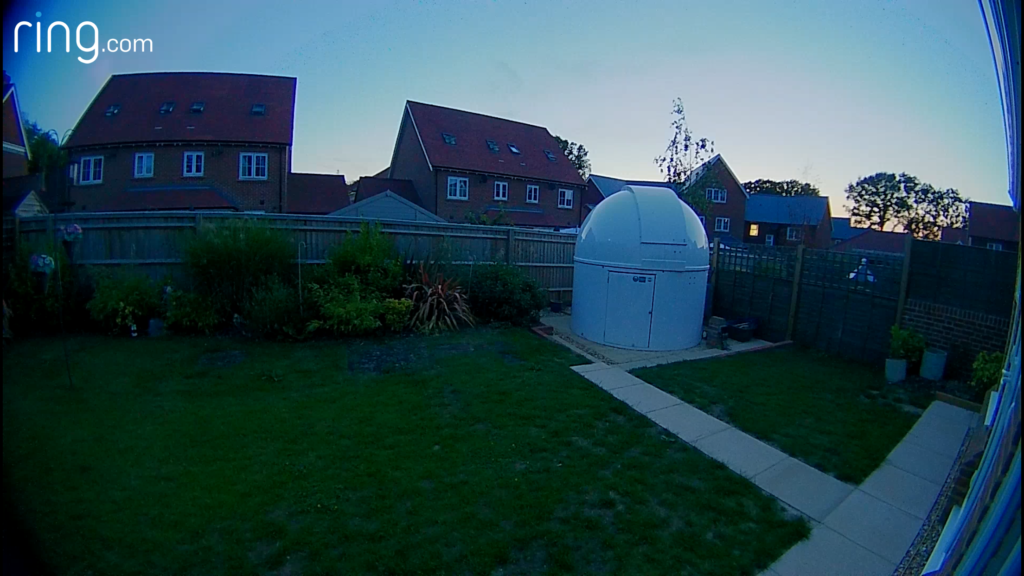
So now it is nearly 10pm the sky is getting darker. The strangest thing happened, the dome closed. I only noticed as the image was blank. I checked and the Hitec Weather Station had tripped and closed the Dome. I toggled the Relay and then I could open the dome. Interestingly if you try to open the dome from TheSkyX it tries then stops and resets to closed. For the moment given the clear skies and forecast I have disconnected the Hitec Weather Station software but will reconnect later. Something else to debug.
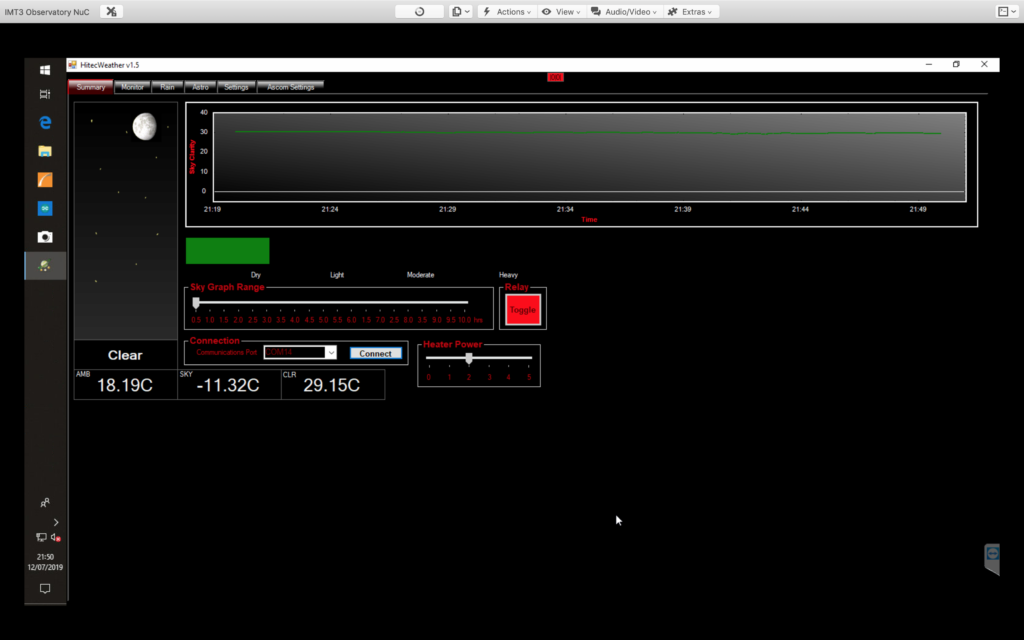
It’s now 22:21 and dark enough to focus, I spent some time getting the auto focus routine working in SGPro. Interestingly I had to set the step size to 1000 given the 100k steps my FLI focuser is capable of. I also increased the data points to 10 and this gave me enough movement and data to get a good V curve.
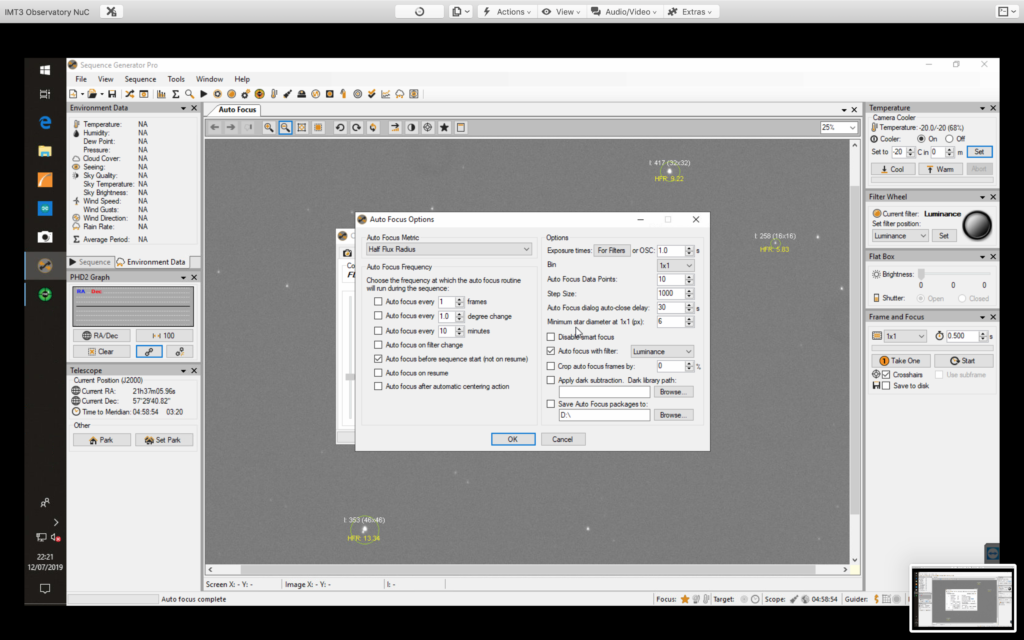
I managed to get down to an HFR of on average 6 tonight at focus point 71290. It took me 3 runs to get the right figures. I then made the changes under the 12″ profile within Profile Manager and saved them for future use.
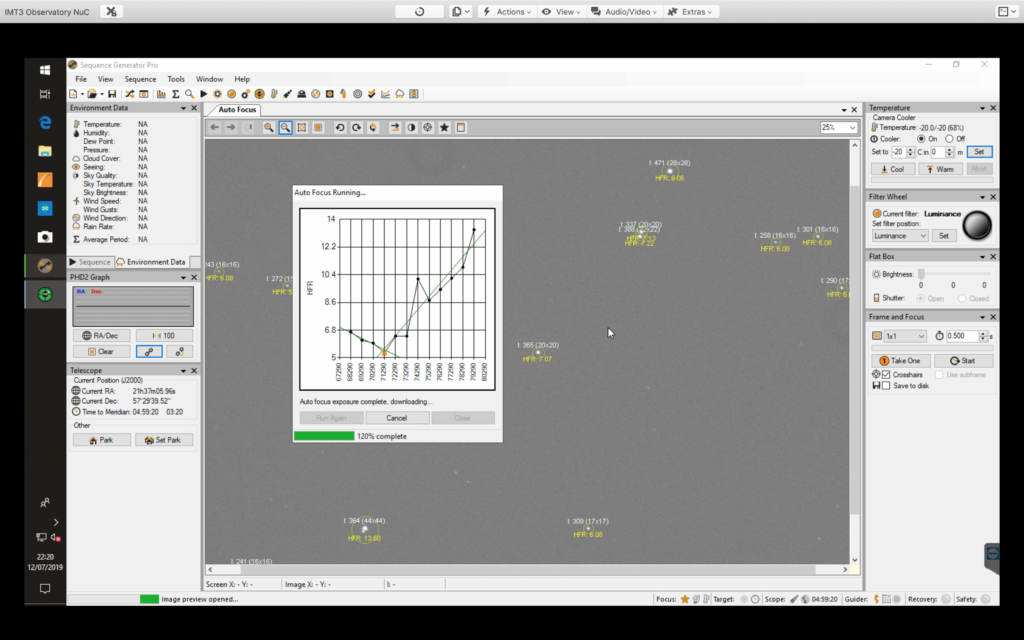
Next I moved on to PHD2 and guiding. Once I got an image I then found I only had hot pixels and no stars. I also had a funny cone of light and something large out of focus and the edge of the tube. I then remembered GingerGeek had fitted a new guard ring to the guider camera and inadvertently moved the position due to a loose screw elsewhere on the fitting. Thus I need to go and focus that the next night out as because I am not there tonight I cannot do this. This also means I am stuck for testing a guided exposure.
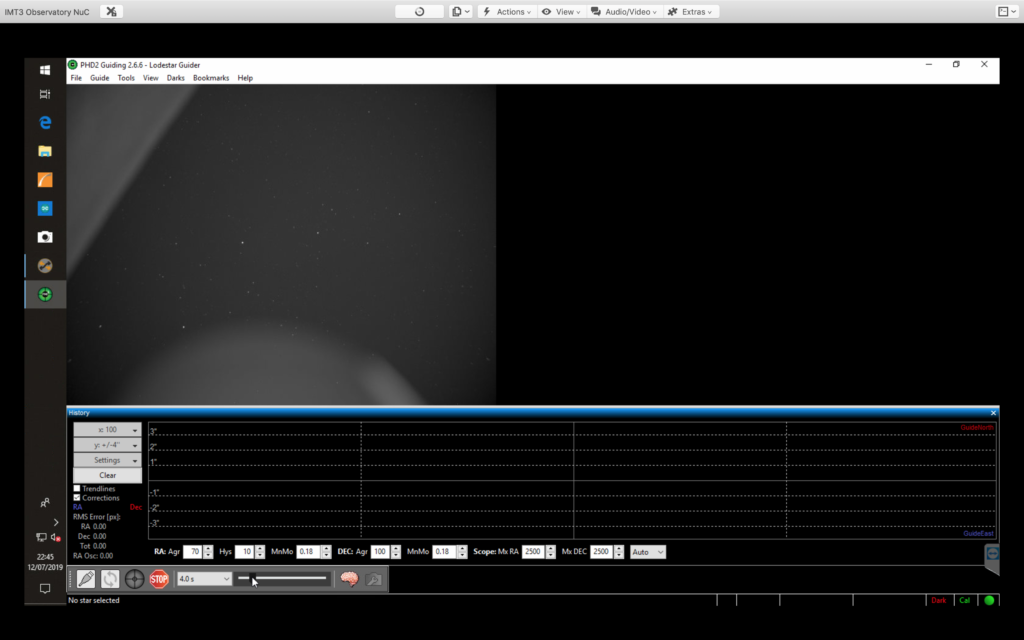
So instead I tried a few different exposures with the Ha filter unguided even though I knew I had the problem with polar alignment. I took exposures at 120 seconds and 180 seconds by which time I had trailing, given as I said I had polar aligned and could image for 10 minute exposures in a different part of the sky I need to redo the aspect. Note I did not perform a second autofocus on the Ha filter. I will at some point calibrate the offsets of the filters once I have the auto guider working.
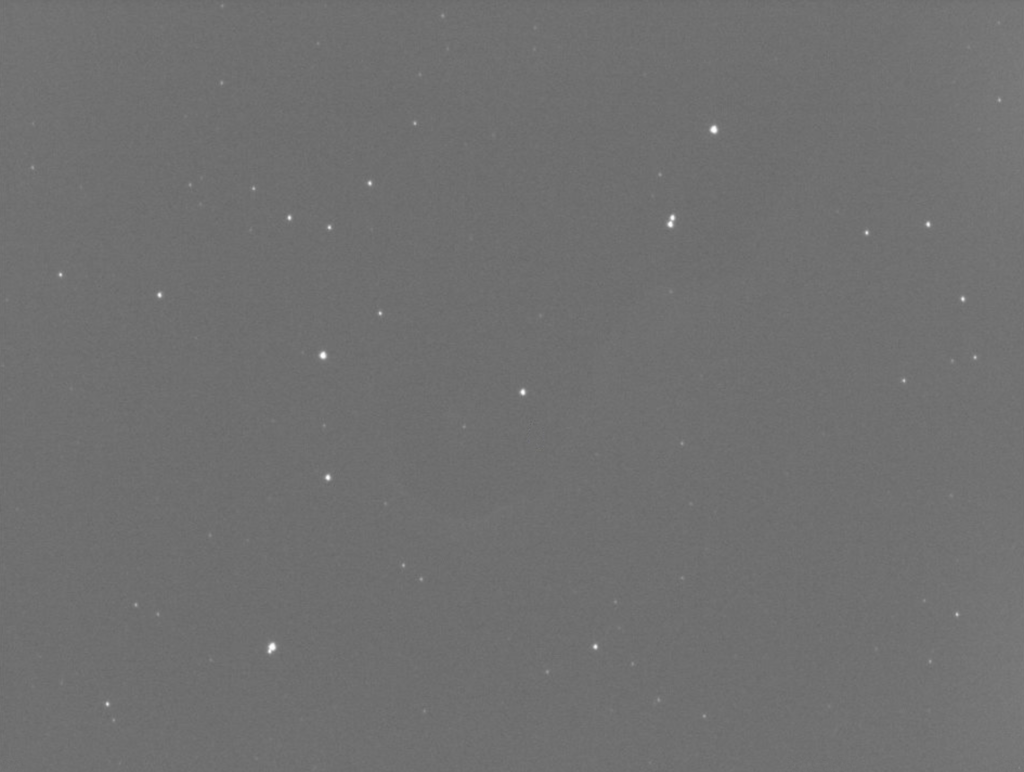
So at least a useful night to try and get a few things working, a few things to add to the ToDo list but all in all a good evening.